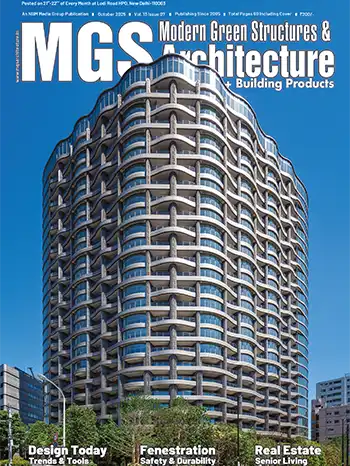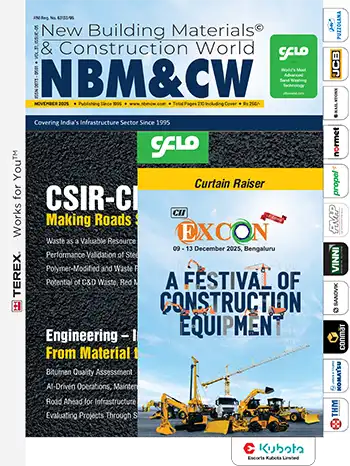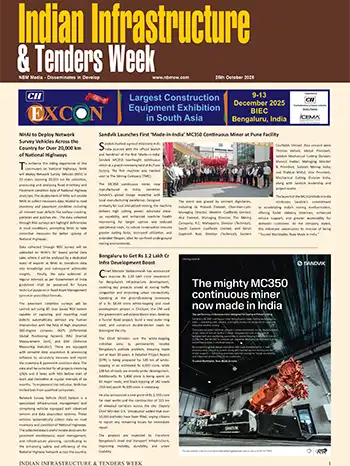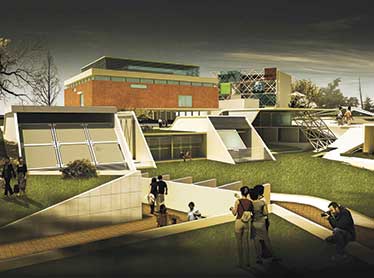
Revitalization of Le Corbusier’s Legacy Sanskar Kendra, Ahmedabad
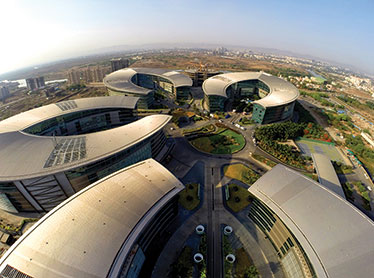
The Falling Lotus Blossoms EON IT Park
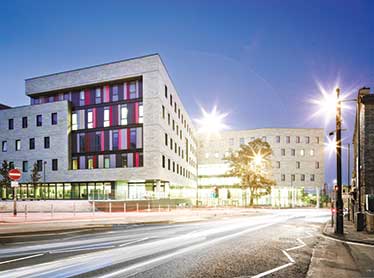
David Hockney Building, Bradford College, Bradford

Bond Bryan's design of the David Hockney Building responded to the client's call for a landmark building that would encourage and support innovative forms of teaching and learning. To deliver this and to provide long-term flexibility, a series of dynamic interlocking open floor plates were crafted within a simple exposed concrete frame. The result is a multi-level open plan collaborative heart-space for student-centred learning, with specialist cellular teaching zones at the perimeter. The building was officially opened in September 2014 and has since been a great success with students and staff alike.
| At a Glance | |
| Project: | David Hockney Building |
| Location: | Bradford, England |
| Architects: | Bond Bryan Architects |
| Contractor: | BAM Construction |
| Construction Value: | £36 million |
| Completion Date: | September 2014 |
| Gross Internal Floor Area: | 24,000 square metres |
| BREEAM Sustainability Rating: | Very Good |
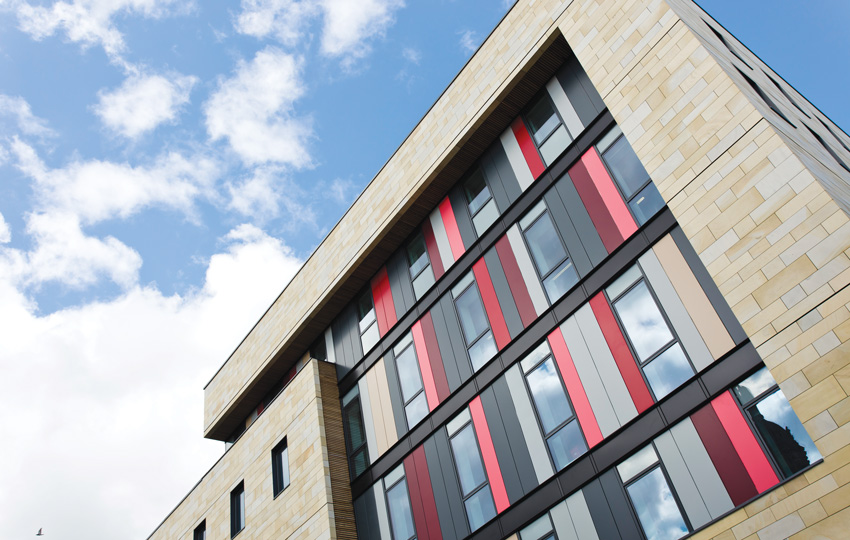
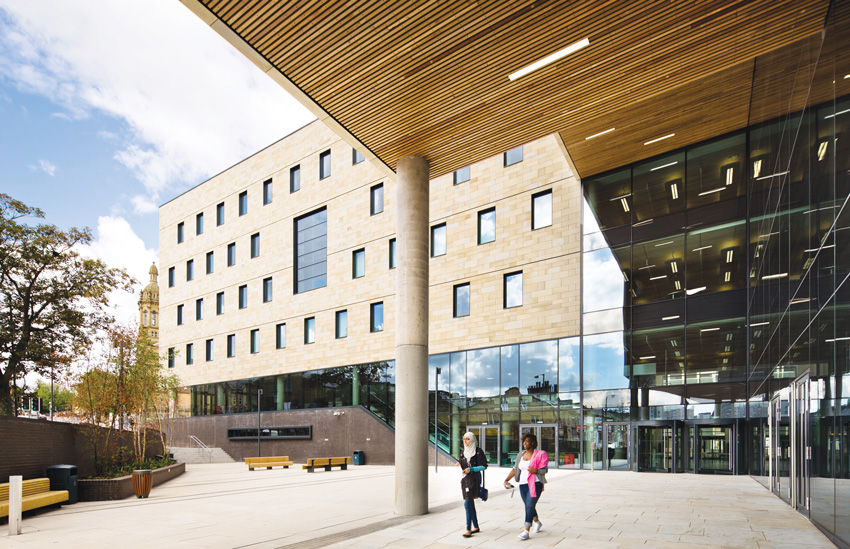
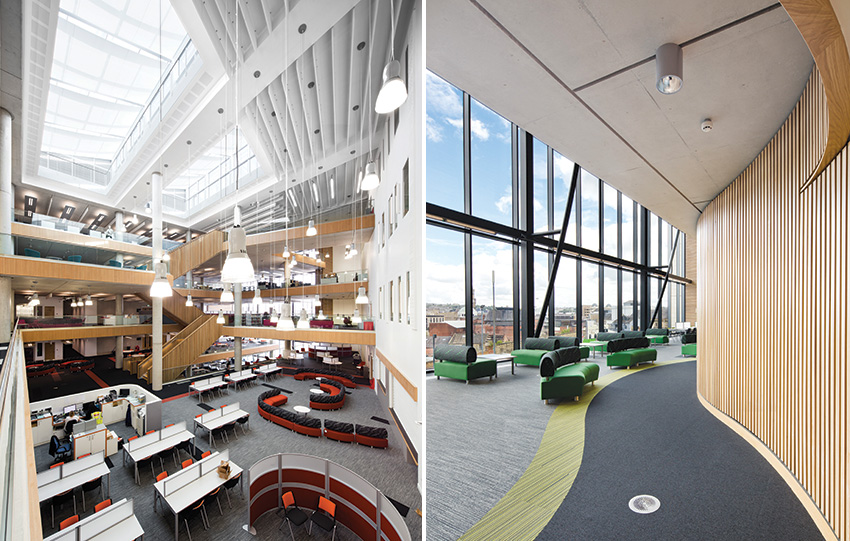
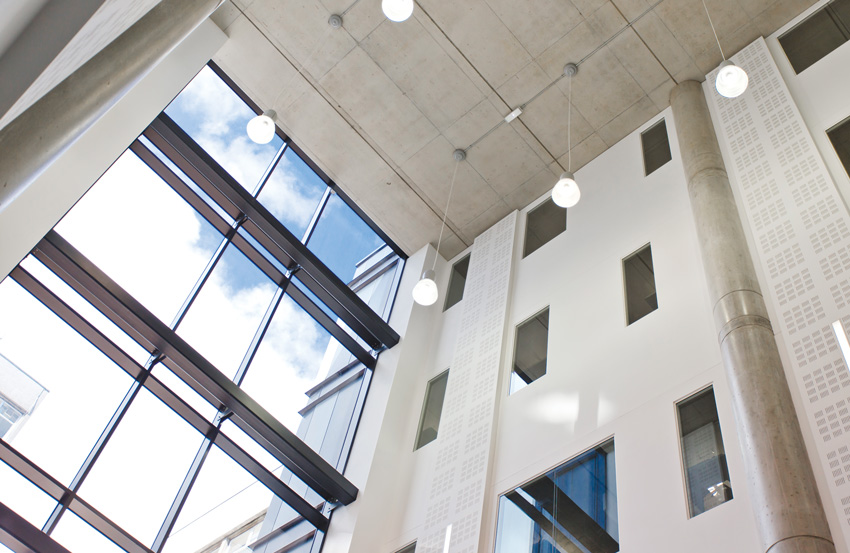
At 24,000 square metres and a construction value of £36 million, the project is outstanding value for money. This economy has been achieved via use of a simple geometry, use of repeating structural elements and a deep floor plan; roof lights and floor voids then provide natural light and ventilation at the centre of the building. Externally the building is clad in locally sourced robust natural sandstone. Neither quality nor vision was diluted due to a strong team approach; the project was actually enhanced by a collaborative approach to Value Engineering review, a process conducted with the support of the main contractor, BAM Construction.

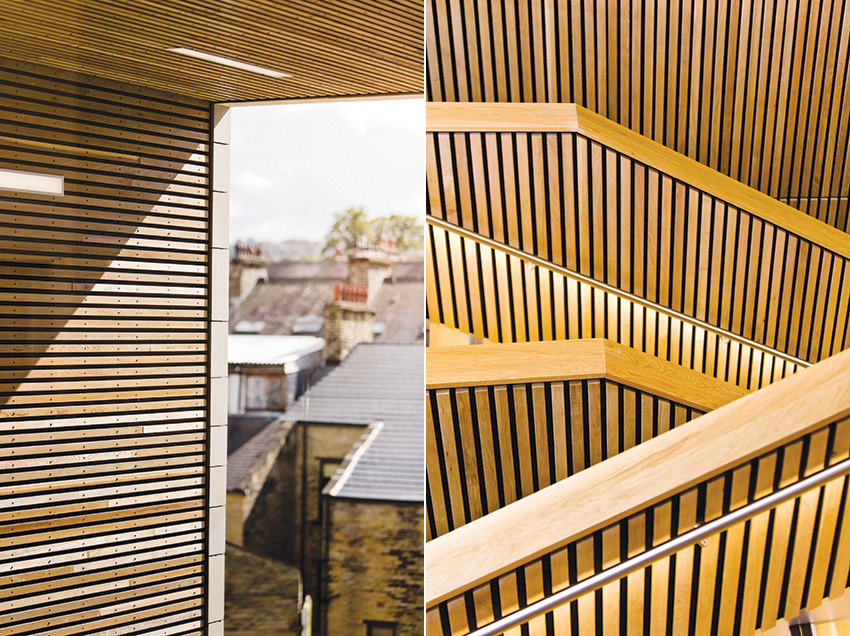
Bond Bryan Architects designed this new campus to suit 21st Century teaching methods, where the emphasis is no longer on a teacher-led 'chalk and talk' model, but rather on a learner-driven, project-based approach. This iconic building, named after famous Bradford College alumnus and internationally acclaimed artist, David Hockney has transformed the learner experience using new styles of learning, which embrace cutting edge technologies. Moreover, being designed with plenty of natural light provided both by the central atrium and the many external windows, this six-storey eco-friendly campus gives a light and airy feel.
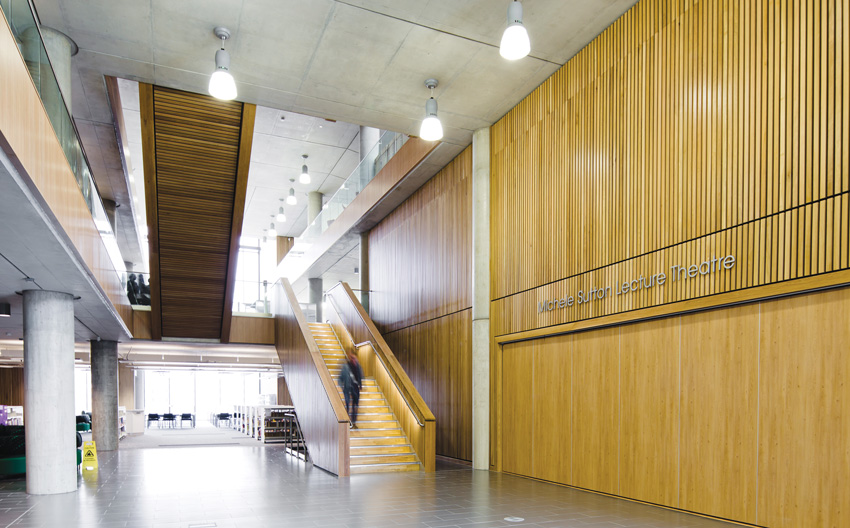
Located at the heart of the city, the project was designed with a pioneering digital approach using a three-dimensional virtual model created with GRAPHISOFT ARCHICAD, which together with the engineers' design information were then combined into a single model using Autodesk Navisworks. This is an early and highly successful exemplar of the combination of information from different software platforms. Bond Bryan resolved interoperability issues by working closely with the software vendors and main contractor, BAM Construct UK Ltd and as a result was commended under the title of "heroes of interoperability" in the building SMART 2014 global awards (SME category). GRAPHISOFT has since made the David Hockney project their "signature building" for the global release of ARCHICAD 19.
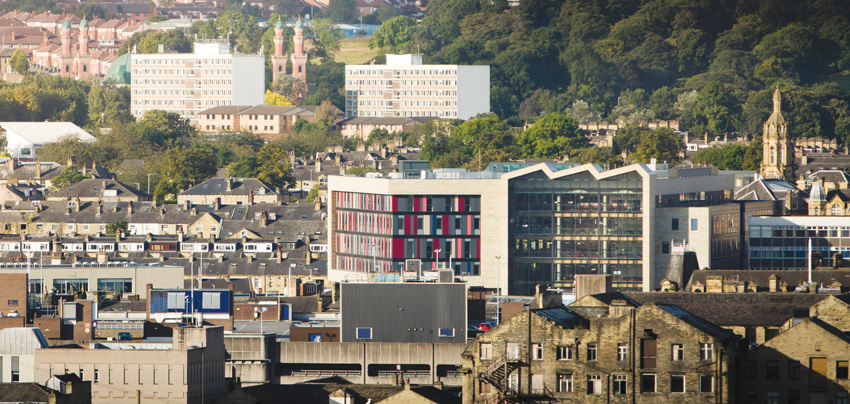
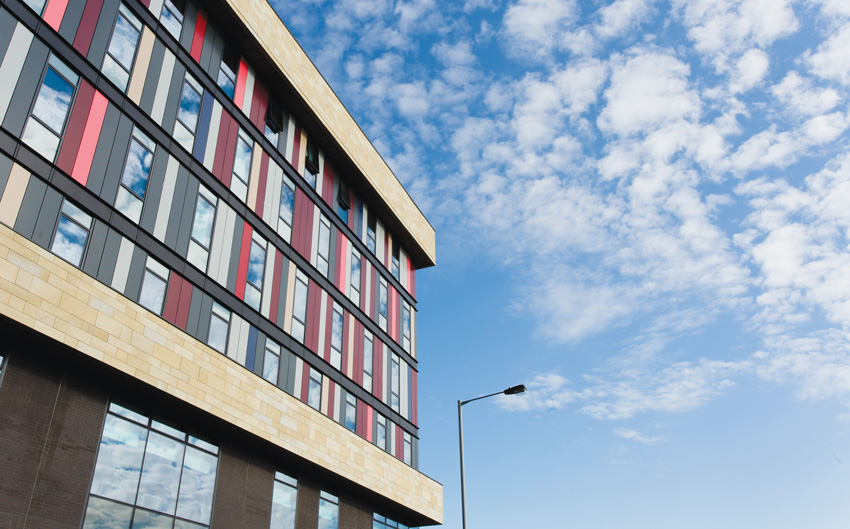
Apart from this, the stunning architecture has been shortlisted for a number of prestigious construction awards. Most recently Matt Hutton, Associate Director, Bond Bryan who is responsible for the design and delivery of the David Hockney Building, picked up the Local Authority Building Control (LABC) Building Excellence Award in the education category. Besides, the campus has been nominated for the category Best BIM Project - Bradford College and Beyond: Open BIM R&D in the BIM4SME Awards, run in conjunction with the Royal Institution of Chartered Surveyors (RICS). It has also been shortlisted for the Concrete Society Awards 2015 and announced as a finalists for the Construction News Awards 2015 in the 'BIM Initiative of the Year' category.
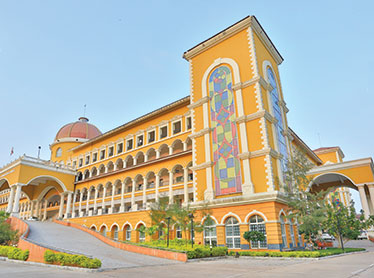
District Headquarters of South Goa Collectorate

Vision
District Headquarters of South Goa Collectorate is a building that 'belongs', to the region and to the site being rooted in the regional & cultural milieu. The building is climatically responsive and environmentally sensitive. 'Timelessness' is a universal quality in architecture and this project exemplifies this infitude.Located majestically along the NH-17, the architectural spatial experience of this building innovates, explores & experiments with the use of magnificent arches and majestic dome as elements of form, representative of awe & grandeur that this seat of power needs to portray. Weaving in modern technology, it is a paperless set up with computer networking at every desk.
"A state-of-the-art Collectorate, rooted in its past, standing in the present and futuristic in its planning is what we produced," says Ar. Rajiv Khanna.
| Fact File: | |
| Project: | District Headquarters of South Goa Collectorate |
| Location: | Margao, Goa |
| Architect: | Studio KIA, Gurgaon |
| Site Area: | 30,375 sqm. ( 7.5 acres) |
| Built Up Area: | Over 4 lac sq. ft. |
| Project Status: | Completed Feb 2013 |
| Client: | Goa State Infrastructure Development Corporation Ltd. (GSIDC) |
| Design Team: | Rajiv Khanna, Sabeena Khanna & Umang Garg |
| Text: | Ar. Himani Ahuja |
The vision was to create a one-of- its- kind model in the country which each state would want to emulate. The design brief highlighted on developing a system of paper less work in a typical government office and has an I.T enabled building with a computer at every desk. It was conceptualized to complement and enhance the working spirit of every Indian government official.
Planning Key Areas
The plan for District Headquarters has been carved from the architect's inception of intelligent planning, efficient zoning and sustainable building strategies. The Collectorate building has a built up area of nearly 4,00,000 sq.ft across 6 floors. It houses various departments and facilities for public convenience.The incorporation of deep corridors and open windows all around was done to make the public spaces conducive to the local humid & wet climate, thereby adding a realm of relief and a unique dialogue between open and built. The façade creates an impression crowned with a central dome. The imposing dome, the extravagant porches, grand steps and coloured vertical glazing accentuates the stature and grandeur of the built form. The colored glazing which is contemporary in design yet vernacular in appeal is an emulation of the stained glass windows which are integral to Goa.
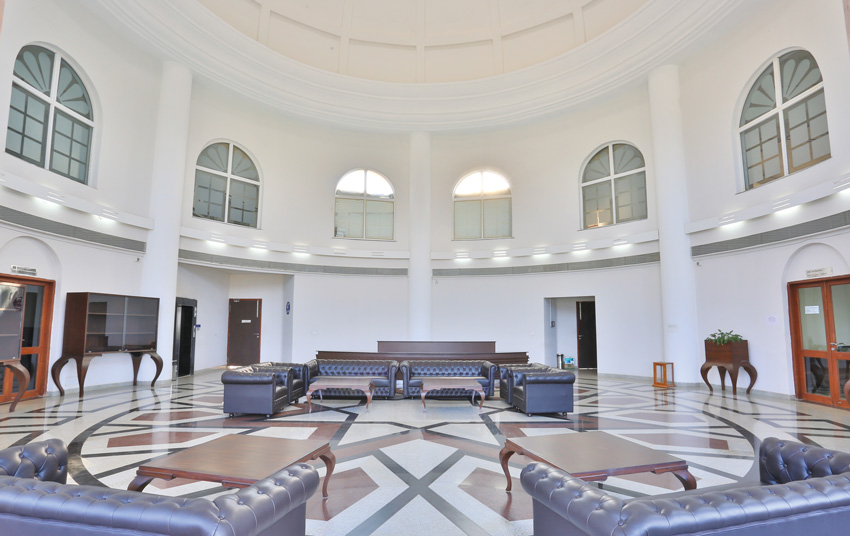
Design Strategies & Design Details
Form follows Function is an old paradigm and in this building form and function co-exist. The planning function desired the segregation of public movement and staff circulation at the horizontal plane yet has vertical connectivity which has been beautifully achieved by creating internal and external corridors for independent, designated circulation yet essaying the Iconic identity of the building.A serious emphasis has been made to reinterpret Goa's vernacular architectural language by overlaying it with Portuguese Urbanism. The built form has been developed keeping into account the active and passive design strategies. Aligned on the true north-south axis, the access points into the building have been sited on the four cardinal points composing themselves through the grand porches.

The four corners, like the four 'stambhas' or the cosmic columns are the vertical circulation cores of the building, depicting the bond between earth and the heaven. The north end of the site has a large Parade ground for formal government functions.
The stately dome or the 'chhatra' is the embodiment of kingship and is symbolic of a blessing. It is the most important area of the building and in this case it encases the V.I.P. lobby which opens onto a grand porch terrace having the flag hoist.

All apertures in the façade are highlighted with white frames against the deep yellow façade conjuring the old perspective of Portuguese architecture. The building looks breathtakingly beautiful in the evening when the façade is lit up. The extents of the site with extensive landscape complete the overall design. The landscaped courtyards serve as the breathing zones which infuse fresh life into the building. The elevation braces the structure & defines each element in detail. It is designed to unambiguously communicate efficiency, control & manifest cultural ethics.
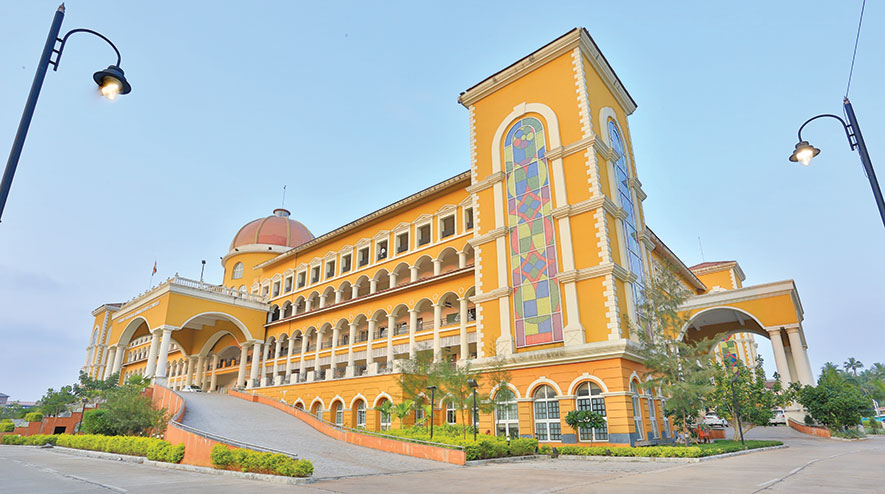
"The building stands testimony to the administrative function, providing a whole new dimension to it."
District Headquarters building is a climatically suited building with deep overhangs & corridors with central landscaped courtyards for air circulation & spaces emphasizing on cross ventilation. Energy efficient lighting has been adhered to as well with large openings for natural light.
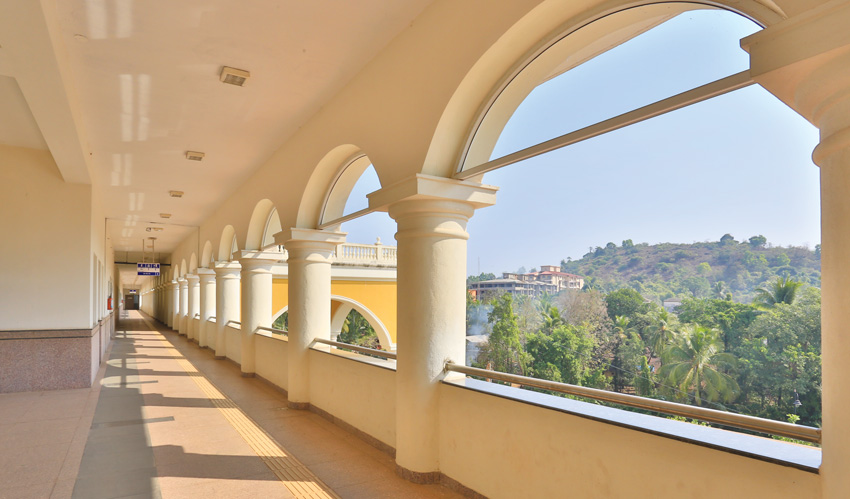
The building is not only climatically suited but is also functionally disabled friendly where all the accesses are defined and easily accessible. Public convenience has been one of the prominent features of the project. Provision of tactile on the floor (blind paths), handicapped-user-friendly restrooms, ramps with handrails have been incorporated in the structure. Public dealing counters for active interaction and facilities such as Citizens Facilitation Centre and Senior Citizens room have also been weaved in the exemplary design of the structure.
| Scope of work/Products | Company name |
| Audio Visual and IP Telephony : | M/s. Siemens Enterprises Communication Pvt. Ltd. |
| Woodwork : | M/s. Concept Creator |
| Modular furniture : | 3M/s. Durian Industries Ltd. |
| Decorative glazing : | M/s. R. S. Lawande |
| Landscaping : | M/s. Vrindavan Agricultural Services |
| Elevators : | M/s. Thyssenkrupp Elevator (I) Pvt. Ltd. |
| Light fixtures & Switchgear : | Crompton greaves & Schneider |
| AC equipment : | Blue star |
| False ceiling tiles : | Saint Gobain |
Structure & Materials
RCC frame structure with brick infill walls in the superstructure is supplemented with local Laterite stone in the sub soil structure and boundary wall.Plastered finish in the typical Goan colors & character along with the traditional cast iron railings, Mangalore tile roofing and stained glass glazing completes the Portuguese character.
Easy to maintain stone & tile floorings indoors, non skid floorings in weather-exposed areas and marble flooring in VIP areas have been used. Grass pavers in parking / landscaped areas and concrete road owing to heavy rains in the region have been laid.
Sliding UPVC windows, best suited for the humid and windy climate, have been used so that no open, hinged shutter can hurt anyone in this public building. Tremendous emphasis has been laid on making the building as people friendly and safe as possible.
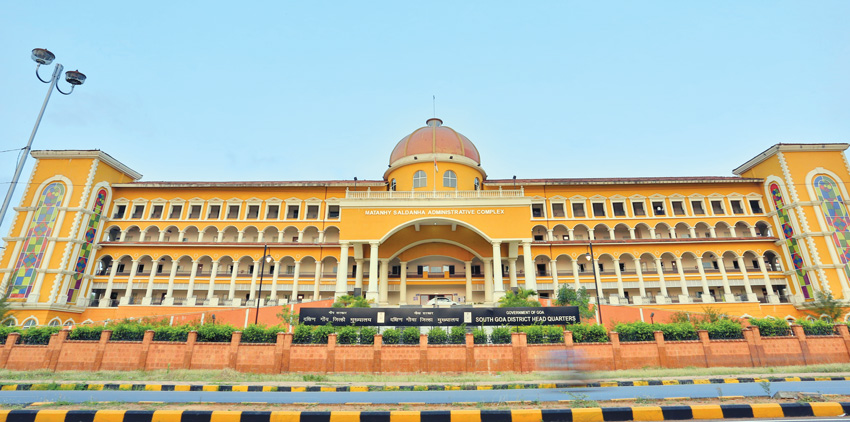
Material consumption
21,000 cu.m. of concrete, 3000 tons of steel and 2,50,000 bags of cement was consumed during the construction of this building. 3,00,000 liters of water storage is provided as well.A majestic building showcasing various strands of Goan-portuguese architecture amalgamates with the character of its vicinity and yet stands out because of its futuristic offerings. The District Headquarters building defines Goa's architecture creating a statement of belonging.
An iconic structure has risen for Goa which provides a whole new identity to the place and has established itself as a place of pride!
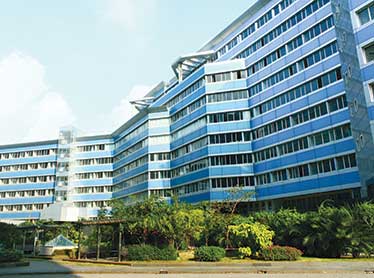
Bharat Diamond Bourse, Mumbai

| Location: | Bandra-Kurla Complex, Mumbai |
| Type: | Institutional |
| Scope: | Architecture + Master Planning |
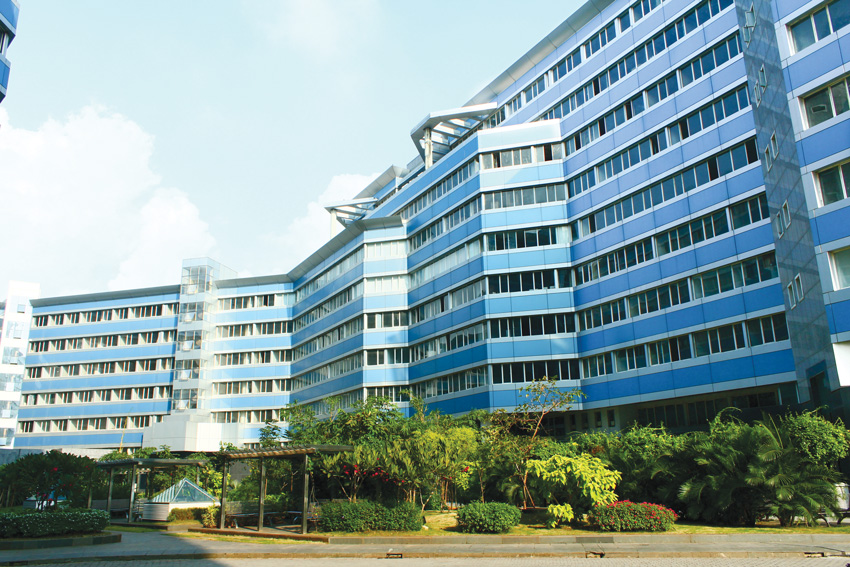
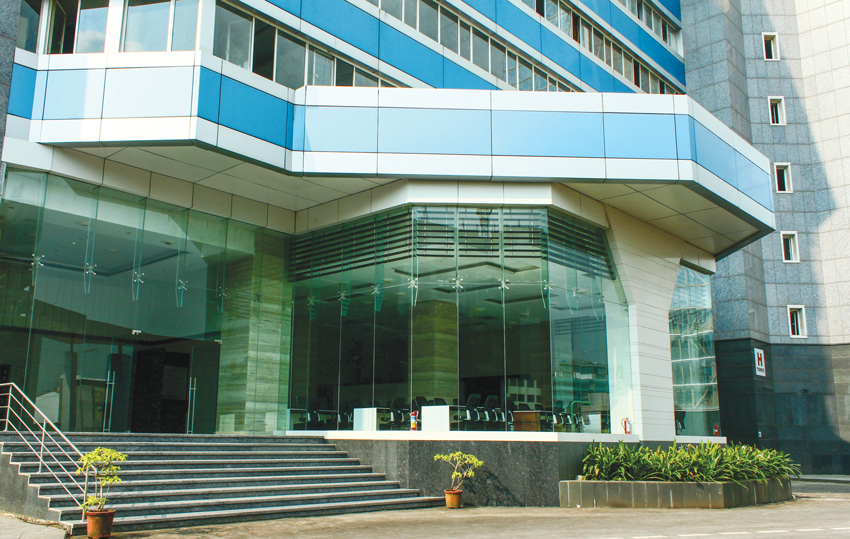
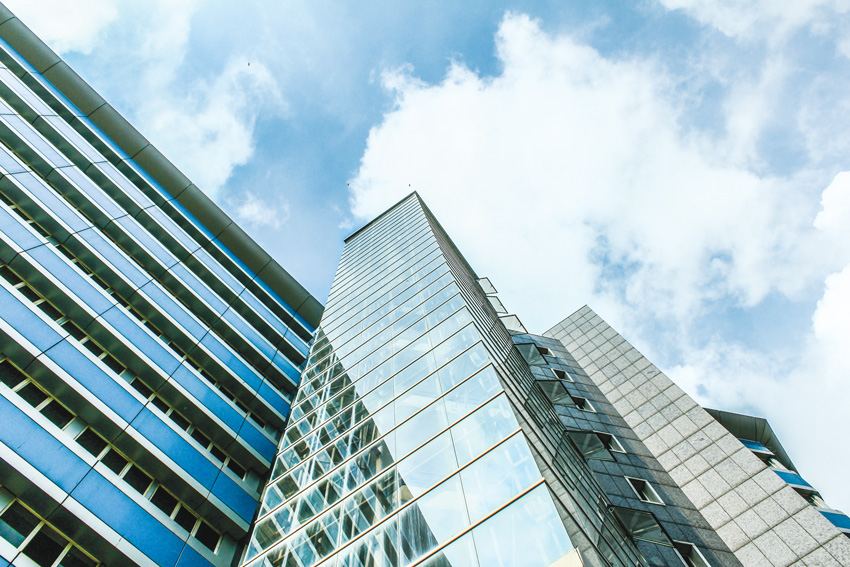
The project needed to be revamped considering the revised utility requirements, which involved detailed site analysis of the existing structure and studying the previous drawings. As it was not possible to make major structural changes, it was decided to adopt less radical approaches based on transforming existing components and working within the parameters of conventional yet modern methods of transforming the buildings. The concept was to project a modern structure breaking the monotony of the façade and lightening the building both in physical weight as well as in visual presence. The highlighting feature of the otherwise flat institutional structure is the thick blue band on the exterior ACP façade. Keeping in mind that the workers require as much maximum light as possible while sorting or cutting diamonds, the buildings' design includes wide windows. The total window area is 300,000 sq ft with special non-reflective glass windows.
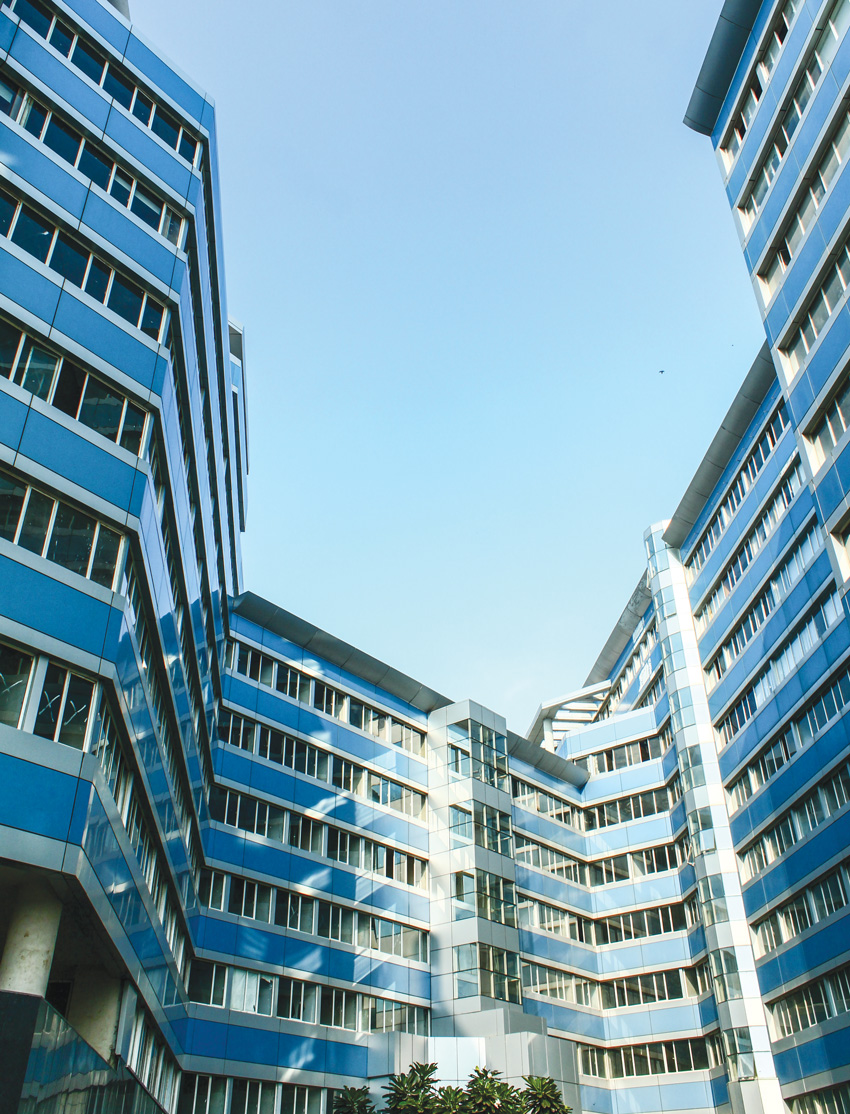
Spread over 20 acres, the Bharat Diamond Bourse consists of a total of 8 towers, each scaling 9 storey tall. The total constructed area is 2,000,000 sqft, with an addition of 1,000,000 sqft basement area with a car park for roughly 1800 cars. While the existing towers were handled individually and also as a master layout, each component in the towers was studied in detail before applying any proposed changes. The existing towers had lots of offsets in the façade in terms of cut outs at various levels as per the old scheme. Major structural works were required to fill these gaps and make the elevation simple. The new tower was also designed on the same lines but simpler in form.
Bharat Diamond Bourse is home to about 2,500 small and large diamond traders in addition to the custom house, banks and other service providers who cater to the gems and jewelry trade. BDB handles over 60% of diamond exports from India, with an inflow of approximately 20,000 – 30,000 people daily. Traffic movement of the entire complex was designed accounting for a daily traffic of 50,000 individuals and considering the existing entry exists in the basements, security issues, class and variety of people entering and exiting the complex at venous hours.
"There were many limitations and parameters amidst a brief that was not always final, but I think we did a great job," says ARK. Work finally finished in 2011, and today Bharat Diamond Bourse is resplendent for its clear glass façade.

96 Iconic Tower, Colombo
| Project at a Glance | |
| Type: | Mixed Use |
| Height: | 342 meters |
| Location: | Colombo, Sri Lanka |
| Scope: | Architecture + Interiors + Master Planning |
Designed by ARK, 96 Iconic Tower is an engineering marvel, dedicated to the Sri Lankan Victory in the 1996 Cricket World Cup.
Located at Colombo, the building facade is designed with a ball balanced between four bats to commemorate the achievements of the Sri Lankan cricketers with signature residential along with Indoor Cricket Facility, Hall of Fame, Museum, observatory and Specialty Revolving Restaurant. The mixed-use project is an amalgamation of residential units with retail outlets and public space.
The project will be constructed in a joint venture between Wills Realtors (Private) Limited and the Shreepati's Edifice (Private) Limited, and is slated to be completed by 2019.
Structural Design
As the name suggests, the tower is 96 storeyed, with varied spaces such as the Basement Level--a covered parking lot which houses the lift lobby for commercial floors, theatre and the restaurant. The Lower Ground Level is also a covered parking lot with a vehicular drop off point on the South side of the tower, and the ticket counter for the 360° Observatory (Level 92) and Sri Lankan Cricket Legends Museum (Level 93).Retail outlets spread over an area of 4483 sq. m on the Ground Level, along with an entrance lobby on the East side for the restaurant, theatre, and escalators going down to the 360° Observatory Ticket Counter. On the North side of the plot, a ramp and a stairway lead to a 4.5m level that acts as a separate entry for the residents. The lobby consists of 4 elevators for the residents and 2 elevators for domestic help, leading to the residential lobby (Level 6). A 10m wide vehicular ramp leads the residents to the parking levels (Level 6 to Level 12).
Level 1 to Level 3 consists of retail outlets that spread over an area of 3783 sq. m. 6 elevators cater to the retail and theatre levels. 18 escalators provide smooth circulation in the retail area. Level 3 hosts the 360° Observatory exit.
A 6 screen multiplex with a seating capacity of 1420 people is spread across Level 4. Separate elevators are provided for the night show exit. Level 5 is allocated commercial spaces for office use with four offices of 770 sq. m each. Level 6 is a covered parking for the residents with vehicular drop off point and the residential lobby. The level hosts 9 elevators for residents and their guests, and 3 elevators in the service core for domestic helpers.
Residents parking is located between Level 7 to Level 12. Level 13, 20, 35, 50, 65, 78, 91 are designed as service floor with meter rooms, break-pressure tanks, and pumps. The entertainment deck with an up-to-date library, indoor games, swimming pool, business center, jogging track, toddler's area, and outdoor play area, are situated on Level 14. Level 15 to Level 49 host 8 residential apartments per floor of either 3 BHK or 4 BHK. Level 51 to Level 64 host 8 residential apartments per floor of 4BHK.
The entertainment deck with lounge and coffee shop, gymnasium, spa, out-doors yoga and a sky deck is situated on Level 66. Level 67 to Level 90 host 4 residential penthouse apartments of 4 BHK. The 360° Observatory, open to non-residents, is located on Level 92. Level 93 hosts the Sri Lankan Cricket Legends Museum. Level 94 and Level 95 hosts, a revolving restaurant offering a panoramic view of the city of Colombo. An Indoor Cricket Training Academy is located on Level 96.
Despite the various uses and users stacked vertically, each has been provided individual and independent functioning. Designated parking areas, different access elevators and lobbies, and independent services ensure minimal overall between the different users. The 96 Iconic Tower has a total of 34 elevators, including two double-decker elevators for the observatory. The elevator speeds vary from 4m/s to 8 m/s.
Green Elements
The architectural firm ARK believes that the infrastructure of a high-rise should enable it to be self-sufficient in terms of its basic energy requirements. The idea behind using alternate energy sources is to make the project self-sustainable. In fact, in case the structure is capable to generate additional units, the advantage can be passed on to the smaller establishments in the vicinity or to the grid itself. Wind turbines have been incorporated and the glass dome that houses the indoor cricket academy has photovoltaic cells which also generate electricity. The multi-storey parking façade and natural atmospheric pressure are to be used to lower the temperature of the water for the air-conditioning plant instead of using large fans.
Backed by the Sri Lankan government, 96 Iconic Tower designed by ARK promises to be a landmark structure standing tall in Colombo's skyline.
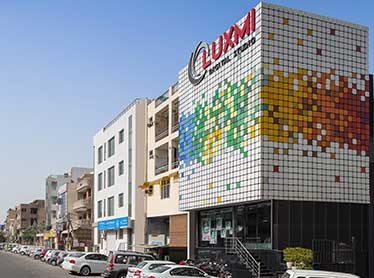
‘Pixels’ The Digital Studio
| At a Glance | |
| Project: | ‘Pixels’ -The Digital Studio |
| Location: | New Delhi |
| Architecture Firm: | Plan loci |
| Design Team: | Vikas Gandhi, Gauri S Gandhi, Rajan Grover and Anil Bhaskar |
| Client: | LUXMI Digital Studio |
| Photo Courtesy: | Andre J Fanthome |
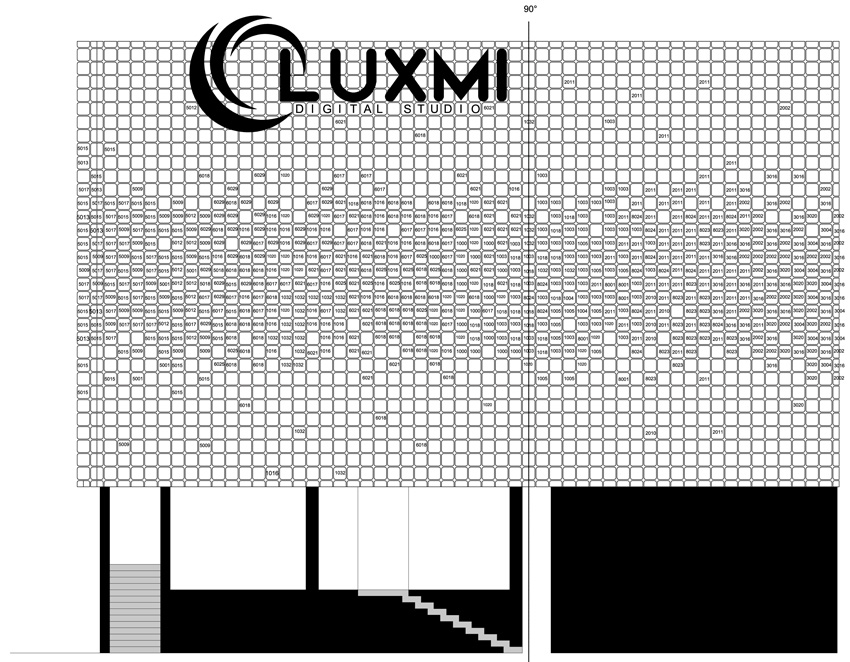
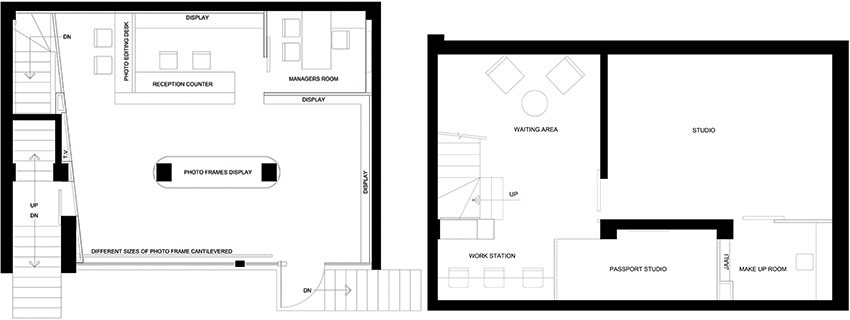
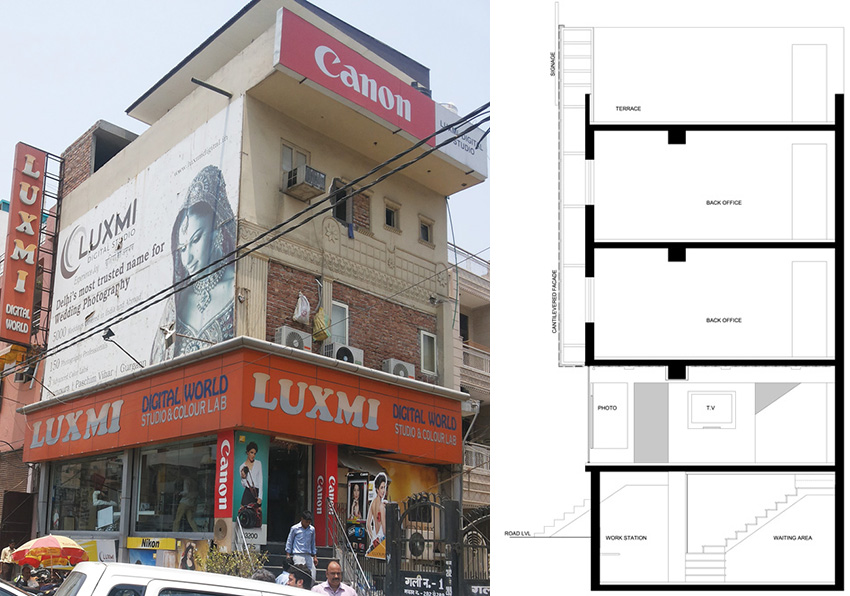
As the digital studio 'LUXMI' grew over the years along with the clients business, more and more functions were attached to the existing built form in an unplanned manner, making it increasingly unorganized. The client approached plan loci to assess their needs and refurbish the retail part of the digital studio which comprised the ground floor and the basement. Along with this, the facade was to be redone to communicate the popular stature that the studio had achieved.
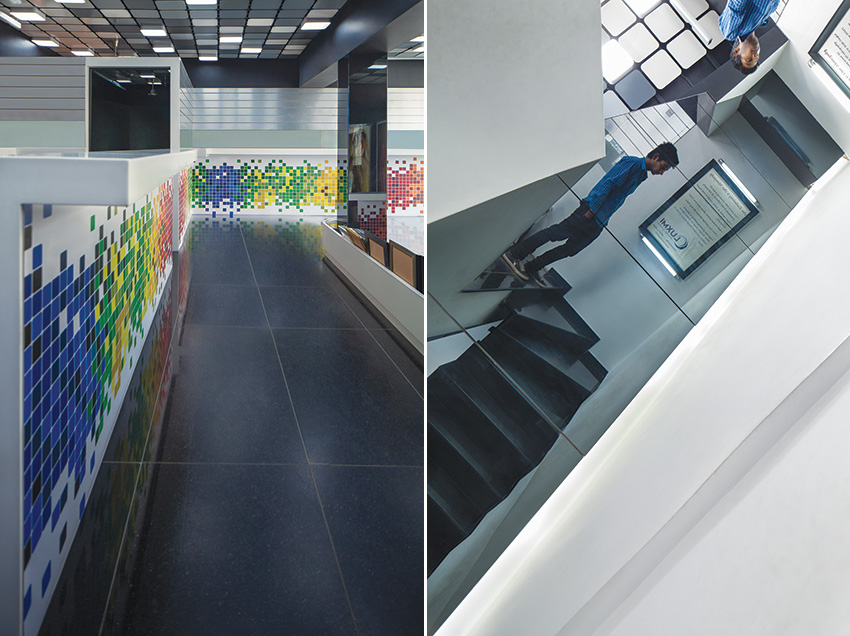
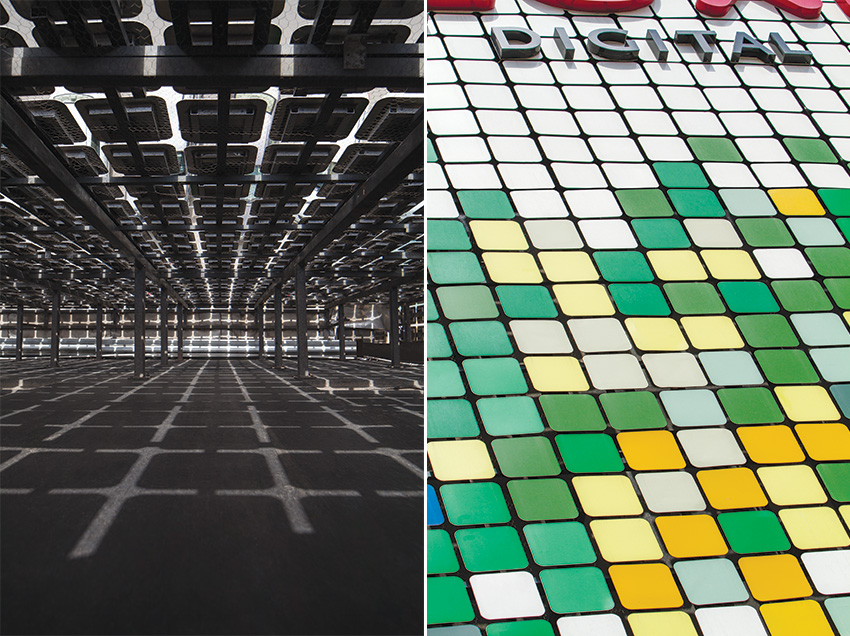
The architects rationalized their brief by methodically quantifying each requirement to understand their spatial needs. The gist that came through was to have a reception, a manager's room, photo editing workstation, a display for photo frames and to communicate standard photo sizes on the ground floor. The basement was to have a photo studio, a passport studio, a makeup room and some more photo editing workstations.
On discussions with the client, the architects were able to understand that their business thrived on shooting weddings. An idea emerged to use bright colors as a reflection of the famous Indian marriage celebrations. This was also an opportunity to add a speck of liveliness on the drab urban landscape. However, the need was to not narrow the studio's scope but respect its identity as a whole.
Amalgamating these various thoughts, the architects arrived at the concept of 'pixels', the smallest unit in a digital image, to highlight the studio's occupation in entirety. The design uses around 2,500 aluminium squarish customized panels, each representing a single pixel that come together to form a digital image. The image on the facade itself looks to explore the RGB color gradation, the three basic colors that blend to form all colors, wrapping the building from one end to the other.
For the interiors, the architects decided to continue the aluminium panels onto the ceiling to complete the cubical form. However, the interiors do not carry forward the same palette on the panels, instead explores the concept in shades of grey. This is done purposefully to allow the focus to shift to the reception table, which has the colorful pixels on a digital print, done by the client himself. The reception table detail is carried over on the manager's cabin and on the display wall to provide a unified elongated look. The display and the manager's cabin use the non-colors grey and black to remain in the background merging with the ceiling. LED Lights were also customized in the same shape as the panels and the full heights have been utilized by rejecting the idea of any false ceiling. The idea of floating is again exploited in a composition of different sizes of photo frames and this element is placed next to the front glass acting as a show window display. The client has the option of changing these photographs and the long pixilated digital print, thus bringing in the flexibility to have a desire new look.
In the process to achieve a better space, one of the main structural changes introduced was to get rid of a spiral staircase connecting the ground floor to the basement and replacing it with straight stair under the existing one that goes to the first floor. This is finished with a black granite floor and a black mirror ceiling to see a subtle reflection providing one the notion of introspection before they enter for a photo shoot in the studios below. The studios itself are white boxes to give the photographer a plain backdrop to shoot. The journey of the experience culminates in the makeup room where the architect use mirrors and black pixels to give the space a larger look while continuing the design concept in a different form.
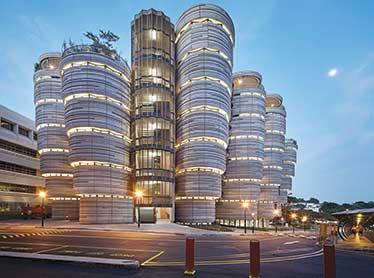
The Learning Hub at Nanyang Technological University

Designed by Heatherwick Studio and executed by CPG Consultants, The Learning Hub at Nanyang Technological University (NTU Singapore), is a new educational landmark for Singapore.
As part of NTU's redevelopment plan for the campus, the 8-storey cocoon-like Learning Hub is designed to be new multi-use buildings for its 33,000 students. With floor space roughly of 14,000 sq m (150,000 sq ft), the building's unusual form derives from an effort to encourage collaborative learning.

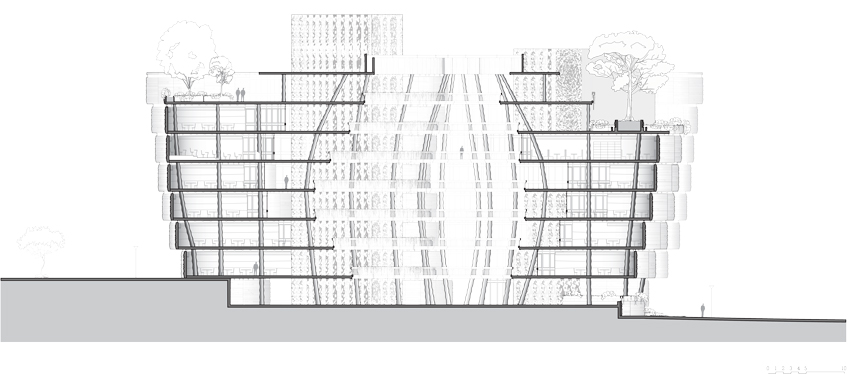
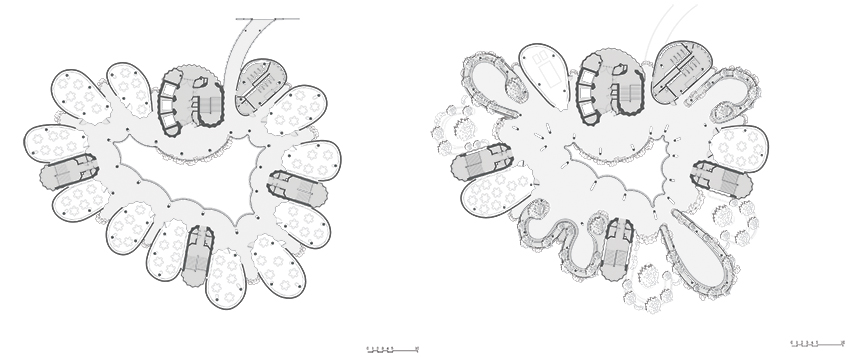
Unusual Form
Instead of the traditional format of an educational building with miles of corridors linking box-like lecture rooms, the university asked for a unique design better suited to contemporary ways of learning. With the digital revolution allowing learning to take place almost anywhere, the most important function of this new university building was to be a place where students and professors from various disciplines could meet and interact with one another. The Learning Hub is envisioned to be a place where students might meet their future business partner or someone they would have an amazing idea with.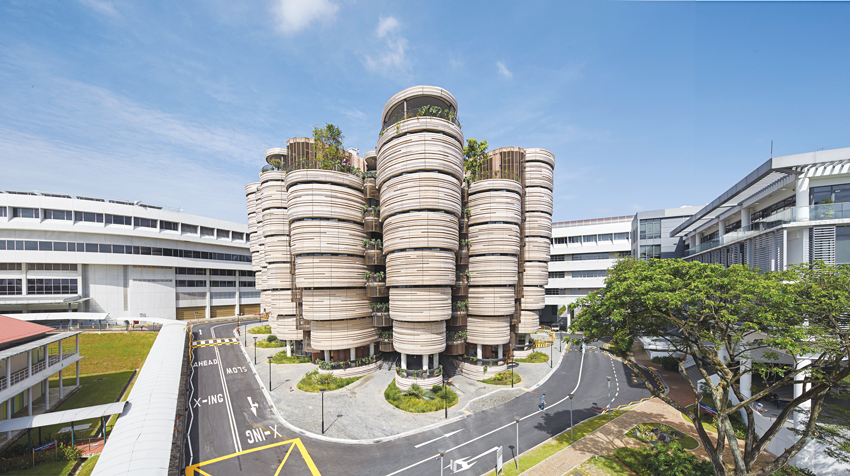
The outcome is a structure that interweaves both social and learning spaces to create a dynamic environment more conducive to casual and incidental interaction between students and professors. 12 towers, each a stack of rounded tutorial rooms, taper inwards at their base around a generous public central atrium to provide 56 tutorial rooms without corners or obvious fronts or backs.
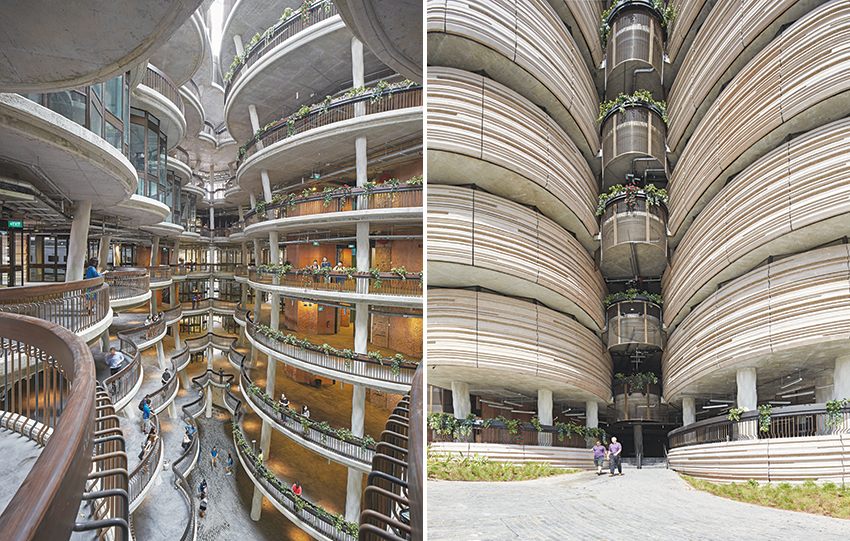
| At a Glance | |
| Project Name: | Nanyang Technological University Learning Hub |
| Location: | Singapore |
| Completion: | March 2015 |
| Site Area: | 2,000 square metres |
| Gross Floor Area: | approx.14,000 square metres |
| Building Height: | 8 storeys |
| Client/Owner: | Nanyang Technological University |
| Lead Architect: | CPG Consultants, Project Lead - Vivien Leong |
| Design Consultant: | Heatherwick Studio, Project Architect - Ole Smith |
| Main Contractor: | Newcon Builders |
| Sustainability Consultants: | CPG Consultants |
| Mechanical & Electrical Engineers: | Bescon Consulting Engineers |
| Civil & Structural Engineers: | TYLin International |
| Photo Courtesy: | Hufton + Crow |
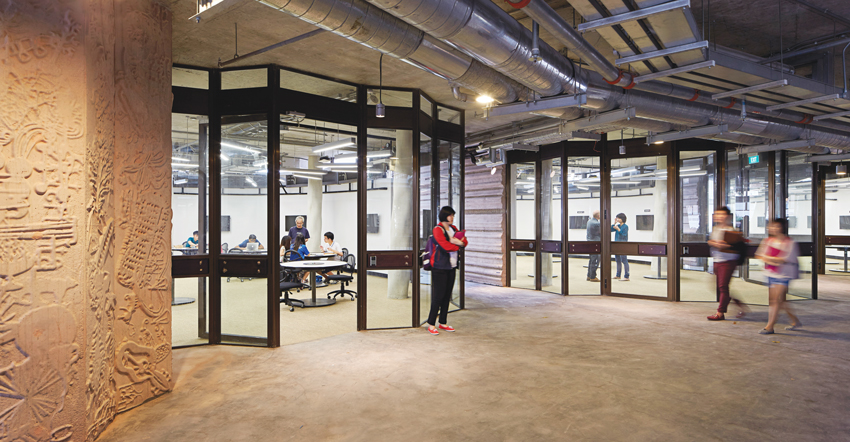
The new-generation smart classrooms were conceived by NTU to support its new learning pedagogies that promote more interactive small group teaching and active learning. The flexible format of the rooms allows professors to configure them to better engage their students, and for students to more easily collaborate with each other. The rooms in turn open onto the shared circulation space around the atrium, interspersed with open spaces and informal garden terraces, allowing students to be visually connected while also leaving space to linger, gather and pause.
NTU Professor Kam Chan Hin, Senior Associate Provost (Undergraduate Education) says, "The new Learning Hub provides an exciting mix of learning, community and recreational spaces for NTU students, professors and researchers from various disciplines to gather and interact. By bringing people and their ideas together, NTU can spark future innovations and new knowledge that increasingly happen at the intersection of disciplines."
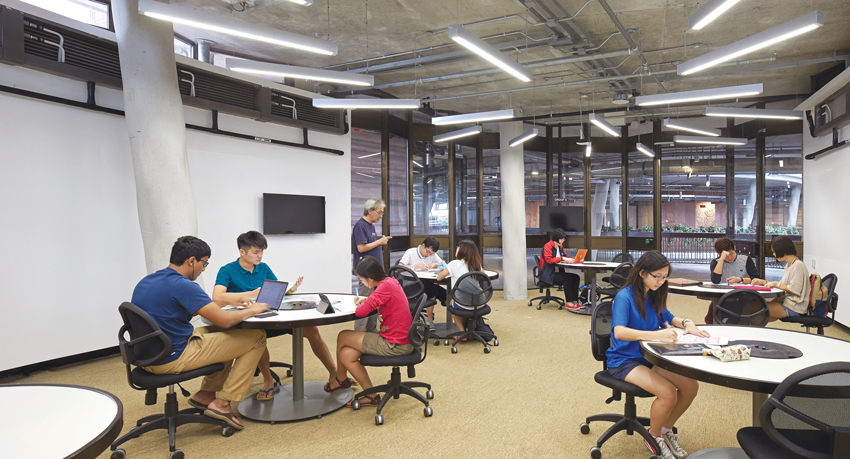
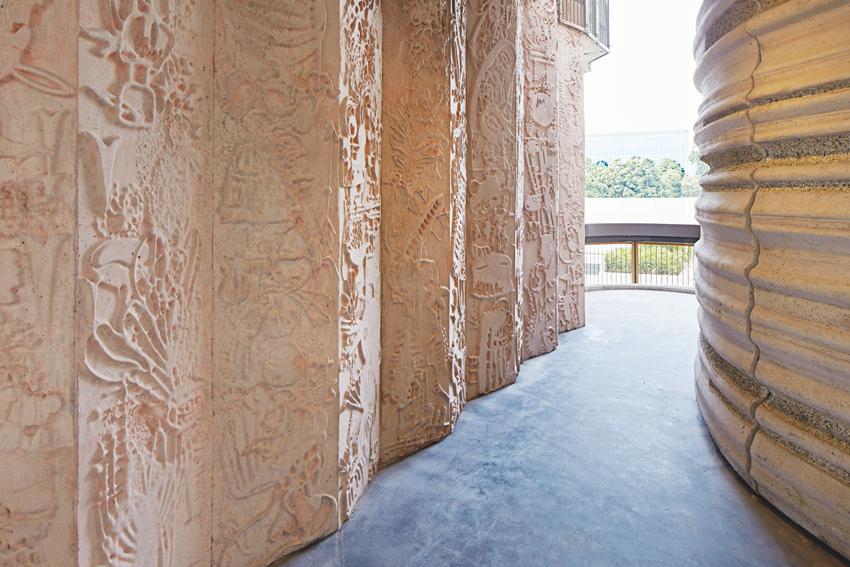
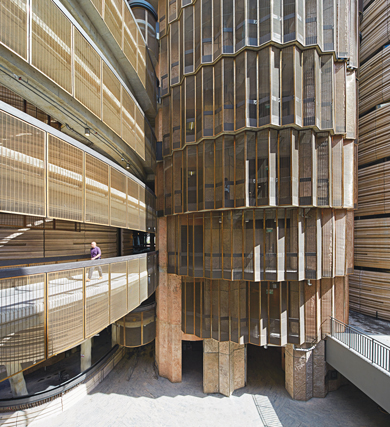
Vivien Leong of CPG Consultants, the Lead Architect and Sustainability Consultants for the Learning Hub, says, "The most exciting aspect of this project is to see such an inspired design develop into a uniquely contextual and functional building through a highly collaborative process. Managing this project was no mean feat as we had to ensure that our work complied with Singapore's rigorous building regulations and that it achieved the highest standards of sustainability, while working hard to retain the integrity of the original design and vision of NTU. The opportunity to challenge convention by introducing several first-of-its-kind environmentally friendly features and innovative solutions that embody the spirit of modern day learning has been a truly rewarding experience for us."
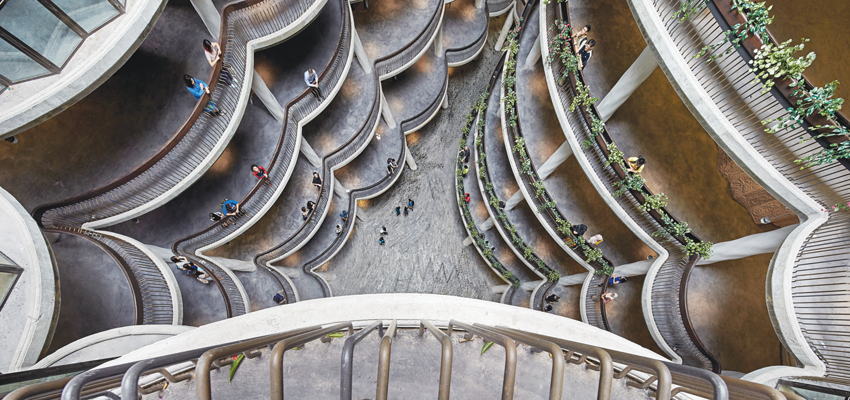
Design Challenge & Solutions
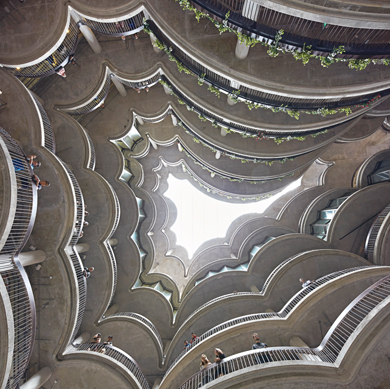
With year-round temperatures in Singapore between 25°C and 31°C, it was important to maintain the students' comfort whilst achieving a sustainable energy usage. The building's open and permeable atrium is naturally ventilated, maximising air circulation around the towers of tutorial rooms and allowing students to feel as cool as possible. Each room is cooled using silent convection, which does away with the need for energy-heavy air conditioning fans. The Learning Hub building was awarded Green Mark Platinum status by the Building and Construction Authority (BCA), Singapore, the highest possible environmental standard for a building of this type.
In a digital age when many students have multiple communication devices and ready access to knowledge, the Learning Hub reasserts the role of an educational building in the 21st century. No longer a place for traditional classroom teaching to passive students, NTU's new icon provides space for collaborative learning in a technology-rich setting. Opened till late, it will be a place for students to gather, where knowledge is shared, collaboration between disciplines takes place, and where future leaders are nurtured.
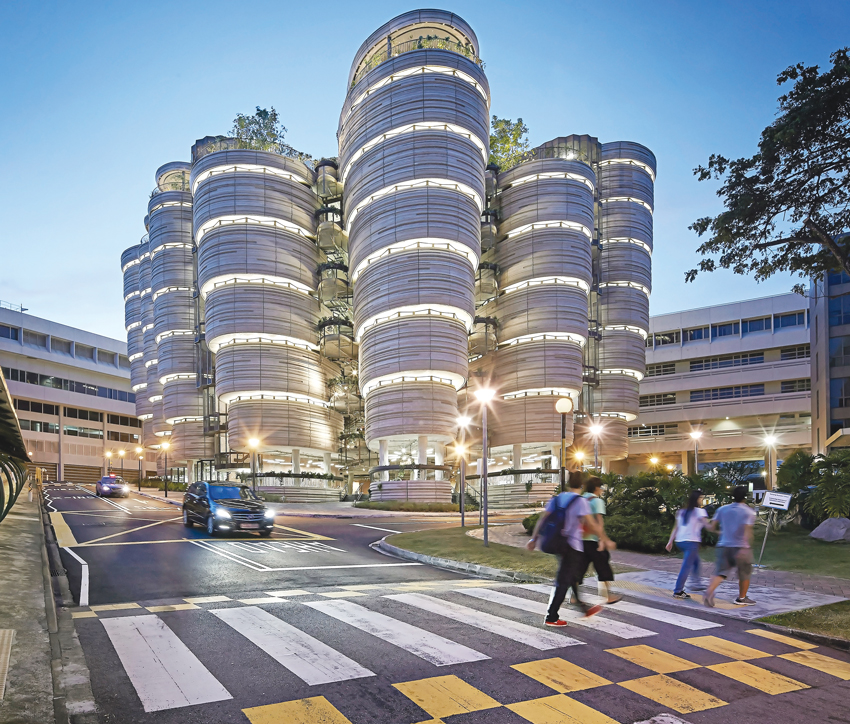
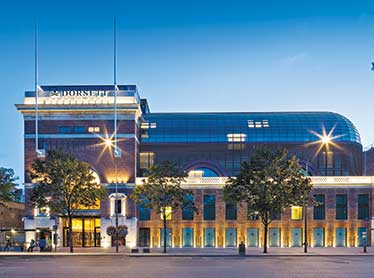
Shepherds Bush Pavilion Hotel, London

| At a glance: | |
| Projects: | Shepherds Bush Pavilion |
| Location: | London, UK |
| Architect: | Flanagan Lawrence |
| Lead Architect: | Jason Flanagan |
| Area: | 15,135 m2 |
| Client: | Dorsett / Kosmopolitan Hotels |
| Contractor: | Ardmore |
| Structural Engineer: | Expedition Engineering & URS |
| M&E Engineer: | McBains Cooper & Malachi Walsh |
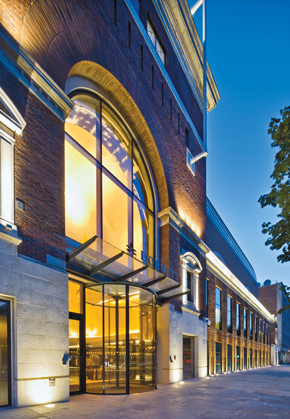
Completed to budget in July 2014, Flanagan Lawrence has unlocked the future potential of Shepherd's Bush Pavilion, complementing its form and reinforcing its original spirit. This solution achieves a careful balance between old and new, mooring the projects' pivotal position in Shepherd's Bush, a catalyst for the continuing regeneration of the area.
The building was originally designed by Frank Verity and was awarded the RIBA Award for the best London facade. After heavy damage caused by a V1 flying bomb during World War II, the building was vacant until 1955 when it was restored and reopened as a bingo hall. Before the recent redevelopment of the building into a hotel, the building had been in disuse for over a decade and had fallen into a state of disrepair. While the front elevation maintained much of its original design intent, the interiors and the rear façade had been extensively added to and adapted over its lifetime.
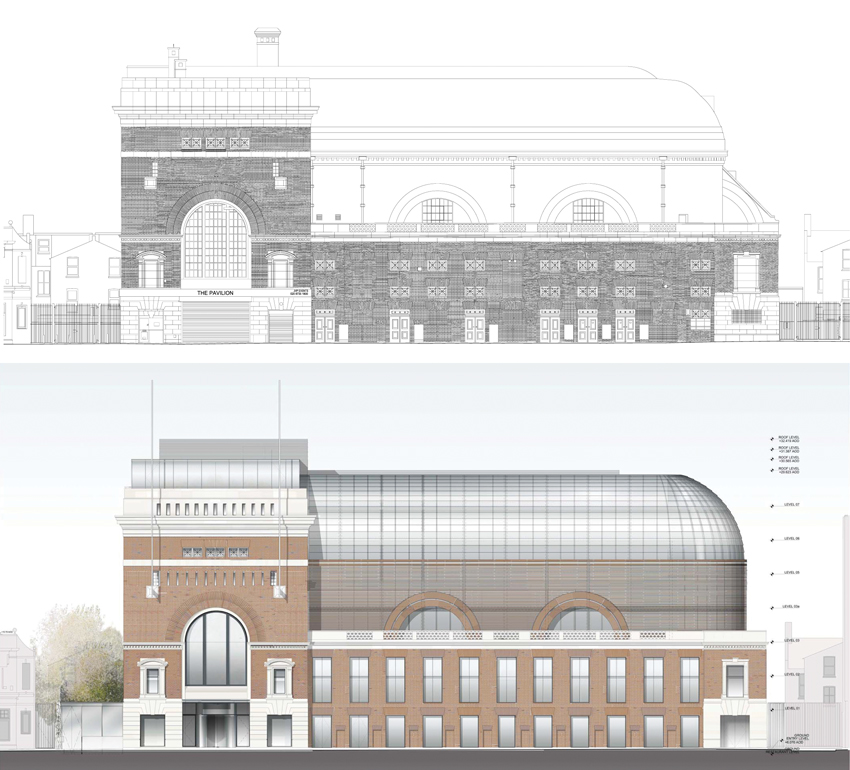
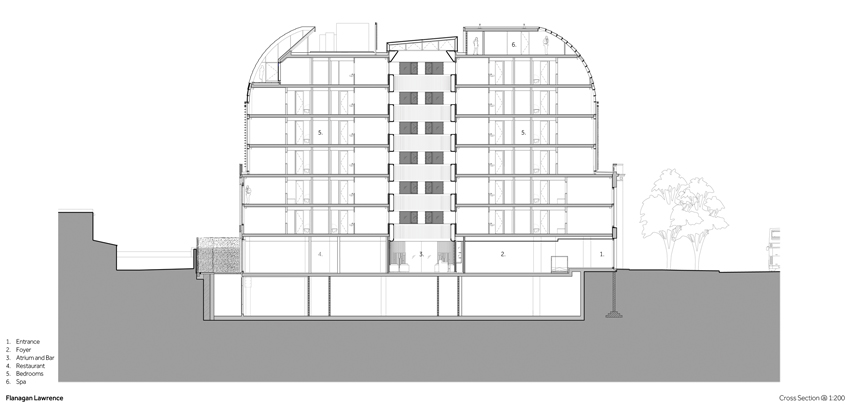
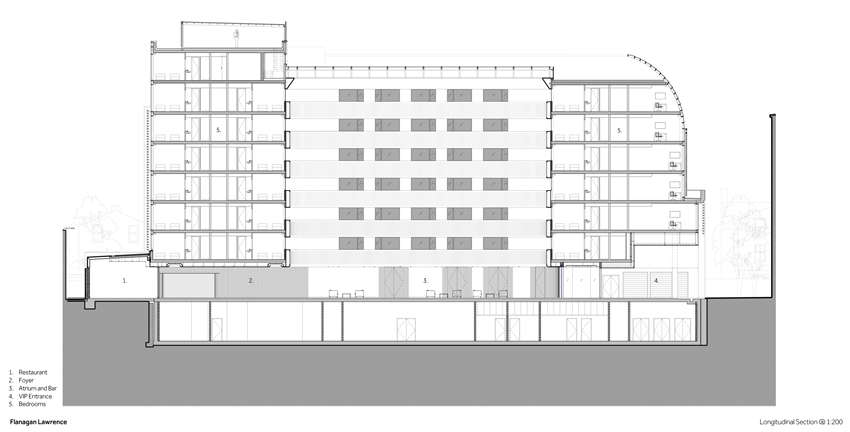
Transformation Brief
The proposal to convert this dilapidated building into a new 4 star hotel presented an ideal opportunity to give a much loved, but neglected building a new lease of life while revitalising and securing the retention of this important heritage asset and landmark on the Green.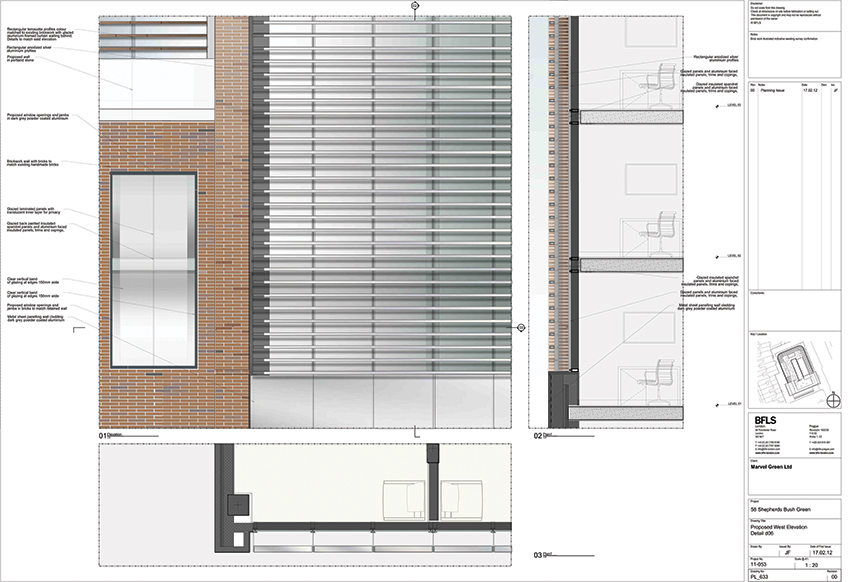
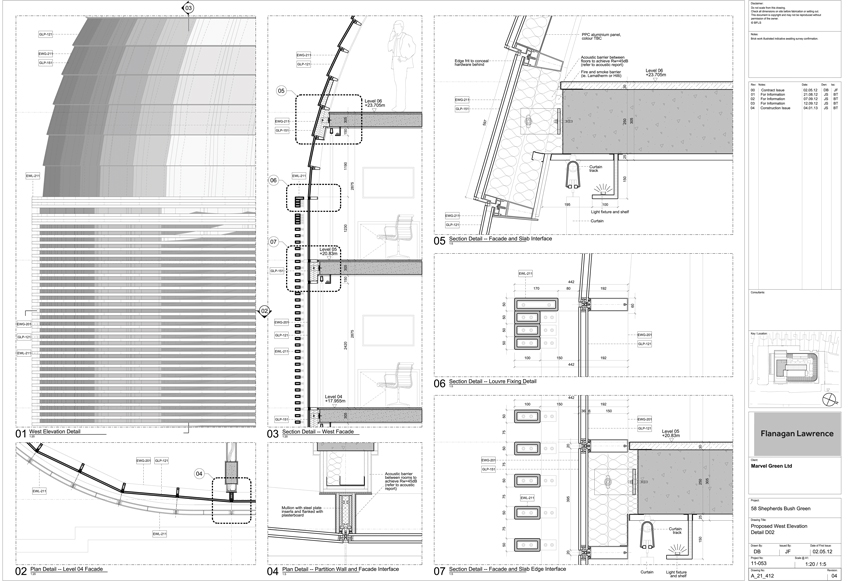
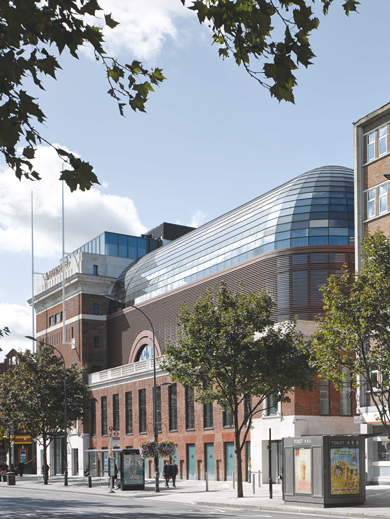
Design Concept
The design concept was derived from a detailed understanding of the building's history and context and the result is a contemporary response that complements and refines the original character of the building. The final scheme retains the original award-winning brick façade, with minor alterations to ensure natural light within the hotel rooms behind, and recreates the original roof form with modern materials. The use of glazed 'shingles' as opposed to the original use of metal shingles, while following the original curved profile, again allows light within the upper floors of the scheme, which previously would have been un-usable space.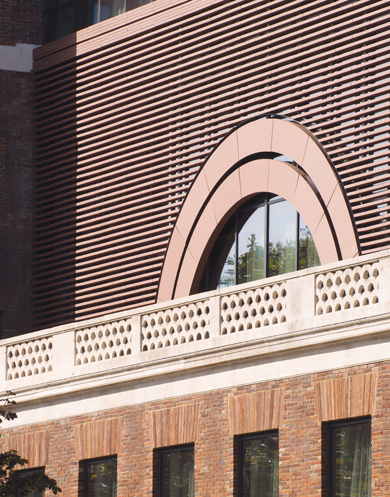
To incorporate the new functions, the interiors of the building were mainly removed. The new interior architectural sequence is based on the hierarchy of space in the original design and begins with the triumphal arch, which has been formed as a quarter dome to mirror the form of the corners of the external roof. This leads into a lower foyer, arranged in a similar configuration to the original cinema foyer, including a reference to the original circular floor decoration. The theme of the golden age of cinema is picked up in a series of art deco inspired curved roof vaults in the foyer space, with vertical circulation to the upper bedroom floors located in a similar position to the original circulation core at the west end of the 'tower'. The atrium is the real surprise; opening off the foyer, it rises to the full height of the building to create an impressive focal point for the hotel.
Drawing on the influence of Art Deco cinema design, the foyer and atrium spaces employ simple curved surfaces in alternating bands of black and gold. The internally illuminated spandrel panels also minimise sound reverberation. At ground floor level, dark- stained, ribbed timber panelling and heavy curtains serve a similar purpose. The honey-coloured limestone floor is inlaid with brass, in two simple decorative elements. In the main reception, view of atrium brass strips form a series of concentric circles at the centre of the space, which are reflected in a ceiling coffer above, while in the atrium, the bands define the circulation route from the reception through to the atrium bar.


New life with New Uses
The conversion and revitalisation of the building exemplifies good practice in managing to maintain the historic asset through the injection of new life and purpose. The conversion not only saved existing building stock within the townscape, it also extended the life of the building through the inclusion of new building materials and a new sustainable use. This new hotel use was acknowledged by the Local Planning Authority to be one of the few sustainable uses for the existing building, with the original uses being seen as not economically viable.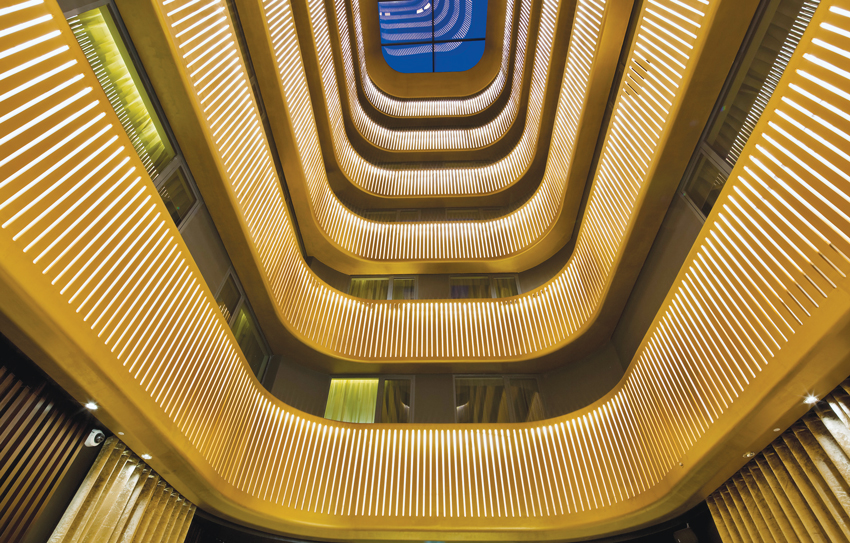
The scheme also forms part of the overall regeneration and resurgence of Shepherds Bush generally and builds on the upgrading works of the nearby station, Westfield and indeed the green itself, all contributing to the overall sustainability of the Shepherds Bush community and providing a new source of revenue – Tourism. The hotel development has also been the catalyst for the re-development of the adjacent Walkabout pub.
The street frontage which was boarded up for over a decade has been revitalised through the inclusion of two restaurants on ground floor. This activity provides a new space for the local community and tourists alike to meet whilst providing a destination and focal point for the Green. In both construction and in operation, the hotel has also generated increased local employment, with circa 90 staff operating in the hotel at any one point on a shift basis.
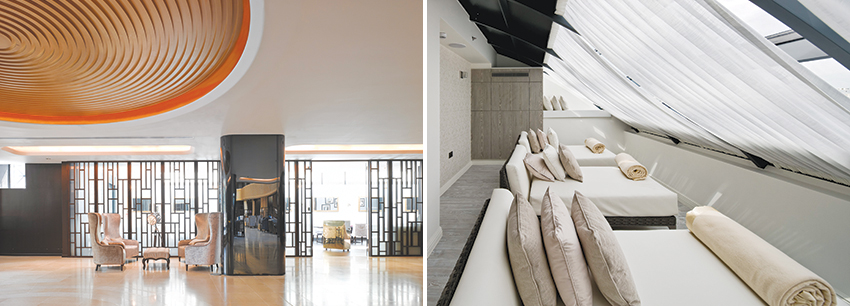
Sustainable Inclusions
In addition to the social and economic sustainability of the new hotel, the overall environmental performance of the building was increased as much as possible through the inclusion of new, energy efficient plant and services generally throughout the building. The thermal performance of the existing and new building fabric was substantially improved through the inclusion of additional insulation to the brick facades, high performance glazing and solar shading and improved air permeability.
This inclusive environment is established through a number of inclusions/adaptions to the building. The first being step-free access into and through the building itself. Automatic pass doors are provided at the main entrance, with discreet internal ramps being included where a change in level was unavoidable. The existing main entrance arch suitably identifies the main entrance through the architecture, where a canopy has been provided for protection to users. Lighting also assists with way finding around the site. Coach drop off and two disabled parking bays are provided at the secondary entrance to the building, where level access is provided directly into the building.
Internally, accessible Lifts are provided to all floors and all corridors and staircases are designed to ensure ease of use to all users. A number of fully accessible rooms have been provided within the hotel, and these rooms have been positioned across all floors of the building and in all orientations, hence providing a choice for users. Within these accessible rooms, options are provided on the bathroom accommodation, i.e. bath, showers and / or hoists, as well as with the handing of the room to ensure all users can be catered for. In addition to these, a number of rooms have been identified for future conversion into accessible rooms if the demand be sufficient. The ground floor of the hotel is also open to the public, with a restaurant and bar in the lobby area. This increases the accessibility of the unique heritage asset to the general public.
Shepherd's Bush Pavilion achieves the retention and re-use of a long term vacant listed building for a purpose which promotes the vitality and viability of Shepherds Bush Town Centre. Ideally located in the centre of the boroughs' redevelopment and adjacent to the popular O2 Empire concert venue, functioning as a hotel is both an economically viable venture as well as a catalyst for the project to attract both local visitors and international tourists to Shepherd's Bush.
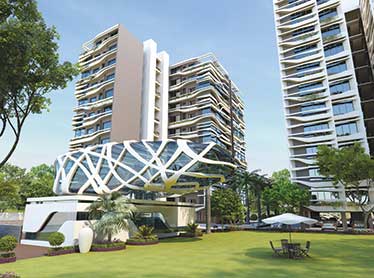
Bird’s Nest Club House Balaji Windpark, Ahmedabad

| At a glance: | |
| Project: | Club House, Balaji Windpark, at Vaishnavdevi circle, Ahmedabad. |
| Form: | Shell like glass enclosure, complete glass 'gymnasium' |
| Glass Manufacturer & Supplier: | Marvel Glass Private Limited |
Shree Balaji Wind Park is a luxurious residential project developed by Shree Balaji Group and ideally located in the rapidly developing area of the city, Vaishnodevi Circle at SG Highway, Ahmedabad. Inspired by the Dubai and Spanish architectural design, the project consists of 6 towers each with 13 floors, state-of-the-art Pent Houses with Splash Pools and also a uniquely designed Club House ever built in the city.
Design: Shell like Glass Enclosure
The design of the moulded glass Club House is inspired by the Bird Nest or Beijing National Stadium, China. The architect has designed a classy shell form transparent and fully lit gymnasium which drives a message of engineering excellence and unparalleled commitment of the promoter to offer the best. Also, to give the form light feeling, the floor has been designed in glass.Curved and flat laminated glasses have been suspended from mild steel ribs, as outer skin of a complete enclosure, in the form of a shell. For added safety laminated glass floor has been provided to rest gym equipment, and as an actual glass floor inside the gym. The entire gym form is supported to a slab resting on a single column, on which a cyclic staircase is provided to access the gym.
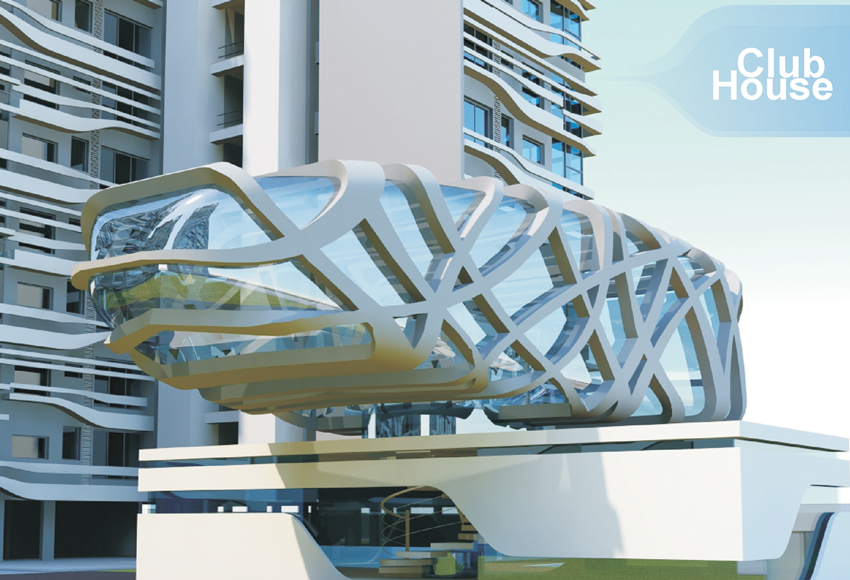
Marvel Glass Private Limited, a leading architectural glass solutions provider was shortlisted to design and execute the complete glass form, including the glass specifications, fixing details and glass divisions, ensuring adequate structural strength with respect to live load and wind load, heat protection through diffused sunlight from the roof, glass alignment not allowing any water leakage, air vent cut-outs for hot air release, adequate air circulation inside the enclosure and structurally sound glass floor to absorb dead load as well as jumping load. Every aspect which includes, illustrated sketching, detailing of SS studs and aluminium flat supports for glass, steel templates for glass form and dimensioning, glass processing, glass installation, sealant application and overall aesthetics has been vendor’s responsibility.
Optimum Glass Engineering
Here many glasses are not only curved in different radius on individual axis but are also twisted in plane, while aligning with the adjacent glass which is again curved in different radii, but still aligned to the accuracy of millimeters to ensure butt joints which are leakage proof. Also, the curved safety glasses are made in factory and fitted individually at site, wherein for some glasses out of 4 edges, glass is structurally glazed on only 2 edges, although each panel weighs as high as 300 kgs. For each glass panel, individual steel template is made, cross braced to prevent distortion of template before it reaches the glass factory.Extremely efficient and skilled labor were involved to install these heavy glasses without allowing even a scratch on the surface, though hardly any platform was available to stand. As the glasses turn and enclose the form below the floor slab, the task of glass installation becomes even more difficult because at some places, there were hardly 6" gap between the glass panel and the slab which was not enough for someone to stand and install. Apart from the fact that each glass is customized and prone to extreme risk of scratches, edge chipping or cracking while installing…the given job has been successfully completed.

Meeting Challenges with Hi-tech Engineering
Not allowing heat build up on account of transparent glass cover all around, zero water penetration even with complex glass forms aligned with each other, capacity to sustain equipment and live load as a gym glass floor, viability to repair and replace any glass damaged during use, cleaning and maintenance of each glass panel both from inside and outside bearing the dusty weather of Ahmedabad…are some of the prominent challenges of this project. For each requirement independent features/technology innovation/engineering have been provided.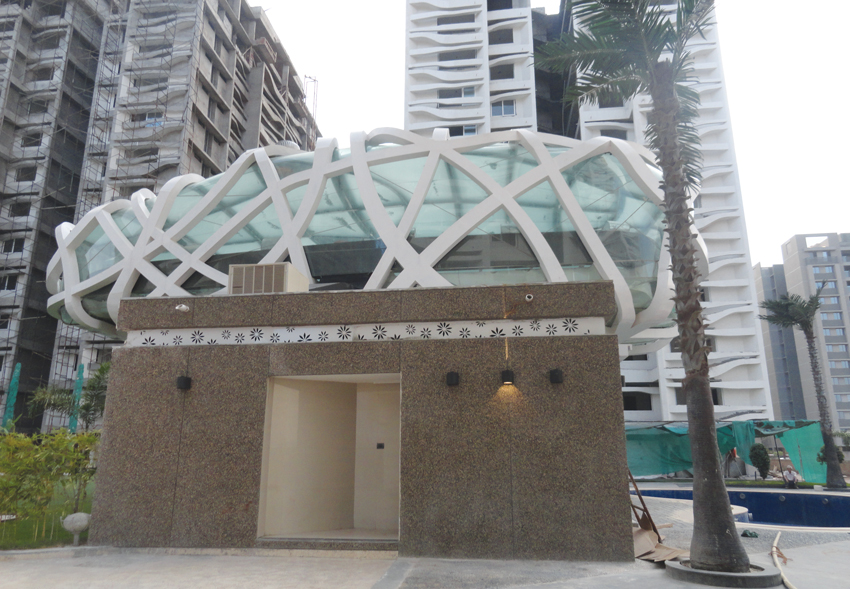
1) Preventing heat buildup: The roof glasses have been sand etched to cut light glare and to prevent the unwanted infra red radiation. Further 5 principal centrifugal turbo fans are provided to draw out hot air. Also, at the floor level air cooling duct is provided for supply of temperature controlled air to maintain ambient temperature inside at comfortable levels even at severely hot hours.
2) No water leakage: Glass fixing is facilitated using structural sealant. Further all exposed glass to glass joints have been impeccably matched and filled with weather sealant. Also, those grooves between glass panels not visible are sealed with dual protection of weather sealant.
3) Replacement of damaged glass panels: Made viable, as each individual glass panel is made in reference to a steel template while each panel is fitted in a manner in which it can be accessed and replaced.
4) Cleaning and maintenance of glasses: Structurally stable fitting has been incorporated to permit walking/access of safety laminated glasses from both outside and inside for cleaning using conventional methods.
Marvel Glass (www.marvelglass.com) undertook this challenging Club House project and completed it in 18 months, setting a landmark for Glass Engineering.
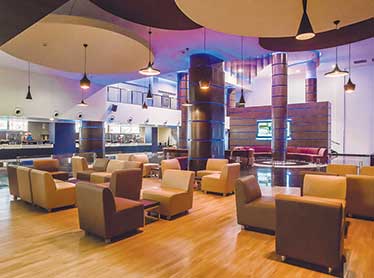
Cinepolis Megaplex at Viviana Mall, Mumbai
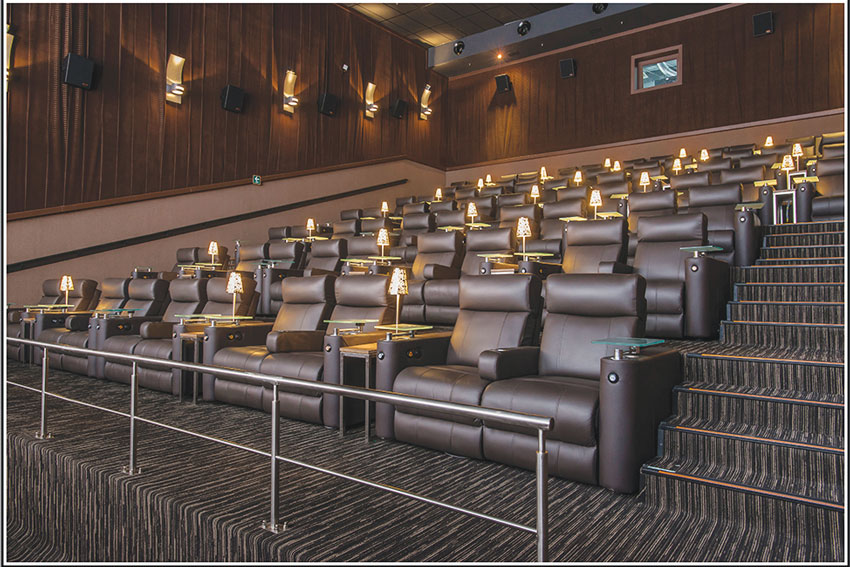
India's Largest & Technically Advanced Multiplex with Six Concepts under One Roof
Cinepolis has recently crossed the milestone of 100 screens in India with the launch of country's first 4DX technology enabled screen at Vivanna Mall, Thane in Maharashtra. With this multiplex which is the most technologically-advanced theater, Cinépolis will be operating 110 screens across India.
With 14 screens, this megaplex houses six concepts under one roof viz. Cinépolis VIP, IMAX, 4DX, Dolby Atmos, RealD 3D and 4K projection system. For the first time, audiences will have access to 4DX in India which provides a fully immersive movie experience with a real simulation of effects like motion seats, water, wind, fog, lightening and scents that enhance what one views on the screen.
The Cinépolis VIP is a concept that reinvents entertainment with full leather recliners, in-theatre restaurant apart from the existing service on-seat. It is also the first Cinépolis property to have a fully-equipped IMAX® Screen. In addition, another auditorium in the complex is equipped with Dolby Atmos, which employs up to 64 speakers to heighten the realism of every scene. Patrons can also enjoy freshly-prepared gourmet food at the in-house coffee shop, Coffee Tree, in the lobby of Cinépolis.

The property also has the state of the art 3-D technology from RealD® systems which has an exclusive tie-up with Cinépolis in India. RealD 3D cinema technology is a polarized 3D system that uses circularly polarized light to produce stereoscopic image projection. The advantage of circular polarization over linear polarization is that viewers are able to tilt their head and look about the theater naturally without seeing double or darkened images. However, as with other systems, any significant head tilt will result in incorrect parallax and prevent the brain from correctly fusing the stereoscopic images.
Apart from these, movie goers can avail the benefits of Club Cinépolis, the company's loyalty programme at the theatre in Viviana Mall.
"Our interest in this proposal was to combine our personality and international design trends, to create a design in which our patrons in India can feel identified. The objective of this new interior design concept was to keep the personality of Cinepolis Brand; fun, cool, creative, family driven, young and friendly, adapting the attributes of Cinepolis to the identity and context of India. In India, a country with such a vast and rich culture, which translates in lush forms and textures, colors and sensations, to adapt our company's personality, we wanted to create a spectacular space to commemorate our 100 screens in India. We were looking for India's taste to be reflected in our design concept, to give consumers world class service the same way in any of our eleven countries where we have presence like USA, Brazil, Mexico,in which we have received several awards for being the best cinema," says Luisa Ramírez Díaz, Design Director, Cinepolis.
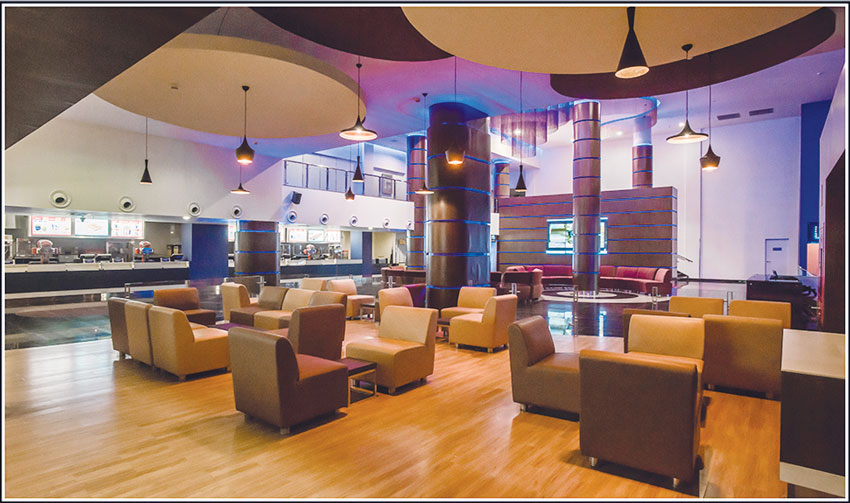
Design Concepts & Features
Some of the design concepts and features of Cinepolis Megaplex as described by Díaz include:- The interior design concept created for Cinepolis Viviana was born from the need to have the best cinema complex in India, inside a highly relevant mall.
- The design process consisted in identifying those space elements, technologically and design driven that defines Cinepolis, with which we express the brand's personality and from that we proceed to do a reinterpretation.
- The height of our lobbies in our Indian Cinemas is unusual; however that wide space is necessary in order to provoke an immensity and monumentality effect, which we find very appealing in our complexes.
- Another key design element was the lighting. We lowered the lux levels, and introduced colored lights, replacing the painted walls with light washed walls. We incorporated a chandelier as a central design element from which, with a combination of lights, a flashing and glitter effect that floods this space is created, giving a scenic, theatrical and dramatic effect.
- The access corridor is a transition space between the lobby and the audis. It is a space where our patrons can introduce themselves to this submersible experience, which in this case will be the movie. The light levels are much lower, creating an intriguing environment, a prelude to something exciting that is yet to come.
- We selected materials from local providers, which when combined can create an eclectic, comfortable and vibrant environment.
- Talking about auditoriums, our design criterion is the best worldwide, stadium type seating in audis which offers much more comfort and the best projection and sound experience in the world. It improves the surrounding sound experience through widening the "Sweet Spot" (the best seats inside an audi, where the patrons can feel the sound experience at its fullest, according to the speakers' placement).
- The projection and sound of all our auditoriums have the latest technology out in the worldwide market. Our Audis have a 7.1 Dolby Digital Surround Sound having two additional audio channels, which traditionally were 5.1 channels.
- Our 4K Digital Projection, offers 4 times the level of image quality than which other cinemas with 2k projectors can offer. The 4K Digital Cinema offers images with larger aspect ratio, and as a result much richer and detailed image quality. With 4K, the patrons will forget about pixels and will focus on the movie's plot.
- In Cinepolis Viviana, we introduced innovative concepts, such as VIP, 3D sound immersive technology Dolby Atmos, the Imax Theatre, the 4DX audi and coming soon the Junior audi. The design as well as the introduction of these innovative concepts makes this complex the biggest, most modern and innovative.
- In an IMAX movie, the sound has also been improved. As a result of a patented digital remastering process, the movie's original sound is remixed in postproduction to recapture the Complete Dynamic Range.
- The 4DX Audi is a Digital Projection system which achieves a much deeper indulgence of the patrons recreating the movie's ambience inside the audi, such as fog, rain, wind, scents, deeper and more intense sounds, as well as vibrations and movements from the seats.
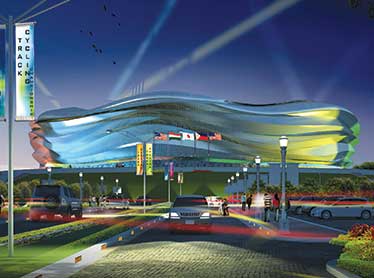
UKA Unveils Design for Velodrome, Lucknow
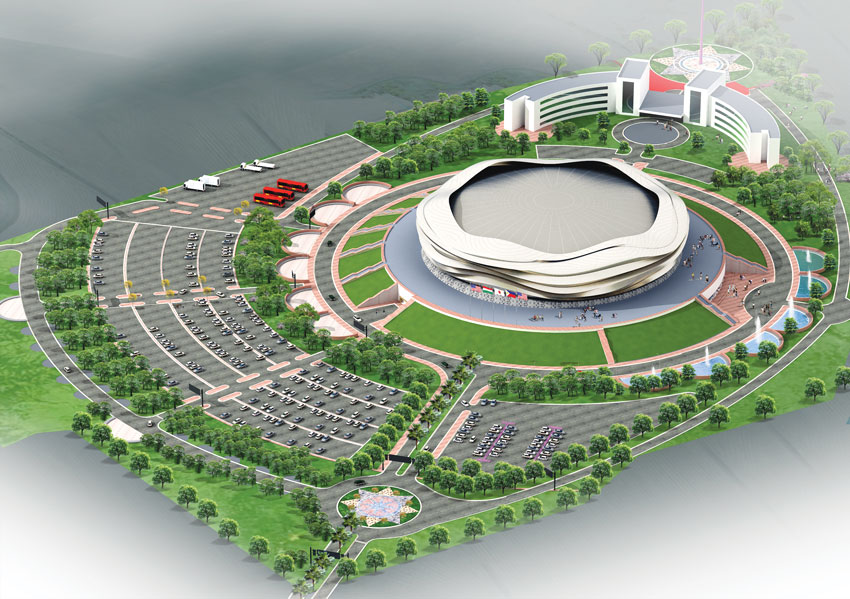
| At a Glance | |
| Project: | Velodrome |
| Location: | Guru Govind Singh Sports College, Kursi Road, Lucknow |
| Current Status: | Competition Entry, Dec 2014 |
| Architects: | Utkarsh Kothari, Director, UKA Ravindra Verma, Chief Architect , UKA |
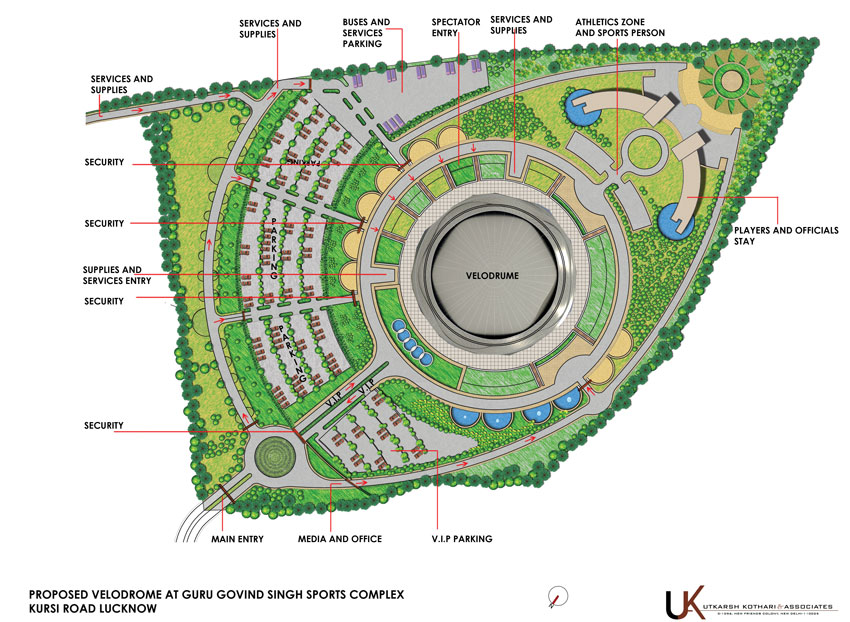
New Delhi-based architecture firm Utkarsh Kothari & Associates (UKA) has recently submitted its design for competition of proposed Velodrome within Guru Govind Singh Sports College, Lucknow.
Design Concept
Velodrome being proposed is with a seating Capacity of 5,000. A total area of 20,000 sq. m. is required for capacity of 5,000 as per international norms. The remaining 6,000 sq. m. could be utilized for residential facilities for the athletes/ families/ officials etc. The largest practical size for the arena space keeping in mind the sight lines, would be of diameter 120m for the 250m length cycle track.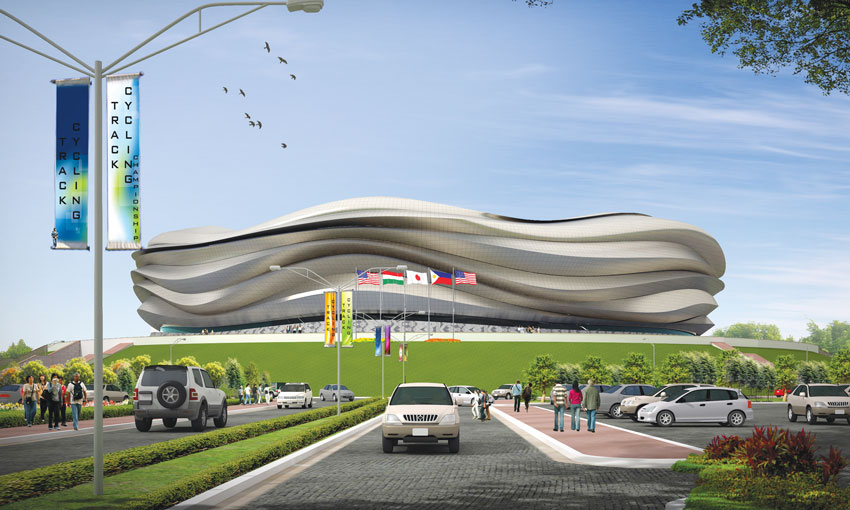
UKA chose pre-weathered quartz VMZINC for the envelope which is a long lasting, durable, aesthetically pleasing and unique envelope. VMZINC Interlocking panels clad the opaque part of the facade, highlighted by the contemporary facade lighting solutions. The monolithic impression is created by the quartz zinc cladding on the façade. The material was transformed into small elements that were folded and hollowed out and were installed in strips on the entire façade over steel frame. The raised interlocking system of zinc pieces provide subtle shadow reliefs in the facade and combine with the lightness of seamless glass that can be seen from a distance as they glisten in contrast under the shiny morning sun and also glow at night.
The peripheral facade is proposed in zinc metal panels with external cladding on steel framing as per the dynamic shapes. This framing is supported on the main steel trusses spanning across the Velodrome diameter.
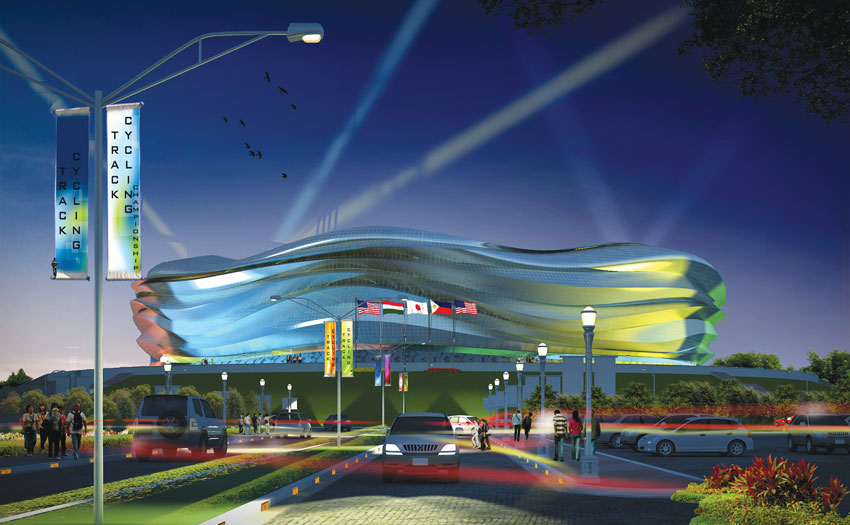
Proposed Velodrome is a structure intensive building which is located in seismic zone III of India and is designed for earthquake and wind load combinations. The roof consists of light weight steel roof truss covered with sheeting supported by periphery columns in steel. The roof structure shall be designed for gravity, seismic and wind forces. A 3-Dimensional analysis is performed using Limit State Approach. The building is analyzed using STAAD-Pro Structural Design software. The analysis is carried out in accordance with the provision of NBC, building bye-laws and specifications as stipulated by Bureau of Indian Standards.
The structure is analyzed for the appropriate seismic loads, all dead loads and live loads, wind pressure etc. In all cases, normal strengthening to resist distress during earthquake is being provided in the structural design. The facility proposed will be state-of-the-art, and will set a benchmark for all such future projects in India.
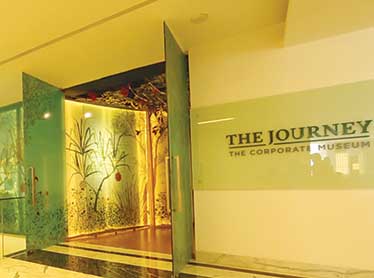
DS Group – Corporate Museum
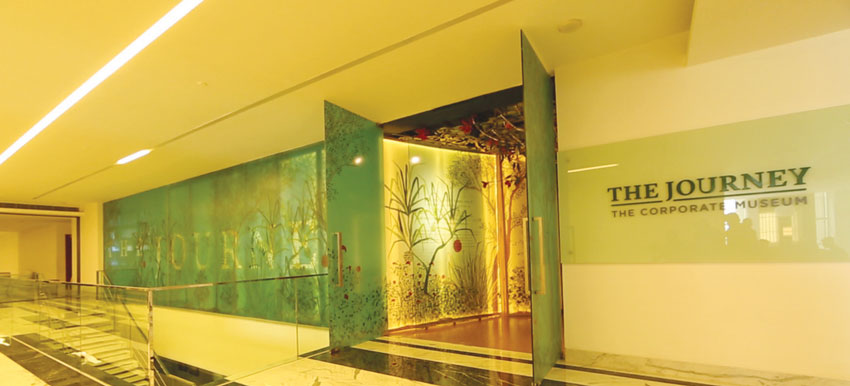
Recently Mr. Behl has completed a project named 'The Journey – The Corporate Museum' for DS Group. It took around two and a half years to finally deliver what the client had procured in his imagination. This museum showcases, in its true spirit, the origination of DS Group, its struggling era, initial phase of establishment, the downfall, followed by rejuvenation of family members, revival of business, and re-incarnation of belief of the founder, Shri Satyapal Ji. It's actually the art of storytelling, which involves wide range of media and multi-media tools backed by context-driven strong narrative that has made the outcome truly an undulating one.
Project Brief & Concept
Initially, it looked quite a challenging goal to achieve but at the same time it was interesting too. The job was to re-establishing a corporate personality. Prime concern was to carry the client along and simultaneously transform a corporate history, which usually is boring, into an interesting correlation between the past and the contemporary to meet the needed objective of depicting a journey that still continues.
To create a manifestation of past with future, renowned Bollywood script writer, Mr Dilip Shukla – Damini and Dabangg fame, was roped in. According to Mr. Behl, the Design Habit team became the narrator, used 360o visualization surrounded by moving image, and tried creating a balance in between the predecessor and the contemporary to pass on the essence of learning to the successor. It was all possible because of the Team's multidisciplinary approach in integrating diverse fields of graphic design, lighting, architecture, multimedia, and new media for developing experiential space that is immersive, engaging, communicative, entertaining, and educational at the same time.
Design Habit considers itself a story teller using space as a medium to emote and provoke through messages and meanings. Much like storytellers who use prose, rhyme and song, we draw from a wide range of media. From traditional storytelling techniques, theatrical props and sets, dioramas, trompe l'oeil, film and audio, interactives, automation and multimedia, we create strong narratives with context-driven.
Making of the Corporate Museum
Having understood the DS Group's story, its origins, vision, and the available space, the message to be conveyed became clear as to how that might happen. There envisioned an immersive experience created through visual and experiential metaphors. The visitor enters a recreated world where history, the milestones of the organization, and the aspirations of all generations come together in a storyline that is dynamic and compelling.
Storytelling plays a pivotal role in the design. The story of the DS corporate group is told through compelling narratives by means of art and craft, digital and analogue technology, audiovisual and multimedia, all dynamically integrated for a powerful spatial experience.
An experiential museum, The Journey is an artistic representation of the Group's very essence and identity. The museum is divided in five sections, each unique in their treatments, experiences evoked and the technologies used. The museum covers the largest art and design palette possible, making it not just a visual delight but a complete immersive sensory experience.
DS Group
Dharampal Satyapal (DS) Group, the owner of the brands like Baba, Tulsi, Rajnigandha, Pass-Pass, Kachcha Aam, Catch, etc., is a rapidly growing multi-diversified conglomerate with a turnover of more than Rs.6,500 crores. Founded in the year 1929, DS Group has a strong presence in high growth sectors such as F&B, Hospitality, Mouth Fresheners, Tobacco, Packaging, Agro forestry, Rubber Thread, and Infrastructure. The Group has further strengthened its presence in the F&B category by entering into Dairy and Confectionary segments. As of now, the Group has more than 24 manufacturing units spread across Delhi, Noida, Himachal Pradesh, Assam, and Tripura. 'The Manu Maharani' – a super deluxe property in Nainital, 'Radisson Blu' – a five star Hotel in Guwahati, and Namah – a resort at Jim Corbett are a few names making the group's presence felt in the burgeoning hospitality sector.
The Company leverages its strength through dealer network expansion and upgradation of production facilities, while reviewing its commitment to quality, innovation and consumer satisfaction. For DS Group, a 'winning strategy at work' is the one that follows a well-defined procedure for product development and quality assurance, constantly innovating and improvising its manufacturing components, leading to the making of a perfect product.
Forest of Fragrances
The Forest of Fragrances is a metaphorical holding area before the timed shows start. The soul of the Group is flavours and fragrances, which are at the very core of the products produced by the Group. This magical forest focuses on eight main flavours and fragrances.
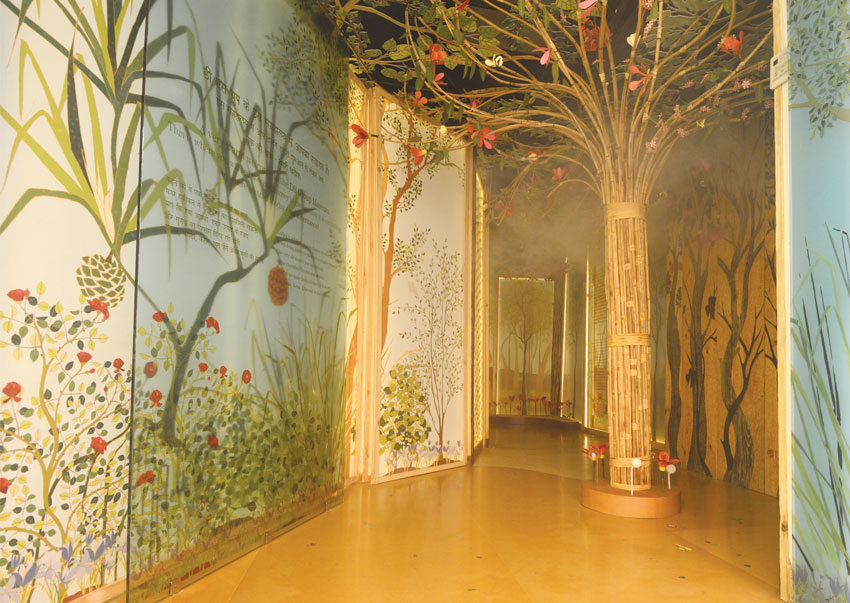
A conceptual holding area which takes visitors through an enchanted forest of eight fragrances all heightened by a haze filled atmosphere and an ambient soundtrack to establish the group's origins as sugandhis, perfumers.

Depicting the bedrock of the business based on flavours and fragrances
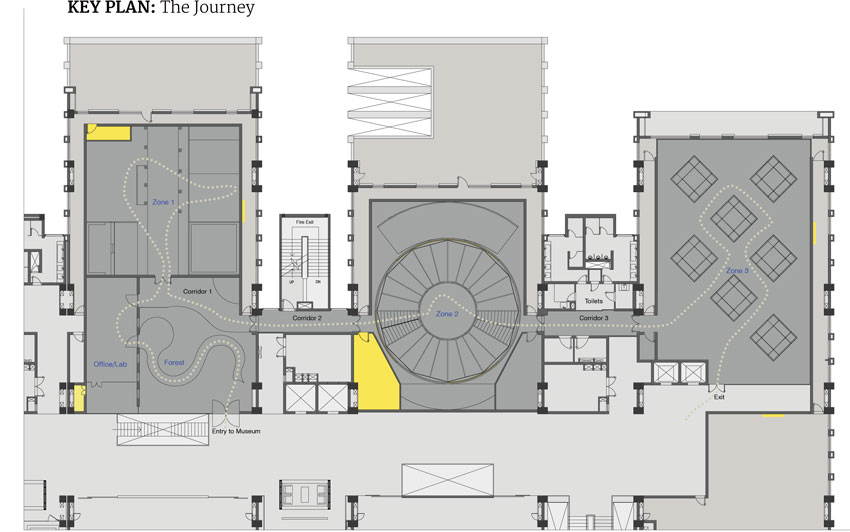
The Office & Laboratory
A recreation of Satyapalji's lab and office, using objects from his actual lab and office – right from furniture to AC to even the tiny bottles of essences, and to the tools that belonged to him. With the assembling of all the objects, matching woodwork, flooring, and ceiling, the visitors are taken back in time and space to his actual lab and office. Two highly realistic mannequins make this experience even more magical. A large TV screen in the middle plays a video of the Chairman and the Vice Chairman welcoming the visitors to the museum.
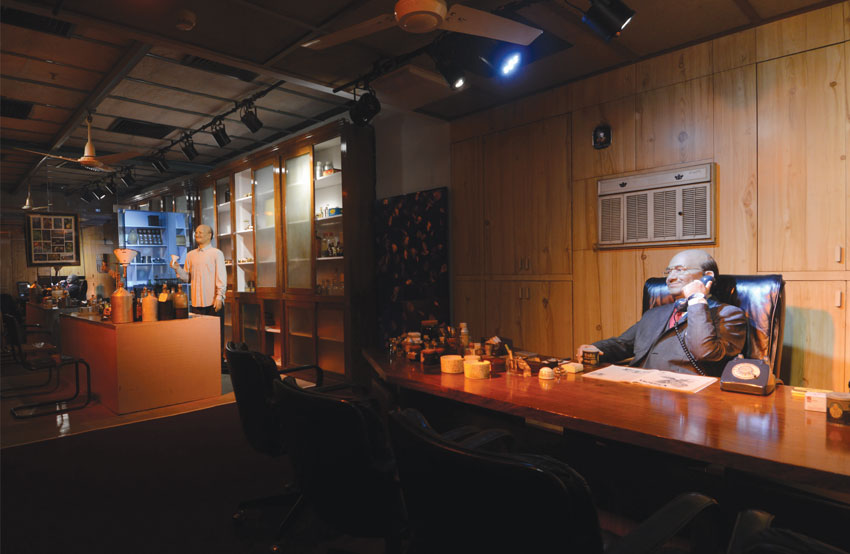
A glimpse into the space where the founder of the group worked, leading in from the forest is much like a theatrical recreation of the actual office and laboratory used by the founder, Shri Satyapalji. The furniture and props displayed are original items actually used by Satyapalji.
Chandni Chowk
A walk through where it all began
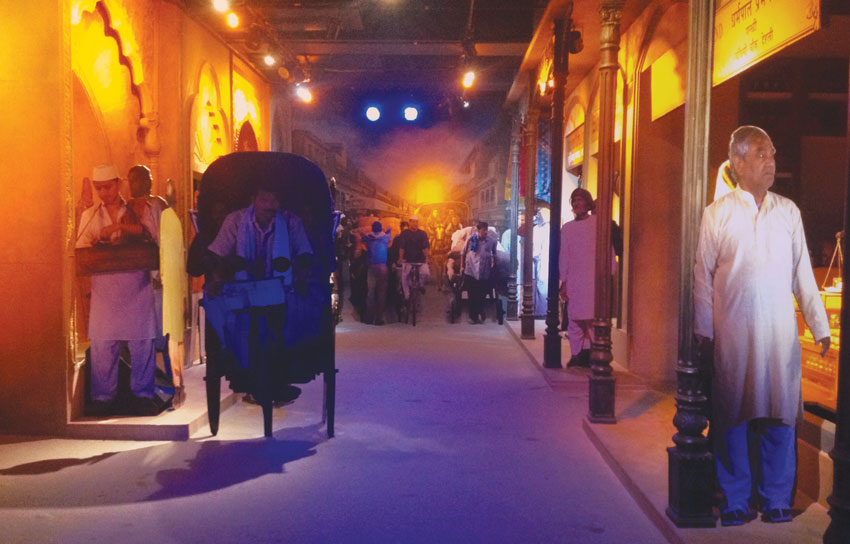
The third section is a dramatic re-enactment of the Group's prime founder, Dharampalji's story. How a small trading enterprise becomes a large manufacturing concern which was carried forward by the pioneering efforts of his sons, Premchandji and Satyapalji.
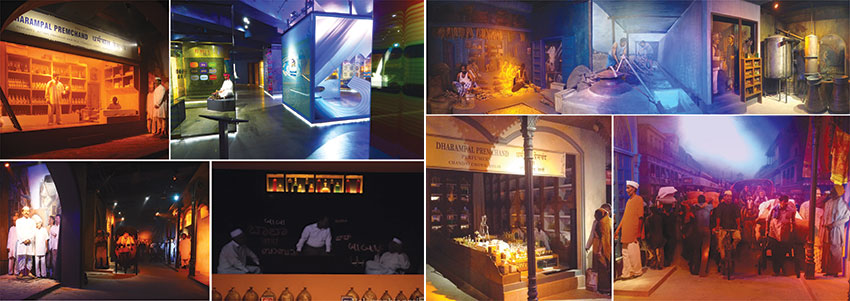
Zone 1:
A timed and pre programmed show, this Zone captures the inspiring story from where the Group started back in 1929 from a small shop in Chandni Chowk, taking the visitors to the 70s - the era of the Group's flagship product 'Baba'. Dynamic sets with props recreated using archival materials, life size realistic cut outs, highly realistic mannequins, tromploeis, VFX, films and holographic projection, lighting conditions make the experience completely immersive. The poetic narrative interspersed with melodious music takes the visitors back in time, as they witness the legacy that the Group so preciously holds.
The 360° Corporate Experience
The DS Group's story
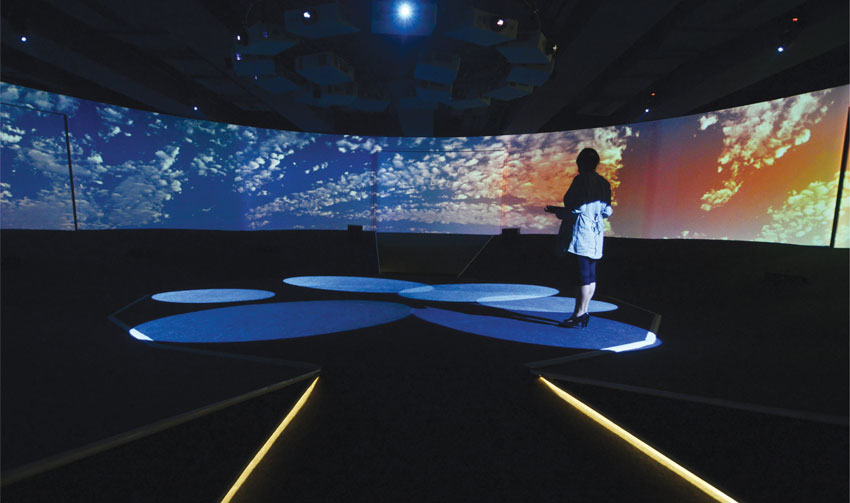
This section celebrates the dynamic spirit and growth of the group, with specific focus on the group's emphasis on quality, innovation and enterprise. A circular space with a central viewing area for the 360° cyclorama has 13 projectors beaming a film rich in computer graphics and a compelling song to create an amazing immersive experience.
Zone 2:
The 360° projected film or a cyclorama transports the visitors to a completely new world, the world of DS Group. The film is a combination of live shoot, computer generated images and special effects. A kinetic floor makes this a 4D experience. At certain points, sections of the screen open where projection is mapping along with a talking head, making Satyapalji actually come alive in front of the visitors' eyes.
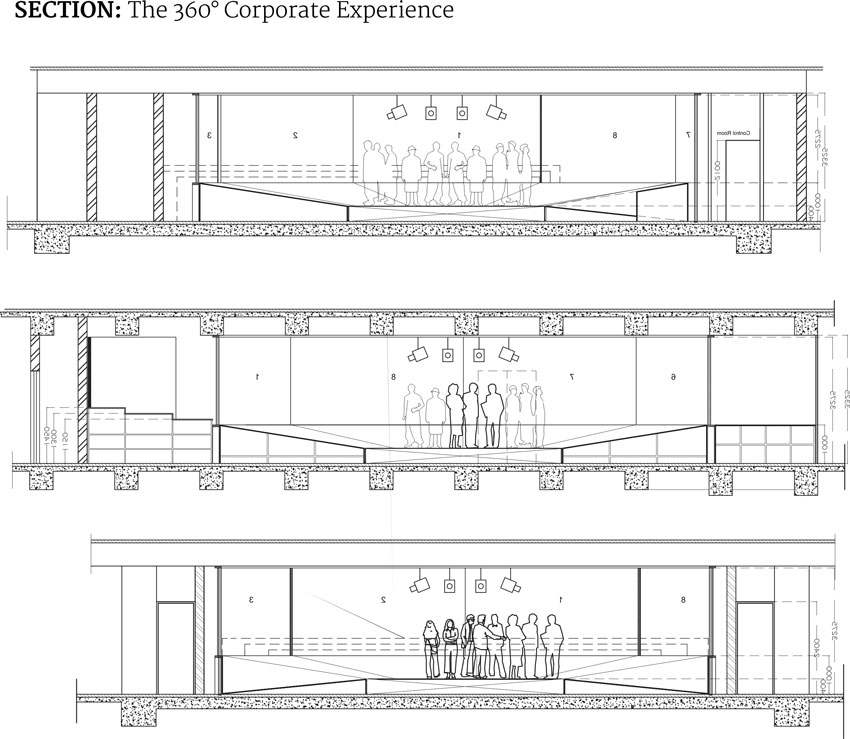
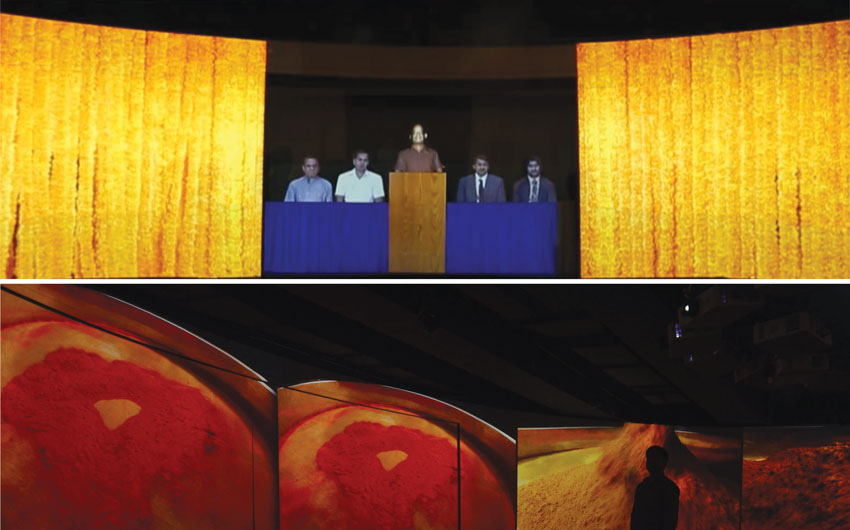
"It has been a remarkable experience to recreate the fascinating Journey of our Founders culminating to the present profile of the group. Dramatic telling of the DS Group's story is made possible by using elements from theatre, film, sound and art to create a dynamic and stunning space along with modern technology of projection, rich computer graphics, life size talking mannequins etc. to make an inspiring and gripping show for the visitors." Mr. Shashank Surana
The Treasure Room
Jewels in the Crown

Like precious jewels displayed in glass cases, the Group's products are showcased in glass cubes, each designed uniquely just like their products. A modern streetscape emerges with the geometric placement of the cubes, giving a futuristic look and feel. The walk through is non-linear and not programmed.
Zone 3:
This zone acts as a brand showcase for the DS Group and highlights the story and USP of each brand. Informative yet artistically represented, the visitors get a well rounded sense of the Group's past, present, and future. The experience of 'The Journey', the facts and information don't overwhelm the visitors but leave them with a sense of calm, inspiration and pride in the human spirit.
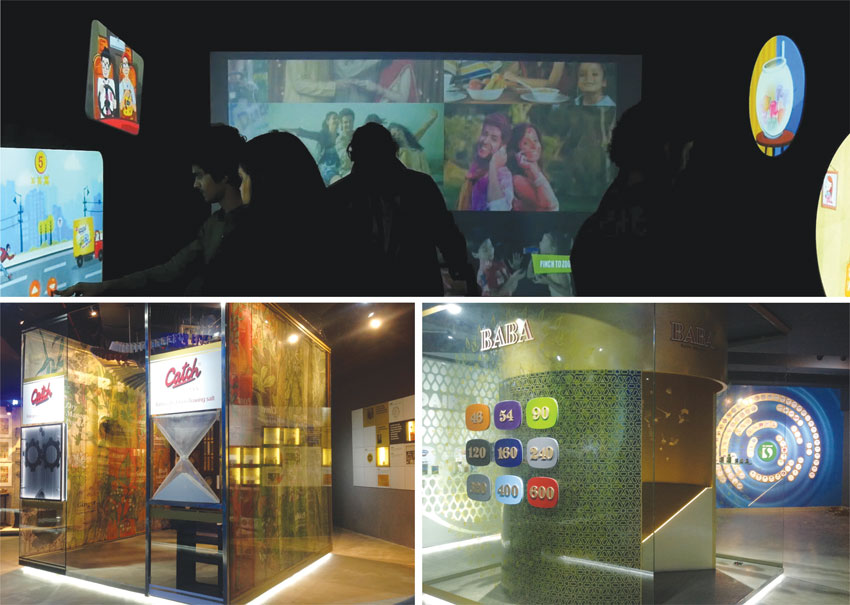
"The journey is our tribute to our founders and their fascinating Journey of steadfast principles and unmatched business acumen. The journey that stared at the turn of millennium, spanned through the length of the entire 20th century. It has been a labour of love that has taken more than a decade to research the archives and to travel far and wide to collect the material and of course a delightful decade of meeting many people who were touched by the lives of Shri Dharampalji and Shri Satyapalji." Mr. Rajiv Kumar, Vice Chairman, DS Group
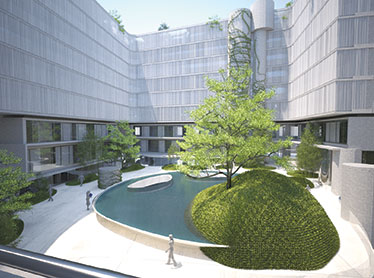
MAD Architects’ First Project in Europe is set to Start
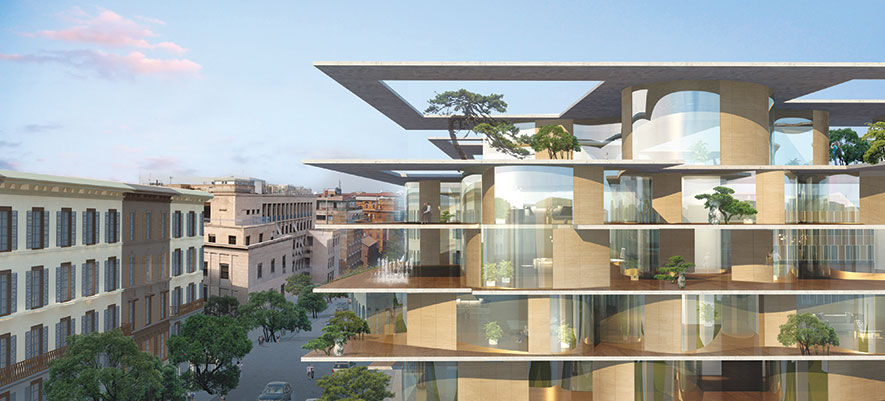
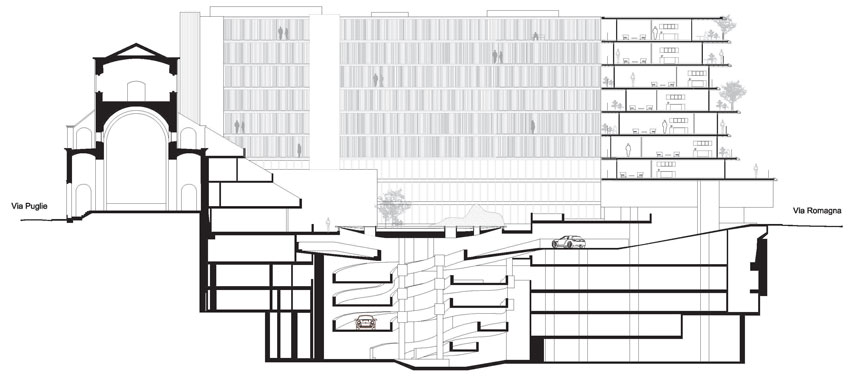
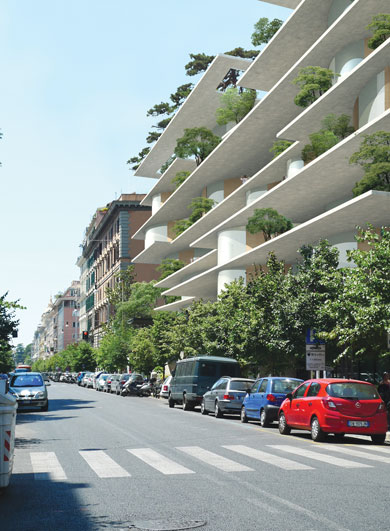
Built in the 1970's, the existing building is a commercial courtyard building attached to an early 20th century chapel located on the street corner. The primary challenge posed by the competition stage was how to transform this incongruous modern building into a deluxe residential complex.
In modern buildings beams, pillars, and floor slabs have replaced walls as the core elements of architectural structure. While freed from their structural obligations, facades still remain canvases for expression and style. Instead of demolishing and reconstructing the entire building, MAD plans to just remove the existing facades, retain the structural framework, and insert new living units to transform the building's function. New balconies and gardens will emerge from the "gaps and voids" between new residential units and the original framework structure. The boundary between the building and the street blurs as the new design peels away bulky facades and replaces them with a more open, transparent scheme.
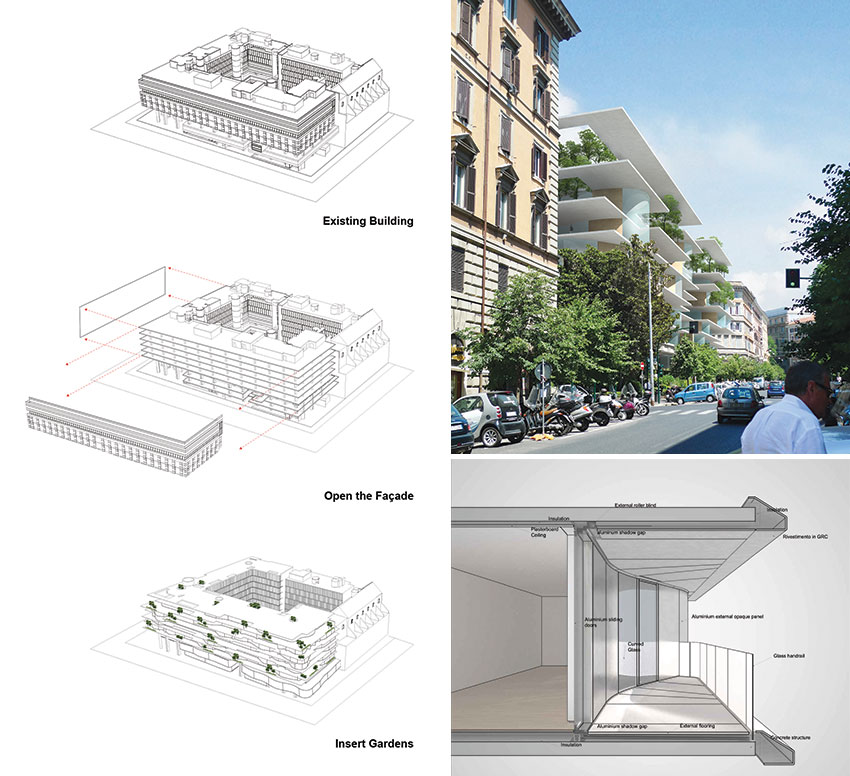
| Project at a Glance: | |
| Location: | Rome, Italy |
| Date: | 2010 - 2017 |
| Type: | Residential |
| Status: | Design in-progress |
| Site Area: | 6,268 sqm |
| Building Area: | Around 20,000 sqm |
| Building Height: | 28.5 m |
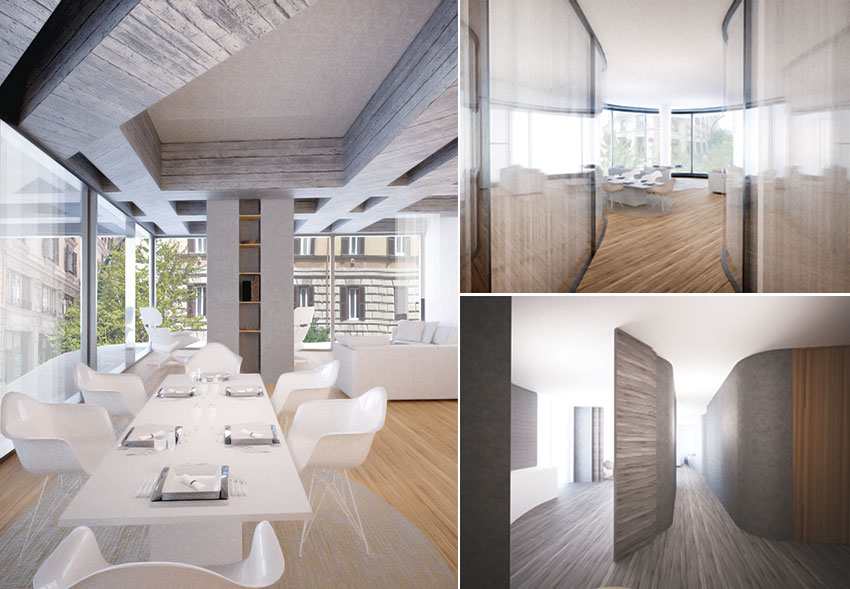
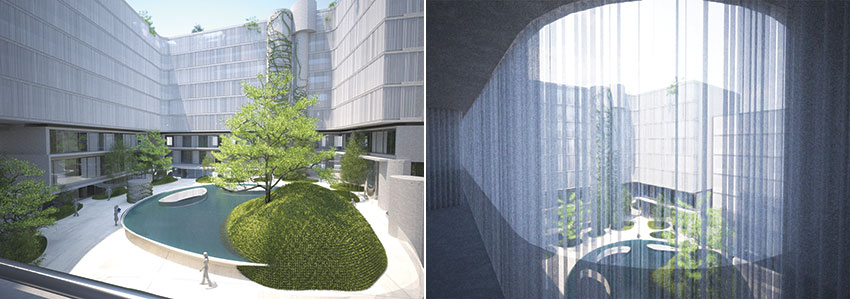
After realigning the existing structural system, the building will contain a "bookshelf" structure. 145 residential units of various sizes and layouts, ranging from studios to urban villas with facades made of custom metal and glass, will be intricately inserted into this 8-level concrete "bookshelf" system. The full height curved glass windows shift and protrude in a controlled choreography between the floor slabs. The "voids" between the glass and the framework will be transformed into gardens and balconies, bringing natural elements and sunlight into the living areas.
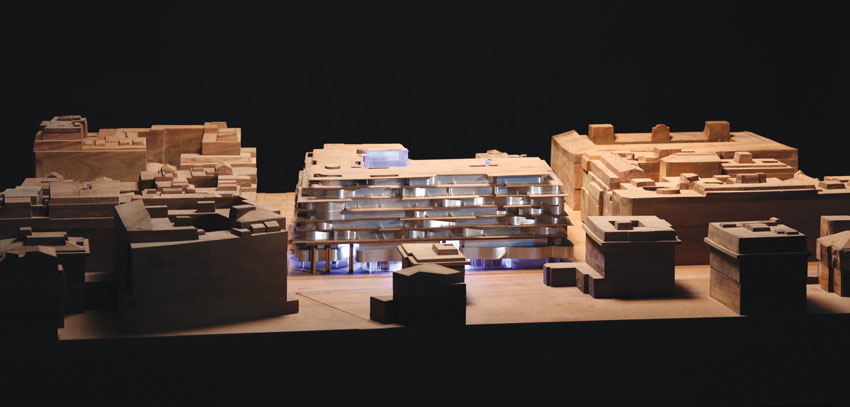
Residents can see the interior courtyard through a hazy façade made of translucent metallic curtains. The existing modern garden will be transformed into an abstract one with a vast pond at the center that reflects the bordering trees and the sky above. Natural sunlight filters through voids in the pond and the surrounding garden, streaming through to the ramp of the underground garage below.
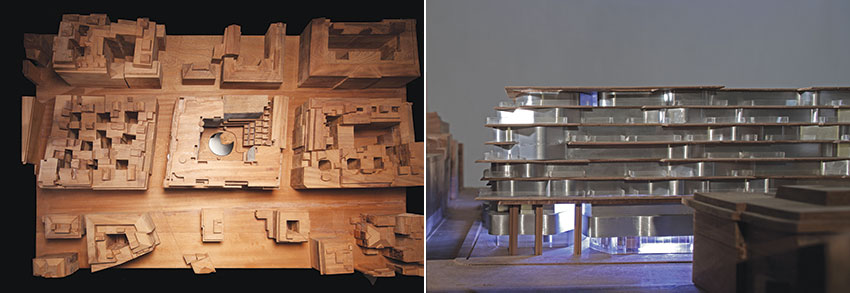
Contemporary living in a museum-like city like Rome is often hidden behind its historical facades. Through this adaptive rebuild project, this "open" building will be able to return vitality and urban living to the traditional neighborhood. The project is scheduled to be completed by 2017.
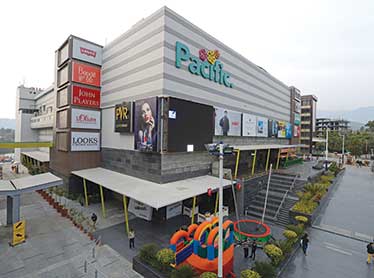
Pacific Mall, Dehradun
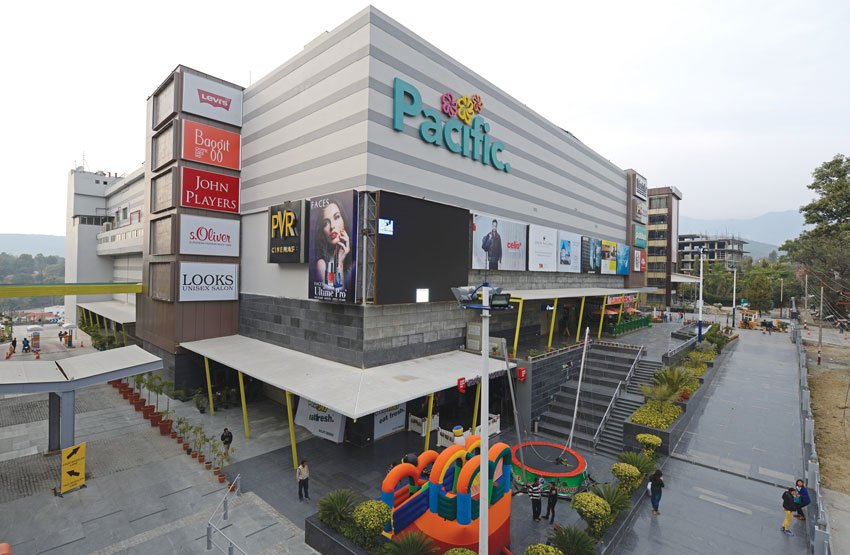
| Project at a Glance: | |
| Project Name: | Pacific Mall |
| Location: | Dehradun, Uttarakhand, India |
| Client: | Pacific Development Corporation Ltd. |
| Architect & Interior Designer: | Bentel Associates |
| Other Consultants | |
| Graphic Designer- | Satyam Enterprises |
| Lighting Designer- | In-house |
| Landscape Architect- | Dilkhush Rose Farm |
| Area: | 230,410 sq.ft. |
| Cost: | Approximate 75 crores |
The site....
Dehradun is a beautiful town that is located in the Doon Valley surrounded by the Shivalik Hills, a mountain range of the outer Himalayas. The Doon city is famous for its natural scenic beauty, which includes some visually attractive landscapes and enjoyable climate.
The three acre site on Dun - Mussourie road having an 85 m frontage with a picturesque backdrop of Mussourie hills posed quite a challenge from its topography; a 17m drop in North West side of the site.
The built mass....
The solution was to exploit the natural contours of the land parcel to be used in the development scheme. The 17m steep drop was best utilised by providing two sub structure parking levels, thus minimising the excavation required and optimising cost compared to a conventional basement. Basement area being planned along the contour is naturally lit & ventilated. A precise and efficient parking design allowed for a hassle free parking experience to the customer with a direct connectivity to and from the mall into the parking levels.
The rise of the contours on the western side of the plot allowed the design firm 'Bentel Associates' to create a mall entry at the first level of the centre in addition to the southern corner entrance on grade, offering a balanced distribution of the footfalls entering the mall. The retail needed to rise up to the second floor in order to achieve the bulk required by the product mix.
The emphasis was to create multiple gathering spaces in the centre. 10,000 sq.ft. rectangular atrium space is planned at the centre of the mall footprint that easily connects shops at each level and also acts as a large indoor promotional space. The rectangular piazza space is tilted not only to create dynamism but also to achieve variation in shop sizes required for good tenant mix. This enclosed plaza is well connected to the street at ground and first floor by long-stepped outdoor piazza and is easily accessible to shoppers.
Indoor plaza space with fashion anchors and vanilla shops is more trade-focused with leisure, relaxed and reposing ambience of outdoor piazza and restaurants, cafè makes a perfect offering.
Third floor triple volume space food court overlooking the main atrium volume is long linear street and has a view over Masuri Hills on North-West side. With large volume space, diffused natural light, and International food brands the food court is already a popular destination.
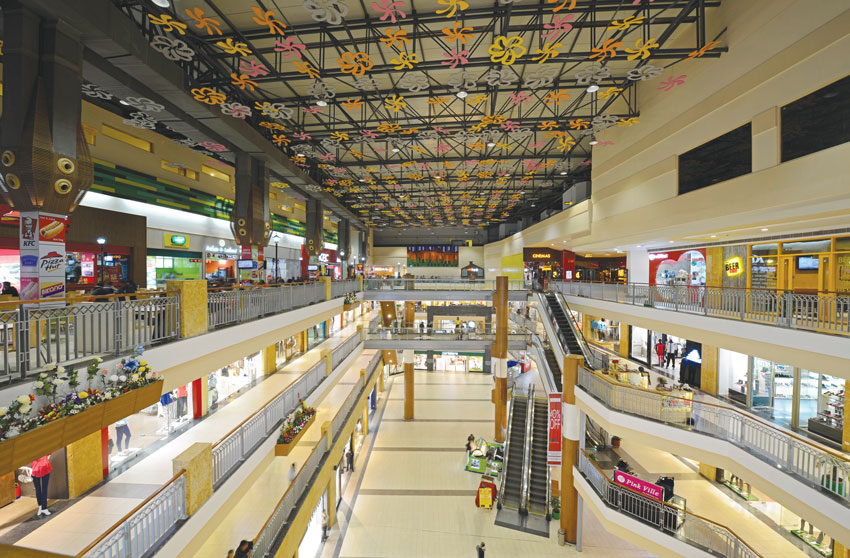
Interior Design....
Objective was to enhance concept of Large Piazza and create neutral backdrop for shopfronts. Warm colour pallet with shades of Badge, Grey and Timber is used throughout the mall.
Shopfront demising columns are expressed with natural sand stone clad. Badge matt tiles with dark granite border at shops for mall flooring, natural sandstone for demising wall and badge and white ceiling create warm feel. This is further enhanced by hardwood hand rail and timber cladding for columns and escalators.
Sandstone portal at ground level at the atrium edge and double height grey granite portal connecting two levels are few elements introduced to break the monotony of atrium Bulkhead. Coloured murals, linear colour bands above food court, flowerbeds and flagpoles add vibrancy to the overall interior spaces.
With restrictions on floor heights all services are routed within the shops to achieve maximum possible height in the mall corridors.
Triple volume space of the food court being long and narrow is conceptualised as a high street with alfresco seating. Steel columns within food court are treated as back lit timber lanterns. These lantern features along with street lights, benches, bollards and colourful flower cut-outs suspended from ceiling and hotel corridor windows at floor above, give typical street piazza look to the food court. Large volume space, diffused natural light, colour- full backdrop of murals and suspended feature, valley view are few unique attributes of this space.
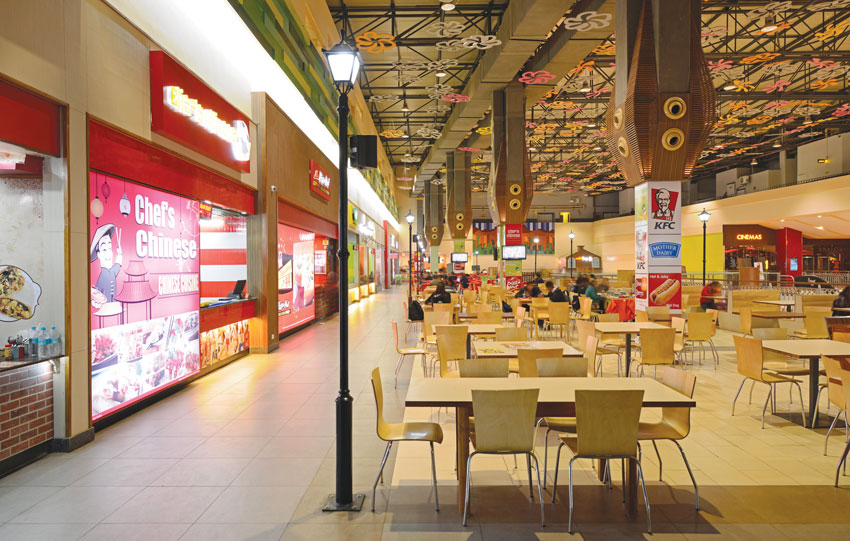
The lighting, indoor air quality and public health....
Built to maximize the utilization of natural light, the building uses a minimum of interior columns with a diagonally tilted central atrium sporting a clear storey soft roof, shading the building from direct solar radiation.At the same time, good lighting design is spread beyond the realm of visual appeal to lower the energy costs and heat gain.
The HVAC system is designed in such a manner that the outside enthalpy conditions of the city shall be used to keep the centre conditioned for half the operational time with use of minimal energy.
A sewage treatment plant to generate recycled water and its reuse in gardening and air conditioning make up are adopted in the building to conserve natural water resource and reduce refuse disposal.
The fabric canopy and signage band cut the vision angle and help in reducing the built form scale. The upper building mass is treated in horizontal plaster bands finished in alternate shades of grey.
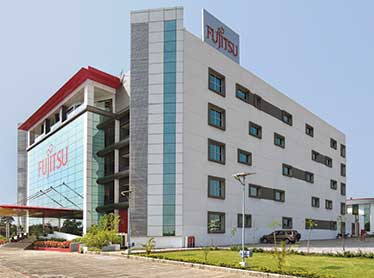
Fujitsu Software Consulting Pvt. Ltd. Pune
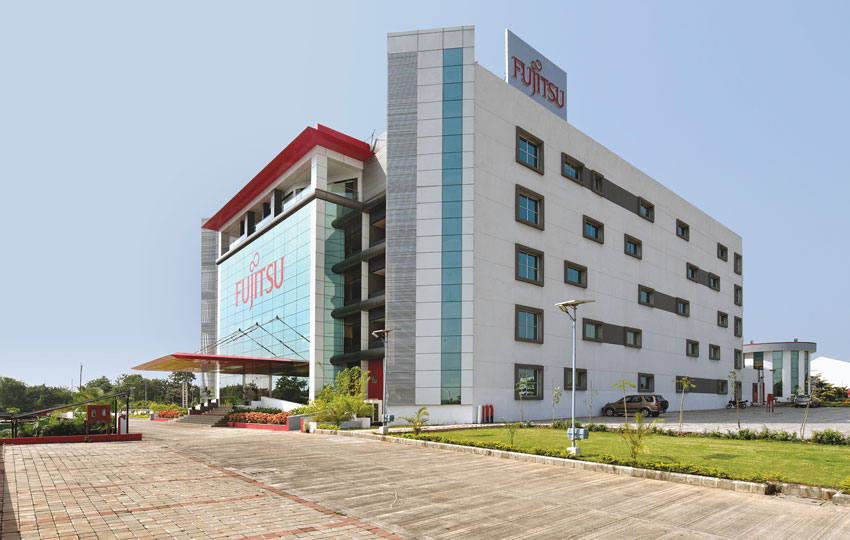
| At a Glance | |
| Project Name: | Fujitsu Software Consulting Pvt. Ltd. |
| Location: | A-15, MIDC Technology Park, Talwade, Pune |
| Architect: | Team One Architects (TOA) |
| Other consultants | |
| Structure: | Strudcom Consulting Pvt Ltd |
| MEP: | Elmark Engineers |
| PMC: | AMS Consulting |
Fujitsu, the fourth-largest IT vendor in the world and the third largest for global IT services is the leading Japanese information and communication technology (ICT) company offering a full range of technology products, solutions, and services. The company's office in India is located in Talawde, Pune amidst a well developed infrastructure.

Fujitsu shared with TOA the vision of the company and gave the team a detailed logo study. The corporate logo depicts Fujitsu's infinite possibilities. Further, it expresses expansion into the universe by symbolizing "Earth" and "Sun." Fujitsu Red, the main colour expresses enthusiasm for the future, brightness, and approachability. The above corporate identity and the corporate vision: "Understanding you better – serving you best" needed to be expressed in the design that Team One created.
There was a design competition, held to bag this project and TOA was selected because of its unique theme and design, which was curated for the brand FUJITSU. The design studio bagged the project as the management liked its intelligently placed themes, designs, and facade enhancements styling. TOA also captured the essence of creating a functional floor plate which was specially designed keeping in mind the extra FSI. The plot in which this Corporate office was built up had more FSI due to which horizontal expansion capability was a must. Fujitsu had plans to seat around 1500 employees in the office.

TOA proposed a concept to the client as a master plan along with the brief and many 3D images. The company's expansion plan was studied, and accordingly, multiple usages were determined. Since, client and management areas were designed as per the brief the entire hospitality as well as service aspect were determined well in advance considering foreign delegate visits. Extensive use of recycled materials was used even in premium areas by virtue of recycled marble flooring. The client had briefed to have a Golf Course theme at some office areas. So TOA designed a lush green patch soothing the senses and also created in and around the refreshment areas and lounges. The skylights were well spread enabling gradual but complete replacement of artificial lights. The critical and gruelling rooms such as the conference rooms, library as well as the lounge were all planned to open into this green area which obviously rendered the life to the management area. The sky lights were smartly fabricated with laminated but insulated glass to get the best of light but cut off heat from the hot summer glare. The loose furniture setting on the floor was all handpicked from the International market along with main board room furniture, sofas, cabin tables library tables. All furniture was created from recycled HDF finished with low VOC print and polish finish. The cabins were well established with open sky terraces which overlooked into the adjoining river with a picture perfect view of the horizon.

The facility also constructed multiple zones to house individual clusters of well-supported and re-worked teams. Due to the modularity expected to expand the building horizontally, the line of horizontal connect (2 main passages) were strategically kept open to enable future expansion plans, if any. State-of-the-art training rooms, well-defined data centre to suite the most critical demands of the modern day connectivity and networking are designed. The most striking highlight of the building here was the triple height atrium where a full grown palm tree gives it an earthy look.

The entire building has five (5) floors and each floor revolves around the panchbhutas or the five elements of nature – Prithvi, Jal, Vayu, Agni & Akash which have a lot of significance in the ancient scriptures. These are presented in the forms of colours, fabric, and through graphic interpretation.
Earth or Prithvi is the first of the five elements. One can touch and feel the earth element and it is further subdivided into two parts. Earthy colors and graphics are used to depict the earth. The second element is Jal. It refers to the element which resembles the properties like that of water, and also can be seen and felt. It represents the cycle that goes on in nature where water evaporates and comes back to earth in the form of rain and the smaller bodies of water combine into the bigger ocean. This representation is beautifully narrated in the paintings and few graphics in the office. There are fabrics used in specific blue colour to enhance the theme. Vayu, the third and is one of the most significant of the five elements. Like the other two elements mentioned above even this element has a perishable and a non perishable part and can be best compared to air. This again has been portrayed in exclusive graphics. Agni is the fourth element in the list of the five elements and can be most closely related to fire and associated with heat. It is again both perishable and also has a part that cannot be perished. Fire is one of the eight guardians that guard the universe. Red colour is used vehemently in the office as it is also there in the company logo and graphical touch adds to the theme. Aakash is the only element in the five elements that do not have a perishable half. It is the sky or the ether if compared to the most common thing we know around us. It is a carrier of sound energy and when you are into deep meditation you can hear the sounds of the Akash. A dash of blue has been used in the office interiors along with interesting themes related to sky (Aakash) giving it an infinite feel of progress.
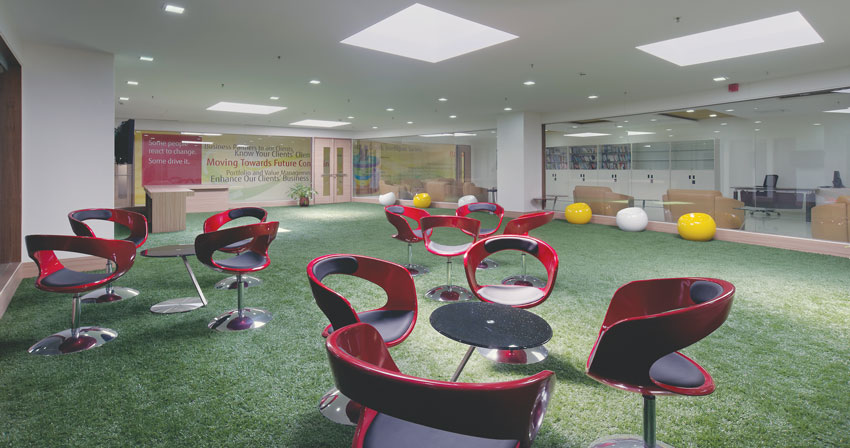
The space breathes of positivity and the vision is well crafted through TOA design in Fujitsu office.
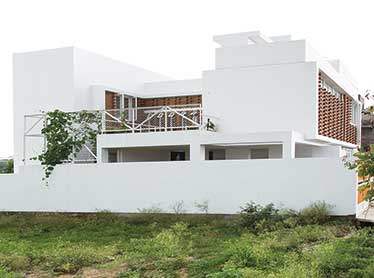
Lateral House, Bangalore
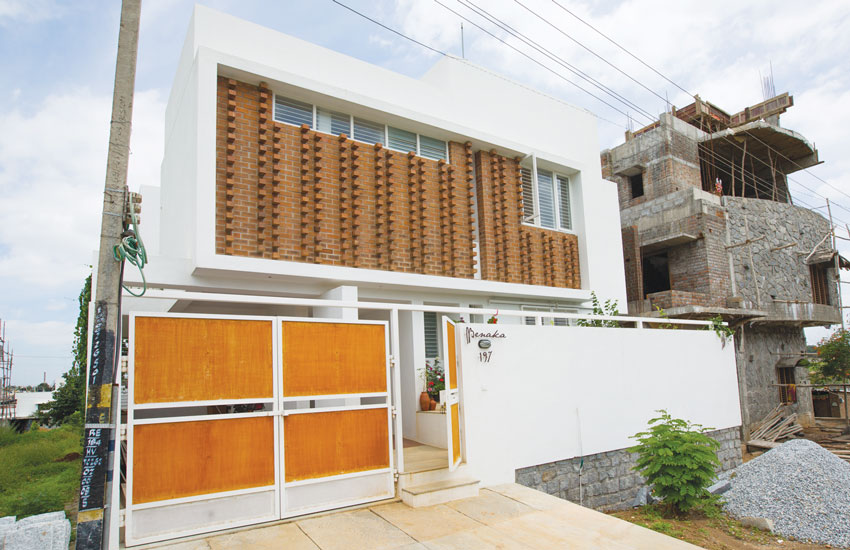
| At a Glance | |
| Location: | Uttarhalli, Bangalore |
| Area: | 3600 sq.ft. |
| Duration of Construction: | August '11 to January '13 |
| Cost of Project: | Rs. 48,00,000 (Forty-eight Lakhs) |
| Design Team: | Gaurav Roy Choudhury |
| Contractors: | Civil: LISA and Ravikumar |
| PHE: | Plumbtech Engineers |
| Elec: | ACHU P. Enterprises |
| Photo Credits: | Tina Nandi |
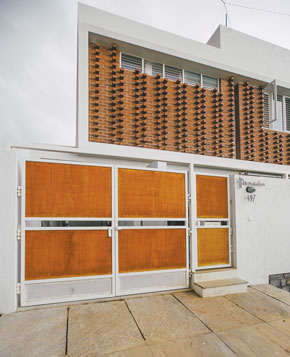
Their daily commute through the chaos of the city made them yearn for a house which also provided them refuge. The lateral house became their realm, their fortress. It blocks out the outside, making connections internally with the elements of the city that seems to be forgotten; the sky, light, breeze, and nature. These elements mix in balance and benevolence through the house to create the playful and dynamic realm they wish to haunt.
The house has been conceptually developed into imaginary concentric lines of varying privacy, starting from the outside to the inside. These lines become experimental interfaces to manipulate volume, space and proportions. The interplay between the lines becomes the basis for the shifts in spaces, as they get deeper and more private in the house.
The entry volume of the house at the higher level is robust and guarded. The bricks on its face act almost like a mirror to the outside, seeming to say a lot but the same time say very little. The car park is in a line under the volume, and a pedestrian ramp pierces into the fortress as a gesture of cautious welcome. As the ramp gets higher, it leaves the car park below and reaches the entry porch. This is where the main door of the house is located. Above this, unknowingly the visitor is surrounded by a courtyard at the upper level, where windows wrap around to see who's come. Thus, the visitor stands at the centre of the house, but still remains on the outside.
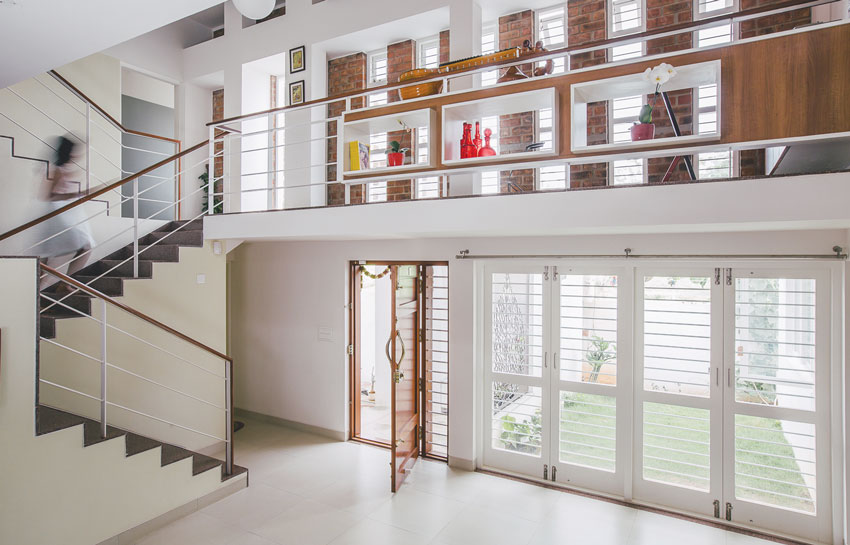
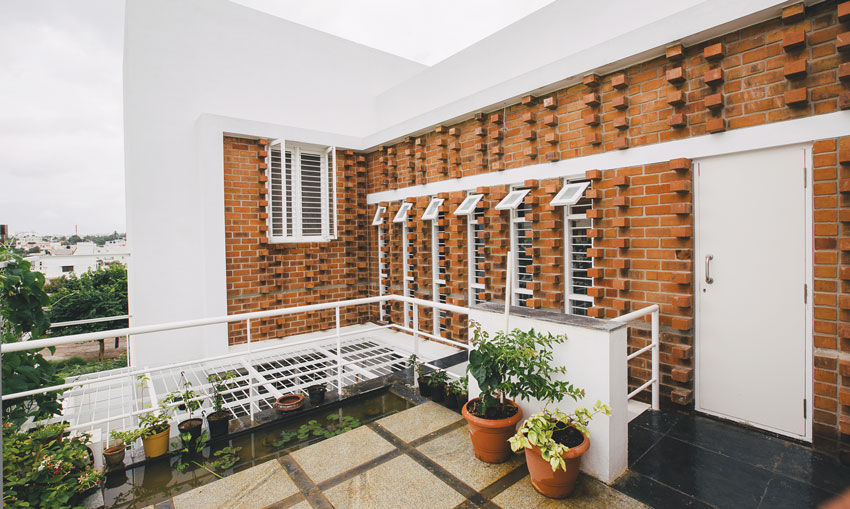
As you enter the house, the square-ish living space is framed by the low roof of the study above; the light from the study illuminates it. This is the public space of the house. It opens into the guest bedroom, dining, public garden, and kitchen. At the mid-level above is the study, which one can see but only as much as allowed. A look up will show the layers above without revealing much, this is layer one.
The staircase weaves up and as it climbs, it slowly becomes the element which expands the space and reveals the other layers. The second layer includes the study, and the family guest bedroom. This space combines with the courtyard above the car park and becomes the second layer of spaces. The study and the bedroom overlook the courtyard and at this level, the upper corridor is also seen, but the private bedrooms are withheld from view.
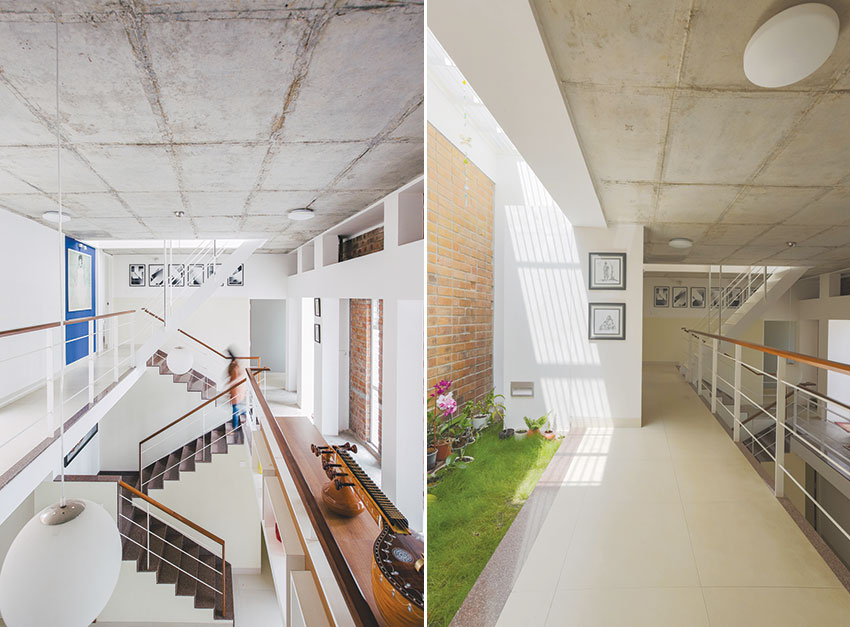
Another flight up the staircase becomes a longer rectangle from the square than it started from. This level opens into the family bedrooms and the private spaces of the house. The corridor looks through the study below the courtyard and the small private garden becomes a space for sitting and contemplating. This becomes layer three. This layer combines beautifully with layer two to create an elevated social bubble which hovers over the public spaces of layer one. The children's bedroom overlooks onto the courtyard while the master bedroom overlooks on to the road. This space becomes the heart of the house, very robust and yet transient in its nature. It gets everyone together, yet pushes for personal privacy.
The courtyard above the entry becomes the centre of this space. A private space, which is visually hidden from layer one and the outside. The house breathes through the space and it makes the house impervious to development close to it as it captures the elements and seeps it into the house in various measures. The bricks again leave the courtyard creating shadows and caricatures of the elements outside. The Lateral House experiences every day and every moment in its difference. Its aloof premise is converted into extreme sensitivity towards what's around. The light changes, the breeze changes, the internal reflection changes as per the condition outside. The house breathes much like an individual as it sustains ideologies and beliefs on which it is based.
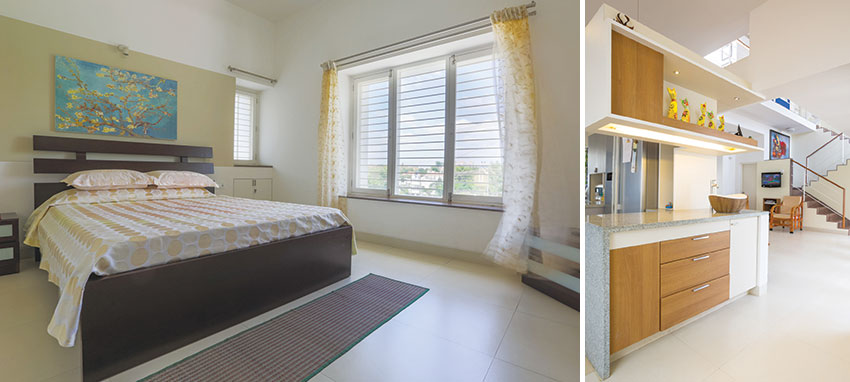
The white exterior and interior of the house enhance its shades. The bricks projecting in a grid on the external faces do the same but in a more surreal exchange. The grid of the bricks is derived from the internal space of the courtyard and is expressed almost in a code on the outside, as a mark of the house's nature.
The Lateral House is also self-sufficient in terms of usage of energy as it uses natural light in the days and circulates the air through the stack-effect reducing almost all use of mechanical means to stimulate the conditions inside. Its gardens are grown with recycles rain water as it collects and sends it back into the ground. Thus in short, the Lateral House embellishes itself with simplicity and subtle beauty.
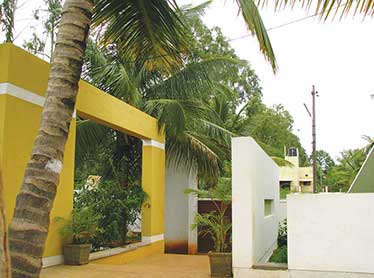
Weekend Home for Dube, Bangalore
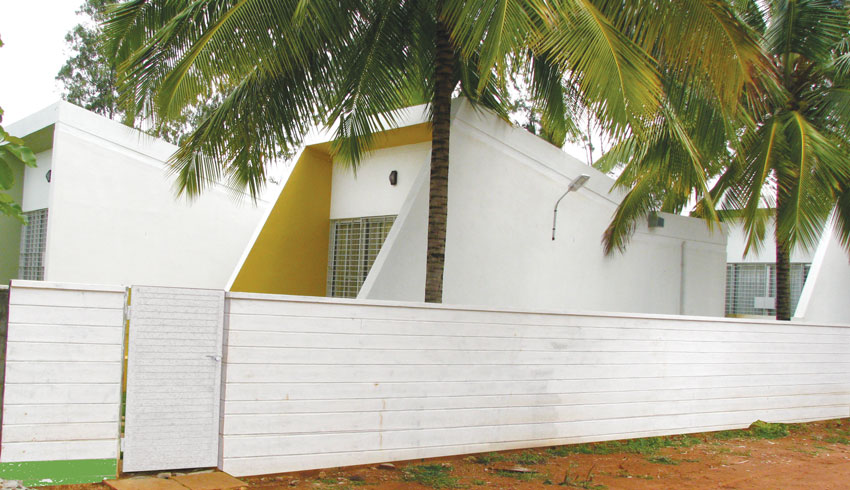

Dube which is a family of 6 and is into business of manufacturing of testing machines catering to various segments like Aeronautical, Automobiles etc has approached enso Architects to build a weekend home on the piece of land they had at Shantiniketan on Hessarghatta road to spend weekends away from city limits and to entertain their family friends there.
| At a Glance | |
| Project Name: | Dube Weekend Home |
| Location: | Bangalore |
| Architect: | enso Architects |
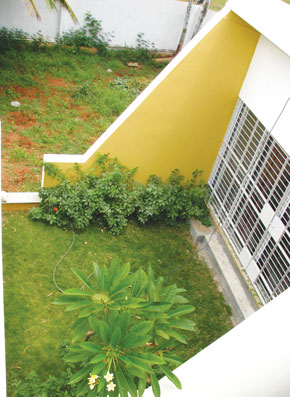
Concept: The fact to design a weekend home forced the architectural firm to think differently in the sense like what they would love to do during weekends or when they are away from the work on holiday. This helped enso Architects in coming out with the layout.
This structure is laid along north and south axis. With every room opening to north or south sides to use the diffused light, this structure is divided into two sections. First one consisting of a living room with two bedrooms and the other section consists of a family room with a bedroom and kitchen and dining.The first section could be used only when one family (smaller group) wants to stay there with access from outside to the kitchen.

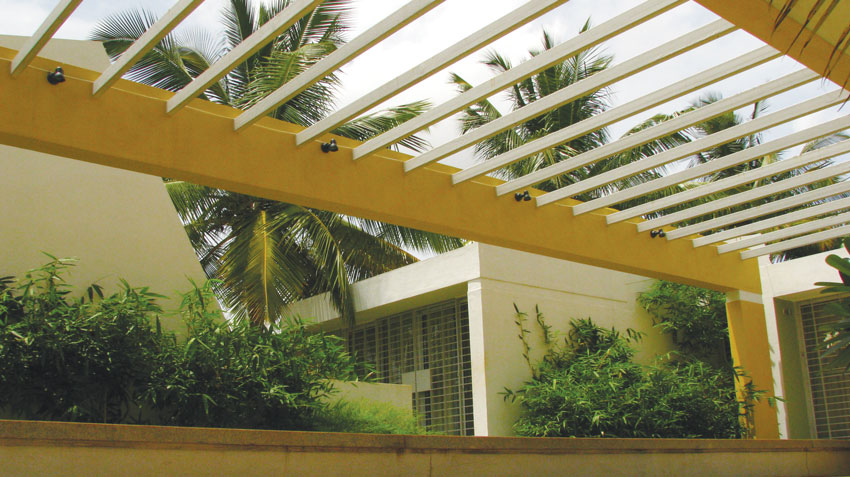
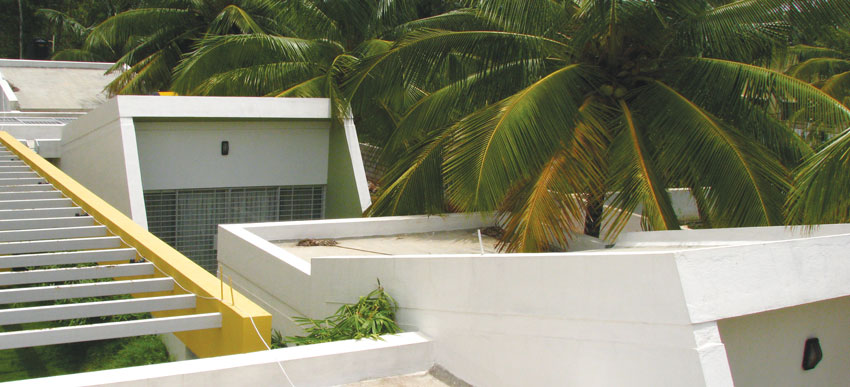
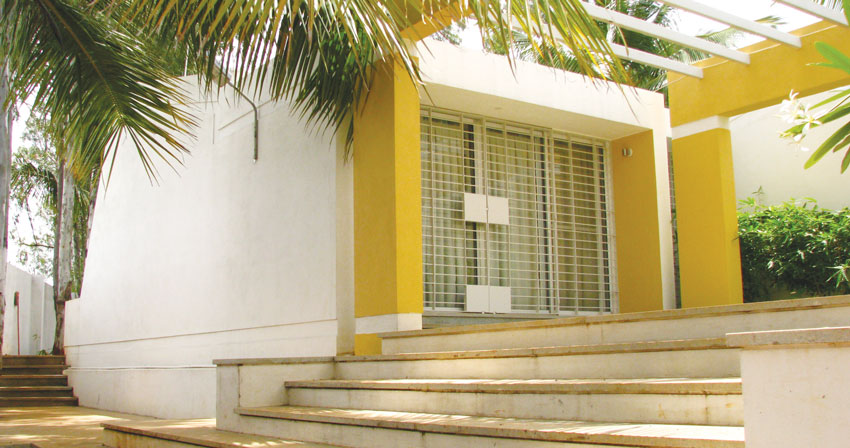
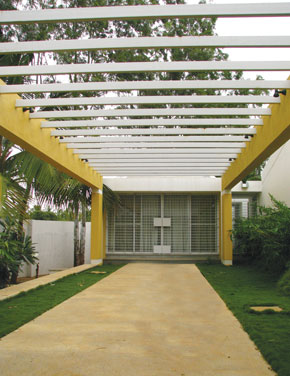
The whole idea was to give them spaces where outdoors became part of indoors. This was achieved by placing private courts adjoining every room. This allowed them to walk out to courts straight from their room. The scale of these courts is smaller so that they give the occupants the required private space in the outdoors. Apart from the various smaller courts, there is also a central larger court (gathering space).This would help them in case of a larger gathering to host some activities.
Since the requirement was only for a ground floor structure, enso Architects had come up with an interesting form that gives the clients a sense of larger volume. The architects did not want it to look like a single level flat but it should give a feeling of a home. This was achieved by working with sloped roofs stretching out to give a view of the green outside and the sky above.
The architectural firm has given a kind of dynamism to this structure, which was not possible to achieve by just treating it in a regular ground floor like structure.
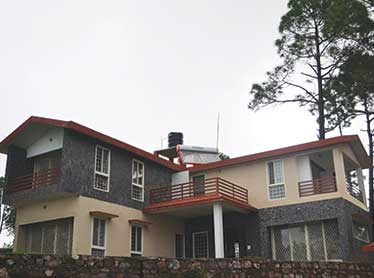
The Hill Haven Sattal, Uttarakhand

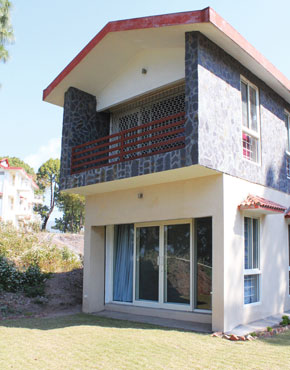
The cottage is sited at the peak of a hilly area, with a glorious view of the valley. The built form is designed to optimize the views of the valley and to provide maximum open space for the inhabitants. Being a holiday home, the house is planned with common spaces in an open-plan format, with private spaces as well. Each space is designated to have a valley view-hence, multiple spaces are created such as private balconies, common verandahs and a porch to enjoy the weather, the rains and an open terrace to sun bathe. The ground floor houses the common activities, where the family can spend leisure time together, cooking and eating, whereas the first floor accommodated the private spaces.
The building is designed as a concrete framed structure with brick infills as walls. Locally available stone cladding has been done on the façade to blend with the existing environment. The entire construction has been done with the help of local craftsmen to use their skills and to generate work for them in that area.
The site is well equipped with solar panels for solar water heating and rain water harvesting pits, keeping in mind the energy and water conservation. Onsite vegetation has been maintained and preserved.
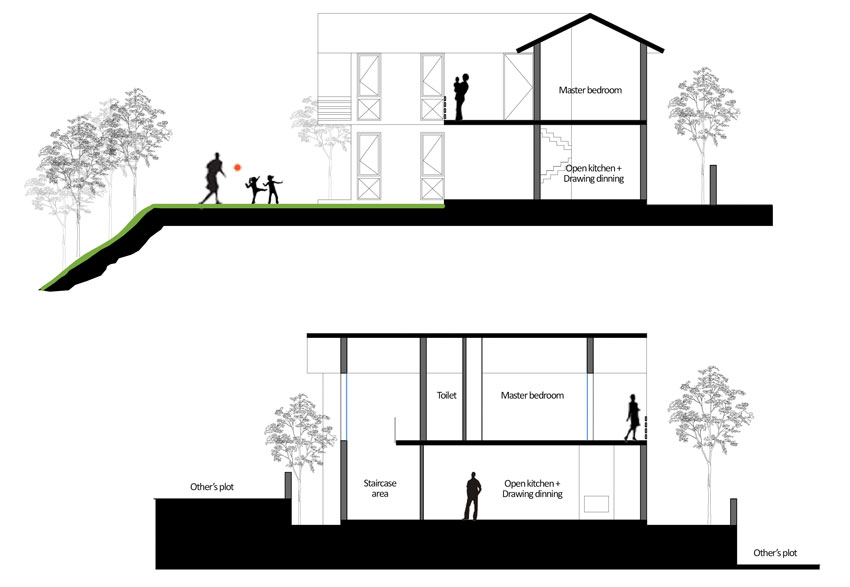
| Project at a Glance | |
| Project Name: | Hill haven |
| Location: | Sattal, Uttarakhand |
| Architect & Interior designer: | mold design studio / Anika Mittal |
| Material Specifications: | Brick, concrete, locally available stone used for facade |
| Commencement Date: | June 2011 |
| Completion Date: | Jan 2013 |
| Building Area: | 1930 sq.ft, |
| Site Area: | 250 sq.m, 2690 sq.ft |
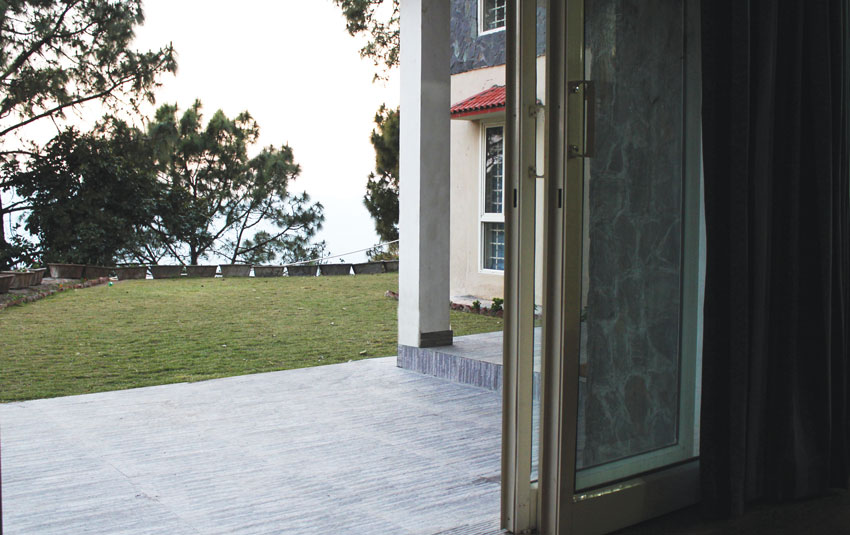
The house has been designed to respect the site conditions. The spaces are designed in such a way that each space opens out onto expansive views of the sun set and the mountains. The design of the house has been thought through to achieve cross ventilation throughout the day and therefore there is no need for air-conditioning in peak summers also.
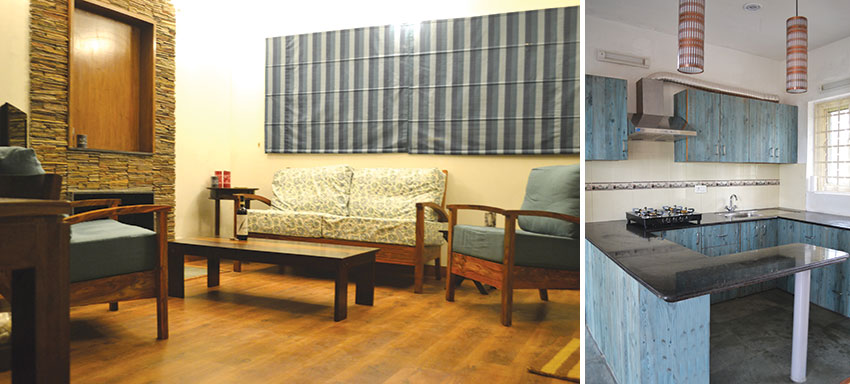
The intent of the interior design is to provide a cozy modern rustic cottage feel to the spaces. The flooring for most of the spaces is done in wood which is a classic; it also adds warmth and character to the interiors while keeping the floor warm during winters. A natural wood fireplace, built from locally available material is created in the living area to enjoy the wintery nights, looking out into the valley. The house has plenty of daylight during the day and only requires artificial light during the evening/night. The sloping roof has been highlighted in the interiors in the bedrooms on the first floor which also helps in providing higher heights and bigger volumes. The landscaping has been kept fairly simple with a large garden and flower beds, to keep the emphasis on the natural surroundings and bring in nature into the built volume.
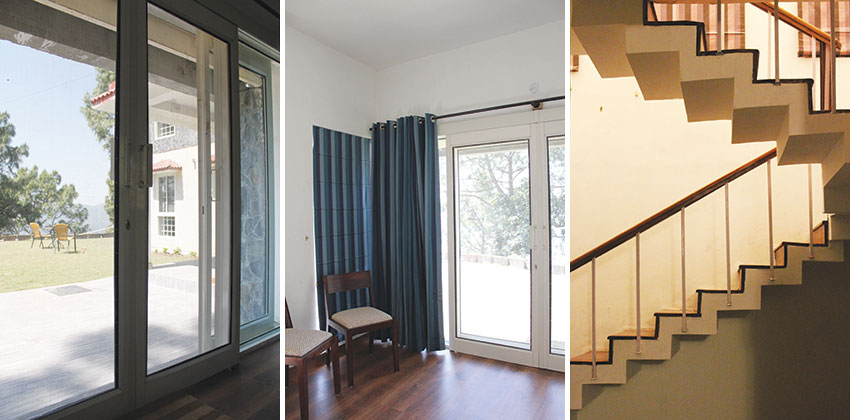
As a home away from home, the house is designed around the needs of the family, whilst blending beautifully with its surroundings and context. Simplistic in Design and materiality, the house is equipped with all facilities.
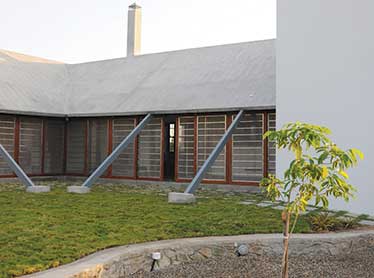
Wind House, Gujarat
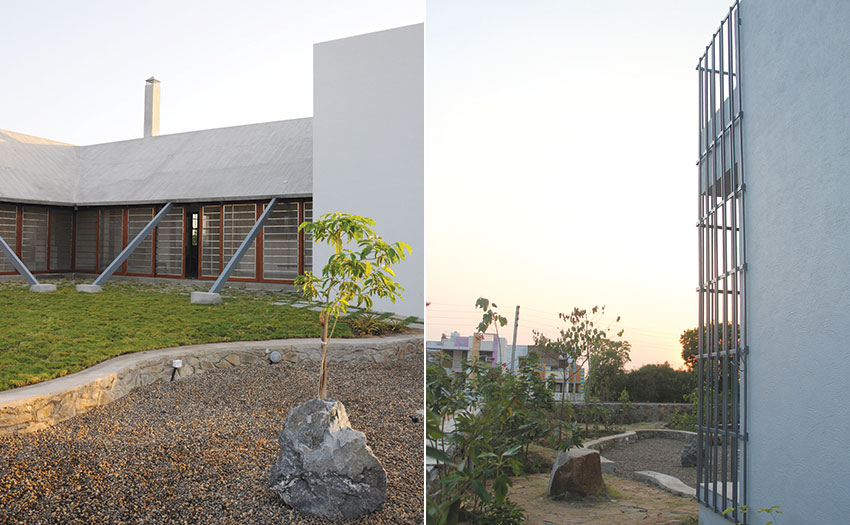
| At a Glance | |
| Project Name: | Wind House |
| Location: | Gujarat |
| Architect: | banduksmithstudio |
banduksmithstudio has recently completed a residential project 'Wind House,' in Deesa, Gujarat. A multi-generational family of eight asked for a straightforward house that would naturally withstand the harsh climate conditions of northern Gujarat and weather well over time. In line with their clarity of mind, they submitted a list of their specific requirements, which outlined the way that they needed to use their home, and their expectations of a durable, well-built and simply designed structure.
As a response to the aspiring family, the project works to balance, innovate design ideas and methods with the traditions important to their lives and the locally available construction skills, material and knowledge. Integrated into the landscape, the house inhabits a corner site near a series of twin bungalows. A low profile with articulated volumes allows the house to merge with the scale of the surrounding homes, feeling at once both expansive for the family and in conversation with the neighbourhood.
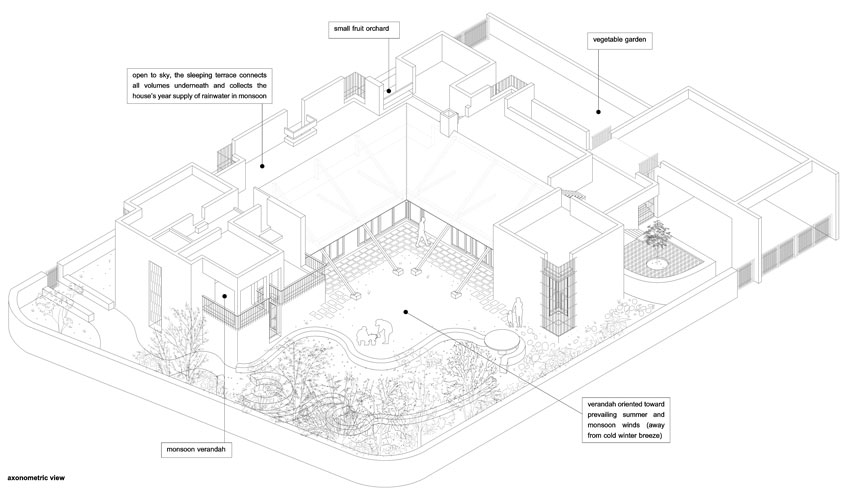
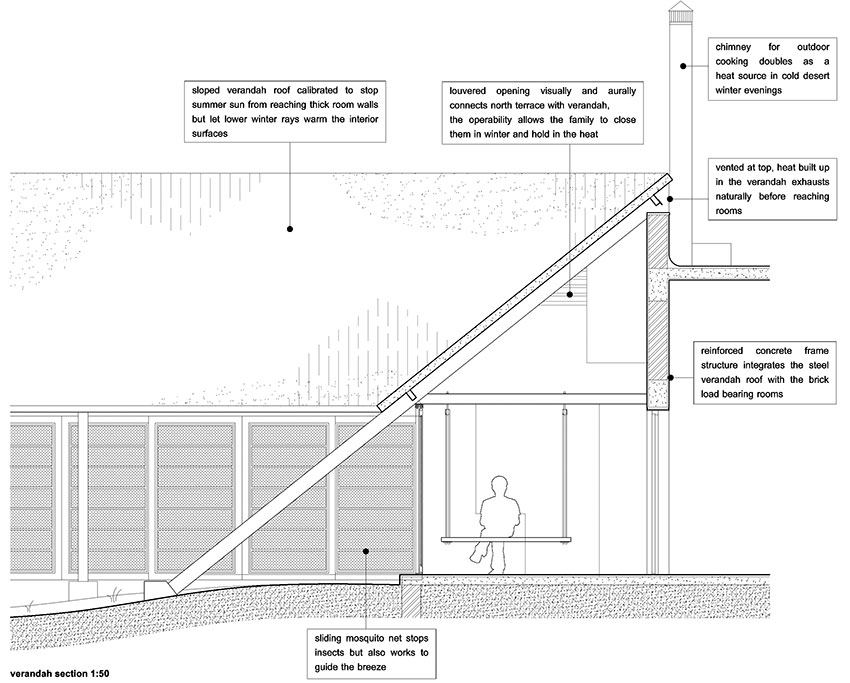
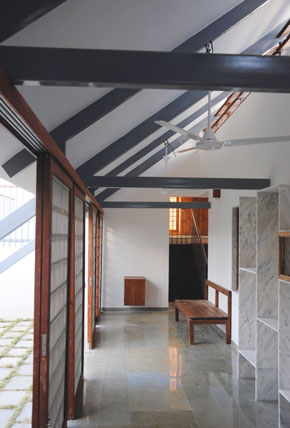
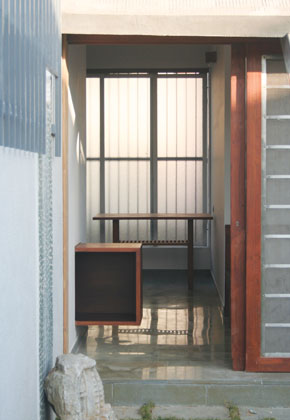
The verandah is the heart of the house. All rooms and all levels empty into it, and it mediates the experience between inside and out. Because much of the family activities occur in this intermediate space, what might have become a passage instead is a place.
As a climate responsive element, it absorbs and exhausts the heat of the summer, welcomes warmth in winter, and encourages the movement of air in muggy monsoon. The high summer sun cannot reach direct room walls, and the sloping roof with ventilated openings at the top allows the hot air to rise and naturally exhaust, moving it faster by allowing negative pressure behind the thrust of the wind moving up the verandah surface to draw air out faster. In winter, these openings, which are fitted with operable louvers, can be closed to hold in the hot air. The fireplace in the verandah also adds to radiating heat in the space. In monsoon, and on summer evenings, gaps between the room clusters open to draw air through the space, cooling both the verandah and the outer surfaces of inside rooms.
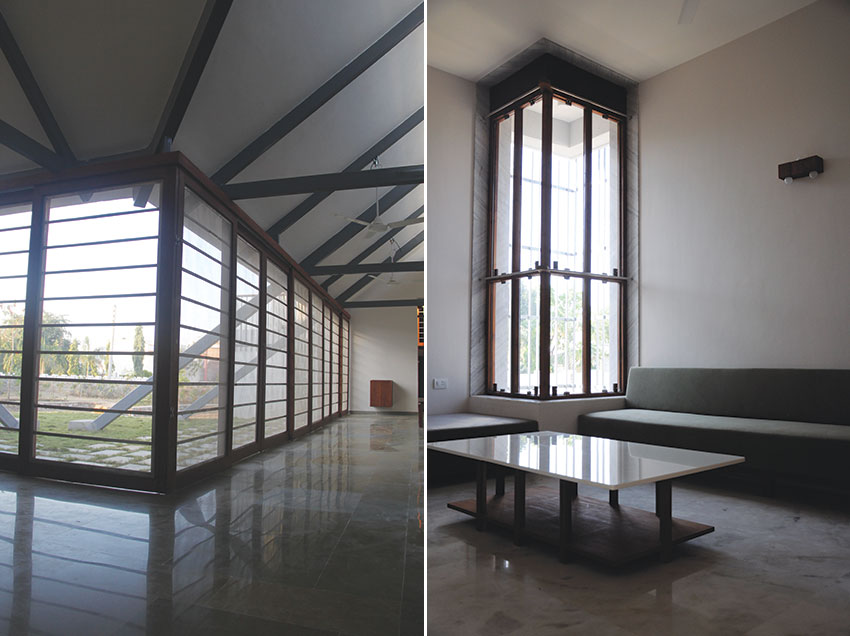
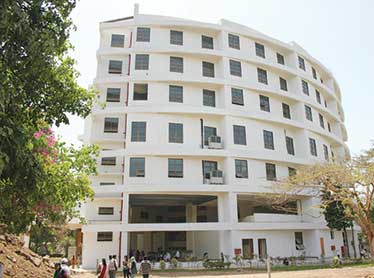
S. K. Somaiya College Vidyavihar, Mumbai

Access Architects was involved in the Architecture and Interior Design for two colleges on the SomaiyaVidyavihar Campus. The architecture focuses on creating infrastructure at par with the best in the country to provide students with tools necessary for success. The atrium along with specially modulated shutter type windows in the stepped auditoria style classrooms facilitate cross ventilation. This ensures that the spaces arecomfortable even in the middle of summer. One thing that both the client and the firm felt the place needed, was some soul to the building. After all it was a college building and it would be great if it can create aconnect with the students.
The firm took on the role of creating graphics and spent a month in the shoes of a Graphic designer to develop 89 artworks from scratch. These ranged froma 4.5 m tall Ganesha, welcoming one into the building, which transforms into a wonderful quote on education by Aurobindo – after whom the building is named.
The Atrium has on its walls, Mahatma Gandhi with a famous quote by him and is populated by smileys, a connect between our rich past and the present.
The public spaces were given special attention, with each of the toilet signages, staircase, and lobbies receiving special attention. The client, Samir Somaiya, took active interest and whole heartedly supported the endeavor, adding quotes and inspirations from multiple languages, as the project took shape in an extremely constrained timeline of 45 days from concept to installation.
The new building of S.K. Somaiya College of Arts, Science & Commerce' has been named Aurobindo. The design is based on Access Architects' philosophy that is based on facts, experience, and personal realization. It blends the spirituality with reality. The structure was built with the need for ample cross-ventilation and the infiltration of natural light for the most part of the day. A large atrium was designed for students to relax with an area for quiet studying too. The ground + 7 storeys building consists of various facilities including a Seminar hall, a Canteen, and a huge library. The classrooms has congressional seating (seating at different levels within the classroom). The building has an internal overlooking courtyard covered with tensile roof & designed with an idea of connecting the internal spaces with the surrounding & external landscape. Each floor has been given a different identity with the use of various color combination.


| At a Glance | |
| Project Name: | S.K.Somaiya College |
| Location: | Mumbai |
| Architect: | Access Architects |
| Client: | Samir Somaiya |
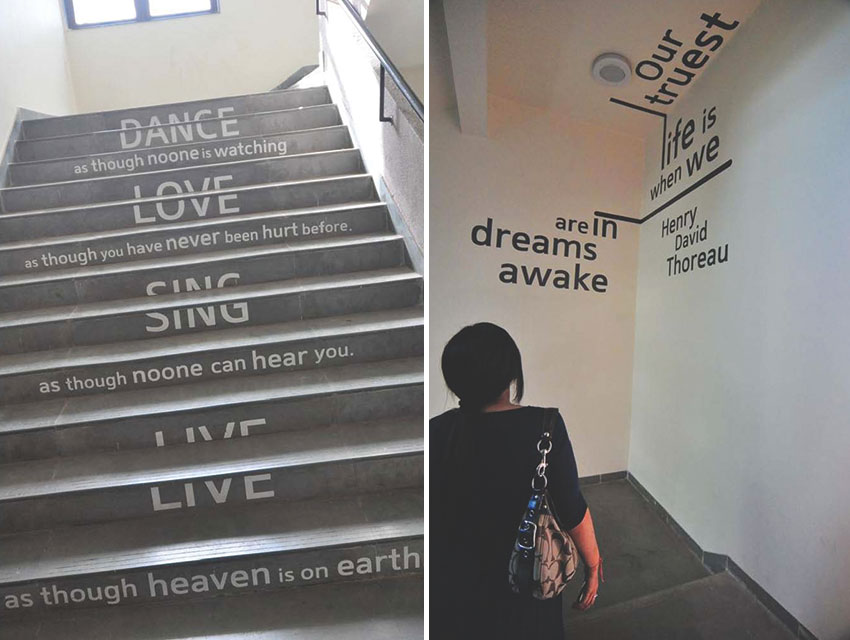

A testimonial from Sangeeta Kohli, the principal of Somaiya College
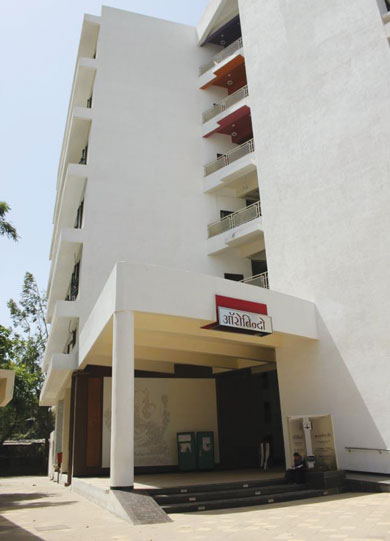
Not only the stakeholders and occupants but every visitor to the institute has always had words of great praise for the structure design and ambience of the building. The large atrium of the building is used multipurpose and adds to the grand look of the building. The high point of the design is the innovatively designed graphics to project motivational quotes, which not only become a good regular reading for students but also add to the decorative look of the structure. Current day youth definitely looks forward to quality teaching but at the same time also demands modern infrastructure and facilities. In this direction, this new building has been a good attraction point and one of the reasons for rising number of student admission in this college. We would like to thank Access Architects and Jay for working so hard and making this a dream come true for us here in Somaiya College".
Currently, Ar. Jay is working on the Affordable Housing projects in Mumbai and in the near future he looks forward to working with more like-minded clients who are continuously looking for innovation in design.
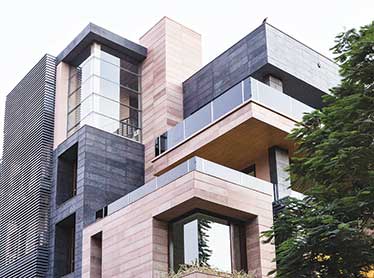
Cuboid House, New Delhi

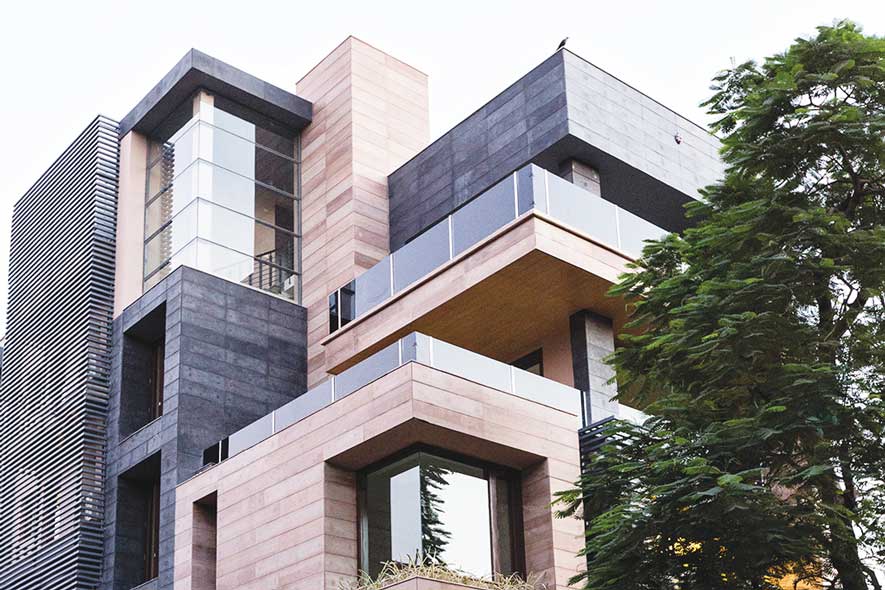
| At a Glance | |
| Typology: | Houses |
| Name of Project: | Cuboid House |
| Location: | New Friends Colony, New Delhi |
| Principal Architect: | Amit Khanna |
| Site Area (sqft&sq m): | 4500 sq.ft. / 418 sq.m. |
| Built-Up Area (sqft&sq m): | 15000 sq.ft. / 1394 sq.m. |
| Start Date: | Feb 2011 |
| Completion Date: | Oct 2012 |
| Photographer: | Akshat Jain / Amit Khanna |
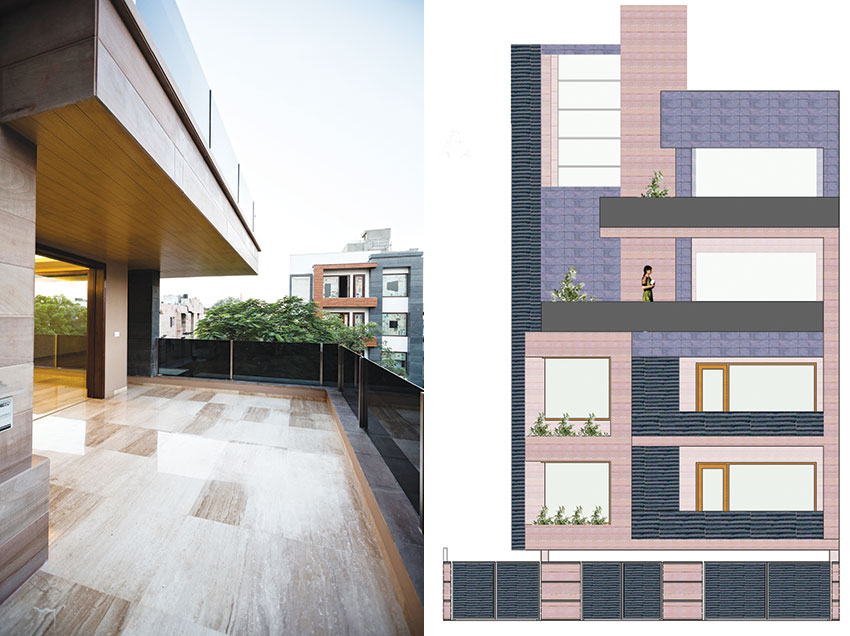
The project attempts to demonstrate the possibility of affirming some 'principles'; some elementary yet precise rules. A series of spatial sequences are structured around minimal architectural events distributed throughout the house. These events are meant to be merely the background for the life of the future occupants and therefore recede into an almost imperceptible variation of light and shadow.
Developer-driven apartment blocks have completely overtaken the immediate context and most of urban Delhi. These apartment blocks typically occupy the complete permissible envelope and then embellish the peripheral walls with whatever is currently most fashionable. The resulting urban condition is one dominated by forced facades that are 50ft/15m tall, punctuated only with unusable three feet balconies and large expanses of inoperable glass with little or no protection from the climate.
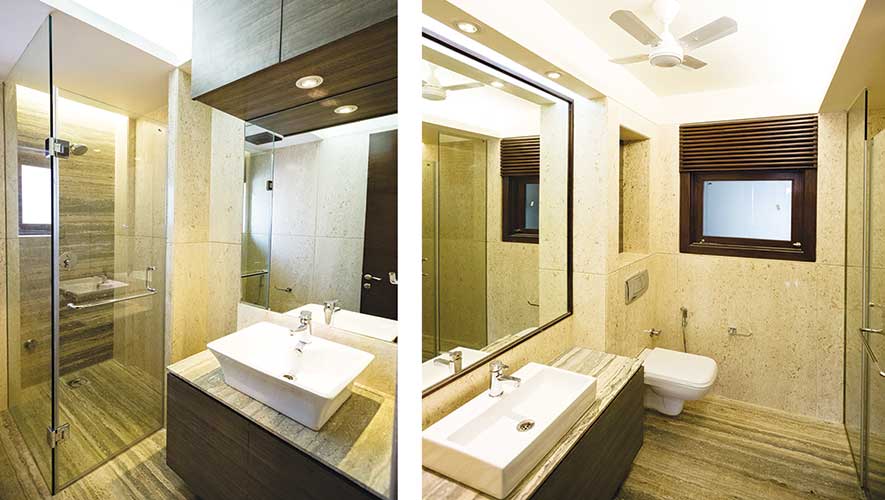

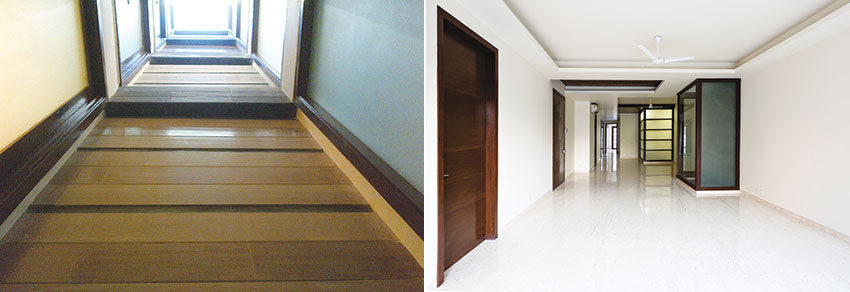
In contrast, the Cuboid House strategically optimises all of the area permissible by local code, but redistributes it amongst the various floor levels. The lower service floors are extended to the perimeter to allow for a larger ground floor and to maximise the parking at the road level. However instead of stacking upper plans above each other, the building steps away dramatically as it rises, giving way to a series of decks that open up to views on the north-east.

This strategy helps bring light deep into what is essentially, a narrow thin building. To further add to the luminosity of the interior spaces, two light wells are placed in the main living space. Equipped with operable windows, they not only bring light, but also draw out air from the floors and vent from the terrace. The deep recesses for the windows and large overhangs temper the fierce climate of Delhi and recall sustainable building traditions, while allowing for views from within. Two local stones, one grey (cudappah), the other sandy brown (jaisalmer teak), are used to emphasize the cubic volumes that give this house its name and form its most distinctive visible element.
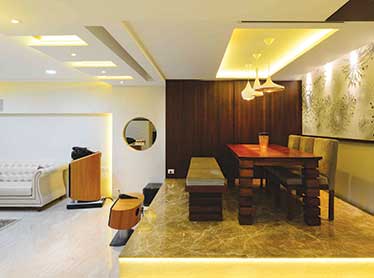
Upadhya’s Residence - A Perfect Mix of Modernization & Automation

Designed by Mumbai-based architect and design firm Jagdish Mistry & Associates, the apartment of Mr. Upadhya (well-known in the metal industries) is spread over 2000 sq. ft. area and encompasses three bedrooms, a living room, dining room, kitchen and balcony. The residence is shared by two brothers and their families who have a keen eye for detailing, personalizing and high-end luxury products.
The highlight of the design is the clever play of lights and meticulous effort put on the detailing of the wall treatments. The all-white color palette forms the perfect base for the exquisite upholstery and lighting. The living room is beautifully designed with two Chesterfield sofas, a matching center table and a home theater system along with a projector and screen concealed in the ceiling. The living area is abundant with indirect lighting. The focal point of the area is the wavy patterns on the back wall.
The dining area has been designed in a rustic way with veneer finished six-seater tables and grey upholstery chairs. The wall parallel to the dining table has been treated with abstract floral patterns.
The theme follows in the bedroom as well as with vibrant upholstery, white wash walls, laser cut panels on ceiling and walls along with window drapes. The door handles are specially designed to give it a personalized feel.
The entire décor is highly inclined towards modernization and automation.
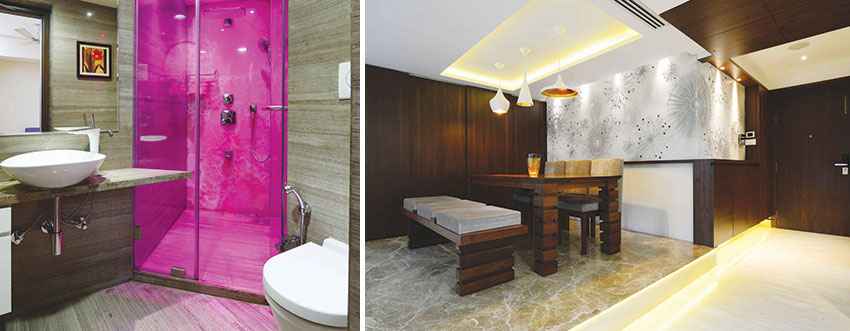
| At a Glance | |
| Project: | Residence |
| Location: | Hiranandani, Powai |
| Area: | 1800 sqft |
| Client: | Mr. Upadhya. |
| Architect/Interior Designer: | Associate Arch Pooja Nerula and Arch Jagdish Mistry of Jagdish Mistry & Associates. |
| •Cladding: | Classic Marble Company |
| •Window, Doors & storage: | Jadvani & Associates |
| •Tiling & Flooring: | Classic Marble Company |
| •Wall coverings: | ShreejiInnova |
| •Paint: | Asian Paints |
| •Lighting: | Tulip, Vis a Vis & Hybec |
| •Furniture: | Jadvani & Associates, Avni Surfaces |
| •Bench top: | Classic Marble Company |
| •Kitchen fixtures & furnishings: | Stosa |
| •Basin: | Lafontana (C.Bhogilal West End) |
| •Taps/ Faucets: | HANSGROHE (C.Bhogilal West End) |
| •Shower: | HANSGROHE (C.Bhogilal West End) |
| •Toilets: | TOTO (C.Bhogilal West End) |
| •Bathroom Accessories: | Kich - Neki |
| •Veneer/Wooden flooring: | Jalaram Veneer |
| •A.C: | Daikin (Univac environment systems Pvt. Ltd.) |
| •Accessories: | Client & Architects Team |
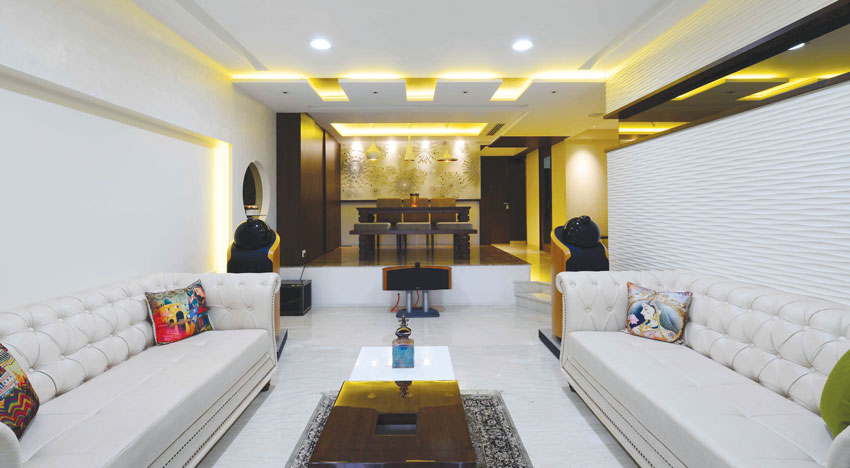
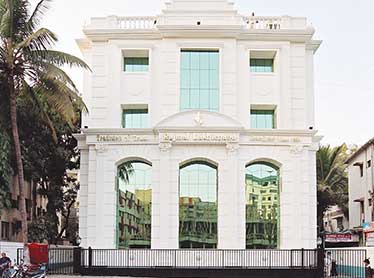
Rajmal Lakhichand Jewellers, Pune
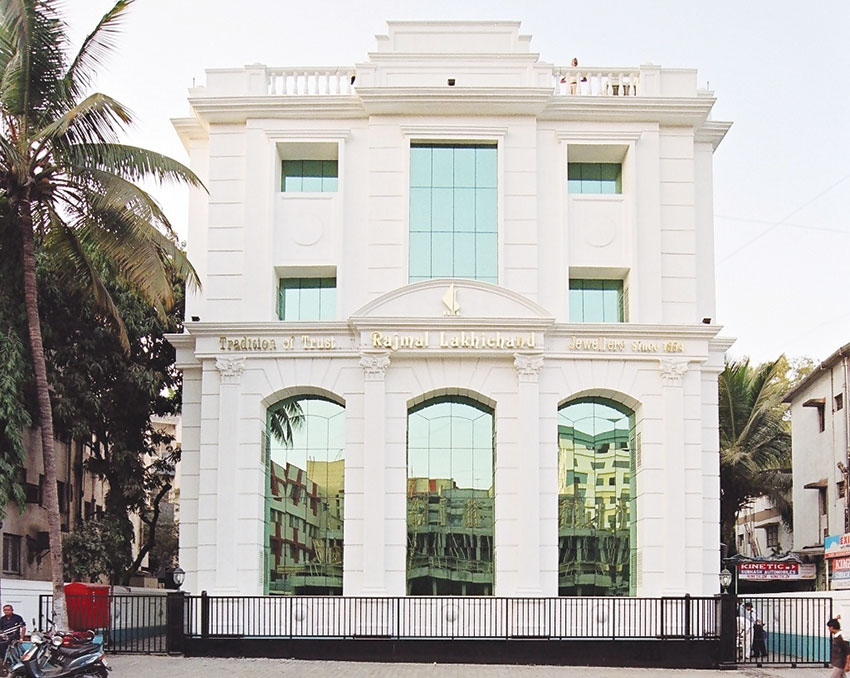
Front Elevation of Rajmal Lakhichand jewelers, Pune
Rajmal Lakhichand Jewellers located in Pune boasts of classical architecture with its huge arches. The building offers much more than mere exterior décor, the interior has been worked out with great precision and detailing that is reflected at the entrance itself. The floor is highlighted by a dancing peacock inlayed with lapis lazuli and malachite stones.
 |
|
| Display of "Gold "jewellery- Rajmal Lakhichand jewelers, Pune | Display of "silver "jewellery- Rajmal Lakhichand jewelers, Pune |
| At a Glance | |
| Project Name: | Rajmal Lakhichand Jewellers |
| Location: | Pune |
| Architect: | Ahmed Shaikh |
The showroom is divided into three floors each designed specifically to enhance the beauty of the products that are on display. One such floor is 'NAYAB' where one of a kind designer NAYAB jewellery sets are displayed. The grandness of the room is glorified by a magnificent hammered glass dome encircled by silver leafing. The jewellery is displayed in well-lit showcases which have been further emphasized by hand carved wooden arches. The Italian marble lay as Bisazza flooring and the intricate marble stone statue carvings enhance the richness and grandeur of the showroom.
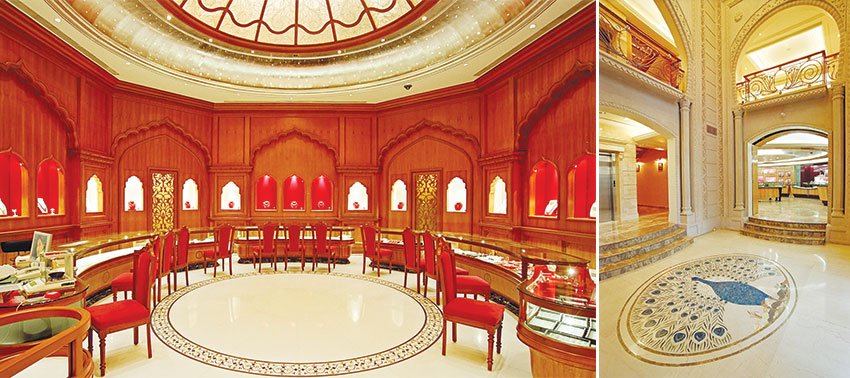 |
|
| Interior view of "NAYAB" - Rajmal Lakhichand jewelers, Pune | Dancing peacock inlayed with lapis lazuli and malachite stones. – Rajmal Lakhichand jewelers, Pune |
The décor of the place has an influence on the customer. It mentally elevates the visitors and influences them and creates a feeling of self-indulgence leading one to spend more time in the store and appreciate what is on display.

